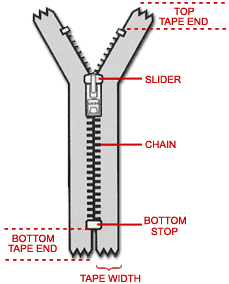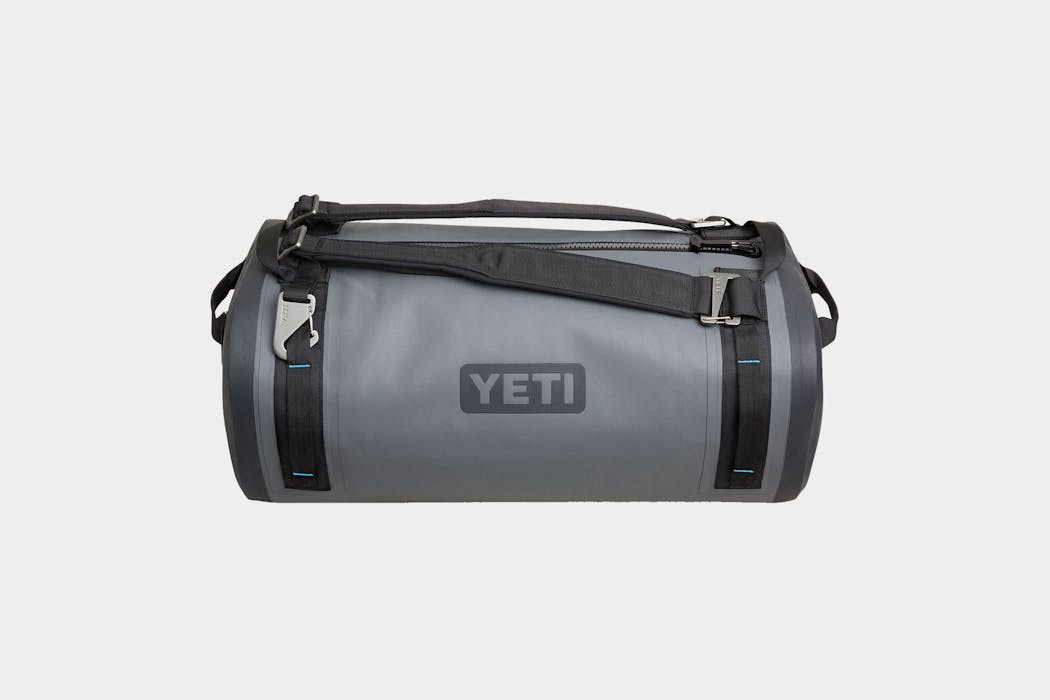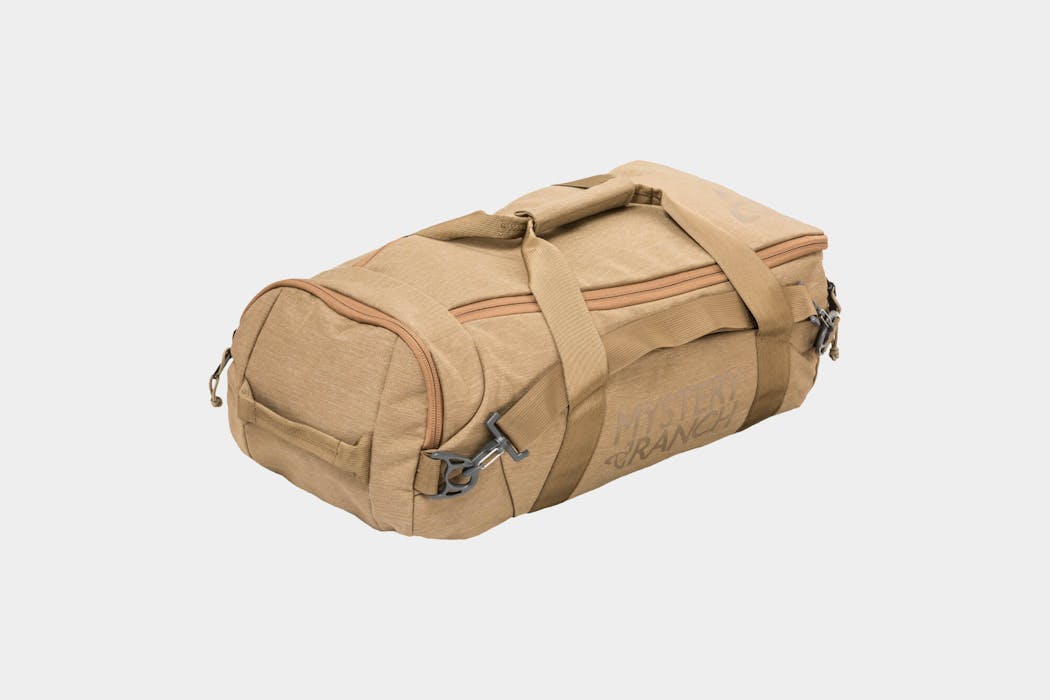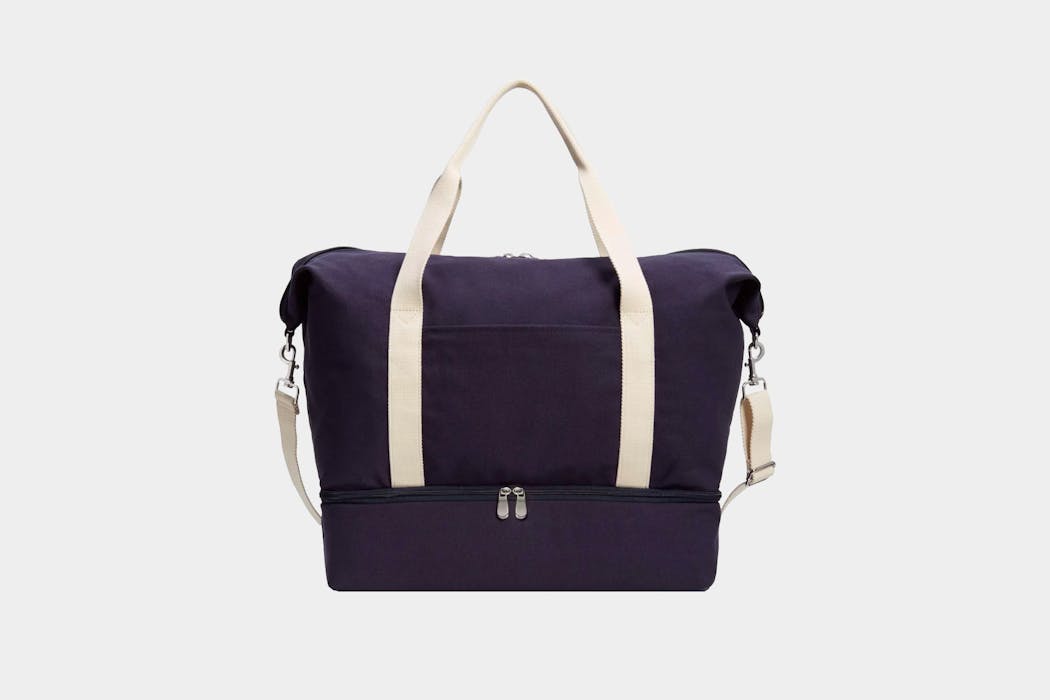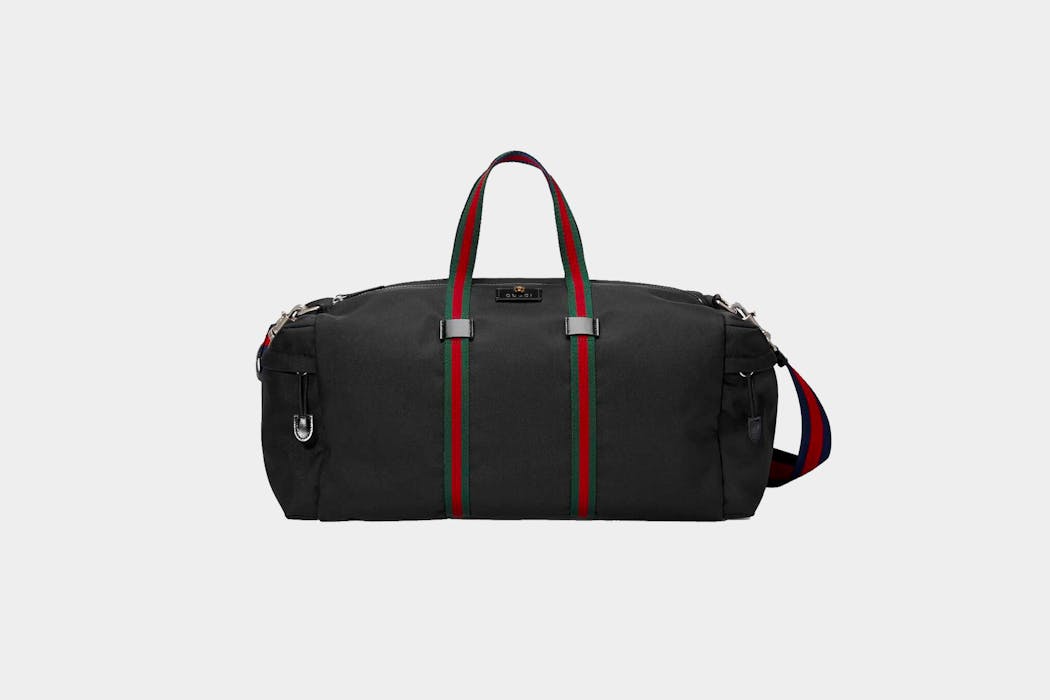KNOWLEDGE OF BAG
-
BACKPACK
When we think of backpacks, the first thing that comes to mind is usually a hiker or someone in the great outdoors carrying an oversized bag. Although this is a common use for the backpack, there are actually many different types available today so that you can find one specifically made for your needs.
Framed Backpacks
Those backpacks that have a frame, be it any sort, tend to provide more support to the back and not load the back much. It helps to evenly distribute the load all over the skeleton, without affecting the posture of the traveller.
Hence, backpacks with frames form a part of those used to carry a load heavier than about 14 kilograms to 15 kilograms.
The cost of such bags is definitely more than the frameless ones and the durability too is longer.
These bags are made of tougher material, to sustain load and abrasion caused during travels.
Frameless Backpacks
Backpacks without a frame are mostly used as day packs and for light travel.
They simply have shoulder straps attached to the bag. Some also have additional enhancements like padded shoulder straps, chest straps, cordage straps and a padded back.
They are not as expensive as those with frames. One can be assured that these daypacks are way lighter than those with frames. These are mostly made of polyester and are brightly coloured.
Hiking Backpack
These rugged backpacks have been made to withstand the conditions of the great outdoors, whether it’s freezing cold or pouring rain. A hiking backpack is usually larger than others because it has to carry so much gear, often enough for a camping trip as well.
The hiking backpack has many compartments to keep everything stored away for easy access and protection, but it also needs to be comfortable as it will be carried all day long.
Laptop Backpack
The laptop backpack is a hybrid of two different things: the laptop bag and the backpack. These feature a slot, pocket or compartment for your laptop to be stored in and usually have padding or protection keeping it safe from damage. These bags feature room for other items so they’re not just for laptops, and are used by professionals, students, and travelers.
Gym Backpack
A gym backpack is usually more lightweight and casual than other types because it holds softer items like towels and clothes. Gym backpacks can be found in breathable materials that are resistant to bacteria due to the sweaty nature of the garments inside. They might also be water resistant to protect against damp clothing or sweat.
Anti-Theft Backpack
This style of backpack can be used to describe any bag that has anti-theft features in place, designed to keep the belongings inside safe. One issue with wearing a backpack is that because of its placement you’re unable to see or feel someone opening it or tampering with it.
An anti-theft backpack uses things like locks, hidden zippers, secret pockets, and durable material that’s resistant to slashing in order to prevent theft.
Army Backpack
As the name suggests, these are military backpacks that have been designed for use by those in the armed forces. A military backpack might feature tactical gear like a quick release belt buckle, ski guides, and spaces for weaponry.
They are usually covered with a camouflage pattern and come in a variety of sizes and styles. Some people wear camo backpacks for leisure, made from a lighter canvas material.
Special Purpose Backpack
There is a range of backpacks designed for one specific purpose including travel backpacks or cyclist backpacks. They feature specific accessories and compartments to suit the owner and their activity and aren’t generally suitable for multipurpose use like a standard backpack is.
School Backpack
A school backpack comes in different shapes and sizes and might be suitable for young children to take to kindergarten through to adults studying at college. These are quite simple in design and may have space for a laptop, however, they are generally casual and lightweight when compared to other styles.
Backpacks can be quite simple in their design or come with many extra parts, so for the purpose of looking at the detailed anatomy we’re going to discuss a hiking backpack.


These are the parts you can expect to find on these backpacks and what purpose they serve the wearer.
-
Bag – The bag itself is where you hold your belongings and they come in various sizes and shapes. Some might have compartments and pockets built into the construction or be one large pocket itself. There are zips, buckles, and buttons in place to keep everything securely inside.
-
Shoulder Straps – These two straps go around your shoulders and help keep the backpack secured to your body. They can be thin and simple or thicker and cushioned, depending on your ergonomic needs and how much weight they carry.
-
Stabilizer Straps – This helps to make an adjustment to your center of gravity when wearing the back and is particularly useful for heavier loads. They can be tightened or loosened depending on the situation and will help keep the wearer stable and balanced.
-
Haul Strap – This is used to lift or lower the bag using a rope and is ideal for times when you have to climb mountains or other high places and can’t carry the bag on your back.
-
Compression Straps – When the bag isn’t all the way full you can use a compression strap to tighten everything and make the load more secure.
-
Sternum Strap – These are used to connect the two shoulder straps together and joins then at the sternum which keeps the bag closer to your body. It’s also used to prevent the shoulder straps from pulling your shoulders back and affecting your posture.
-
Lumbar Pad – This offers extra protection for your lumbar by giving a cushioned pad that rests against your lower back.
-
Hip Belt – Another strap used to transfer weight, this time moving it to your hip to help with overall stability and balance.
A good place to start is with the most basic parts of a backpack. These are the universal terms that can be applied to any backpack regardless of style.
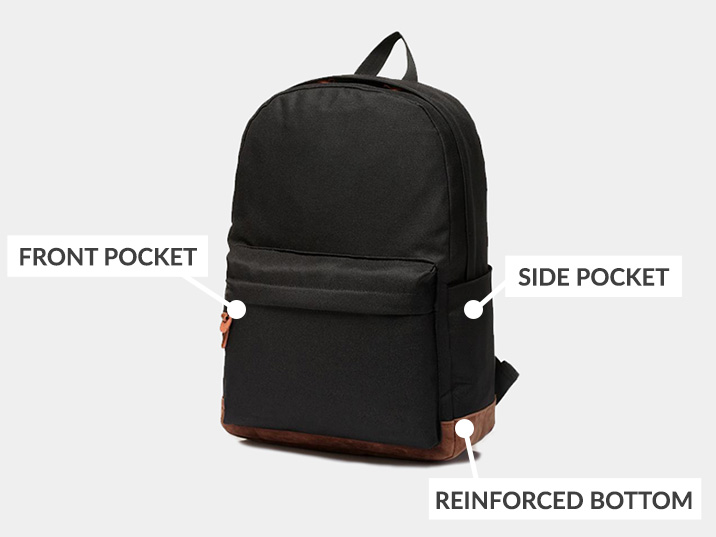

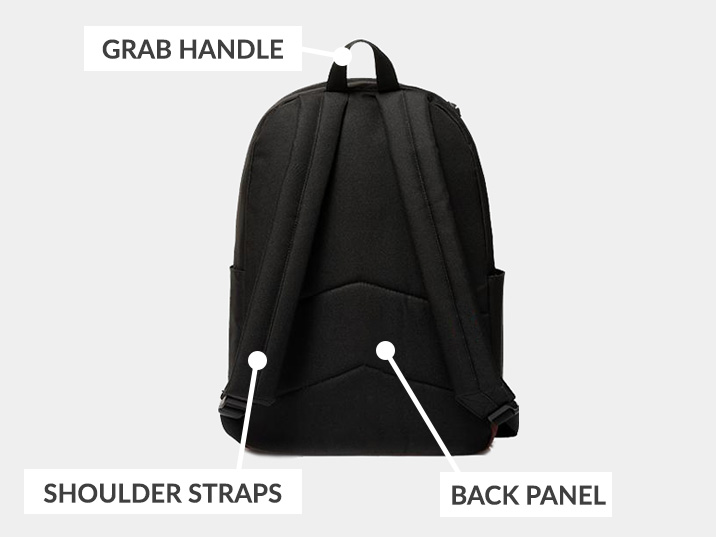



Anatomy of a backpack definitions
Backpack Straps Explained
Let’s take a closer look at the various backpack straps and how they affect your carry. While all backpacks have shoulder straps to enable the bag to be carried on your back, many large and heavy backpacks also include sternum straps and hip belts to help distribute weight. If you want to learn how to properly adjust your backpack’s straps for a proper fit please take a look at our 3 step guide on how to fit a backpack.

SHOULDER STRAPS
Shoulder straps help evenly distribute your load between both shoulders. Most shoulder straps are adjustable to help correctly position the backpack on your back. Width between shoulder straps also determines comfort. One of the main differences between men’s and women’s backpacks is the width between shoulder straps.
HIP BELT
Also sometimes referred to as a waist strap, a hip belt is a padded strap that goes around the top of your hip bone to help redistribute the backpack’s weight from your shoulders to your hip. Hip belts are most common in outdoor and travel backpacks that are designed to carry large and heavy loads.
STERNUM STRAP
The sternum strap, or chest strap, is a strap that clips across your chest to help alleviate strain from your shoulders. Think of it as a bridge between shoulder straps that improves the stability of the load. Sternum straps also help shoulder straps from sliding off your shoulder and prevents heavy backpacks from swaying back and forth when on the move.
Unlike hip belts that are usually reserved for travel and outdoor backpacks, sternum straps are also common with many daily carry backpacks that are meant for heavier loads such as school book bags.
Types of Backpack Shoulder Straps
Shoulder straps come in a few different flavors with each being better suited for a specific style of carry. When choosing a new backpack it’s important to pay attention to the style of shoulder straps in order to determine if the backpack will fit your needs. Below are the three most common types of backpack shoulder straps.

1. STRAIGHT
Straight shoulder straps are most common in fashion backpacks where long term wear of heavy loads isn’t a priority. Most bag manufacturers design straight shoulder straps to be adjustable so you can position the backpack on your back where it’s comfortable but that’s about where the ergonomic features end.
Although padding is typical, it’s also common to see straight shoulder straps made out of single pieces of nylon, canvas or leather and without any padding. Again, this style definitely puts more emphasis on looks than comfort so it’s best to avoid straight shoulder straps on heavy use backpacks.
Example: MIS Backpack (Gallantry)
2. CURVED
Curved backpack shoulder straps are designed to mimic the shape of your body for a more ergonomic fit. It’s common to see advanced padding and materials such as EVA foam, dual density foam and mesh lining for breathability paired with curved backpack straps to maximize the comfort of the backpack. Curved straps allow for comfortable long term wear of heavy loads. Because of this you’ll notice curved shoulder straps the most in travel, outdoor and laptop backpacks.
Example: Under Armour Undeniable 3.0 Backpack (Amazon)
3. ONE-PIECE
One-piece backpack shoulder straps are easy to spot because both shoulder straps are (you guessed it) made of one piece of material and connected to a “bridge” at the top of the backpack. Some one-piece shoulder straps are designed so that the bridge portion of the backpack straps also act as a grab handle.
There are two things to consider when choosing a backpack with one-piece shoulder straps. First, you can’t wear the backpack too high on your back or else the bridge will start cutting into your neck and shoulders. Second, the shoulder strap width is completely fixed with one-piece shoulder straps so it’s important that you know how the backpack fits before you commit to wearing it. You’ll notice this type of backpack shoulder strap a lot in travel daypacks and outdoor backpacks where fit matters.
Example: Osprey Daylite Daypack (Osprey)
Types of Access and Opening Styles
When we talk about “types of access” we are describing the different ways you can enter a main compartment to get to your stuff. It’s important to note that the best type of access changes with the purpose of the backpack.
An example would be choosing the best backpack to wear for bicycling to work in a rainy city. Going with a rolltop backpack would be a good choice since rolltops are more water resistant than regular zippers.
There are dozens of main compartment access designs but here are some of the most common.

1. TOP ACCESS
Backpacks with top access allow you enter the main compartment from the top of the bag. Most backpacks with top access have what is called a lid which is the top piece of the backpack that allows you to zipper or buckle the backpack shut. While many backpacks with lids are zippered shut, others can also be cinched with a drawstring or buckled shut as outlined below.
Example: Under Armour Undeniable 3.0 Backpack (Amazon)
2. FRONT ACCESS
Some backpacks include front zipper access to the main compartment in addition to or in lieu of top access. Front access backpacks have grown in popularity with gym and travel backpacks that are used for storing clothing in the main compartment. Front access allows the backpacks to be opened up like a traditional duffel bag when in use.
Example: Aer Fit Pack 2 (Gallantry)
3. SIDE ACCESS
Side access allows for entry into the main compartment through the side of the bag. This is usually in addition to another form of entry. Side access is popular with photography backpacks for faster access to cameras and lenses. The style allows the wearer to sling the backpack to the front of their body and access the main compartment without having to take off the backpack.
Example: Peak Design Everyday Backpack (Gallantry)

4. DRAWSTRING
Drawstring openings use a cord to tighten and cinch the backpack shut instead of a zipper or buckle. This type of backpack opening style is almost exclusively used with top access backpacks and are commonly paired with a lid to cover the drawstring. Drawstring enclosures are often seen in rucksacks so that oversized items such as sleeping bags and tents can fit inside the main compartment vertically without having to close the backpack.
Example: Herschel Little America (Amazon)
5. ROLLTOP
Rolltop backpacks feature extra fabric on the top of the bag that you “roll” and compress to close. Rolltop backpacks do a better job a waterproofing the inside of a bag when compared to a zipper or drawstring opening and are popular with outdoor backpacks because of this.
Another feature of rolltop backpacks is the ability to compress or expand the main compartment as needed. Much like drawstring backpacks, this allows you to fit oversized items vertically into the main compartment.
Example: WANDRD PRVKE (WANDRD)
6. Y-ACCESS / 3-ZIP
Y-Access or “3-Zip” entry gives you the option of either entering the bag from the top or having full access to the main compartment through the front. This style of entry was popularized by Mystery Ranch with their 3-Zip design packs. This is a good access style for tactical and travel packs where accessing the entire main compartment is important.
Example: Mystery Ranch Urban Assault Backpack (Mystery Ranch)

7. SPLAYED
Popular with work and tech backpacks that have multiple large compartments, splayed openings allow each compartment to fan out when unzipped for easy access to the contents inside. This style of access is great for organization and is a good fit for anyone who needs to carry things like a laptop, files and books in independent compartments.
Example: Tumi Sheppard Brief Pack (Amazon)
8. CLAMSHELL
Clamshell openings feature zippers on three sides and a single attached side that acts as a hinge. This type of opening is preferred in backpacks where accessing the contents of the main compartment at once is important. Notable examples are tactical field bags, clothing compartments in travel bags and backpacks with lots of pockets lining the main compartment walls. Any backpack that opens like a suitcase can also be considered clamshell.
Example: Cannae Pro Gear Legion Day Pack (Amazon)
Loops and Attachments Explained
You may have noticed that many backpacks have a variety loops, straps and elastic cord attached to the outside. Although most of these elements find their origins in outdoor bags for hiking, rock climbing and snow sports they have seemed to creep their way into everyday backpacks for work, school and commuting.
Let’s take a look at some of the most common backpack loops and attachments and explain their purpose so you can finally answer the burning question what are the loops on my backpack for?

1. LASH TAB
Lash tabs, also known as “pig snouts” are small leather patches usually found on the front of a backpack. These patches are attachment points for gear such as velcro straps, carabiners and bike lights. The most common shape of a lash tab is in the form of a tilted square or diamond shape but lash tabs can come in a variety of shapes and sizes. It’s most defining feature is two skinny slits that makes it resemble a pig’s snout.
While lash tabs were originally only found on outdoor bags, it’s now common to see lash tabs on everything from designer backpacks to school book bags as a decoration. It’s also common to see lash tabs made out of rubber or plastic for increased durability or water resistance.
Example: Herschel Supply Co. Heritage Backpack (Amazon)
2. GEAR LOOPS
Gear loops are common with outdoor backpacks used for climbing, backpacking and camping. Their original purpose is to attach long items such as ice picks, axes and trekking poles but they can also be used as a general attachment loop for anything from carabiners to rock climbing quick draws. Gear loops are commonly made of straps of nylon material that form a closed loop and are sewed into the body or waist belt of a backpack.
Much like lash tabs, gear loops can be sometimes found in fashion backpacks to give it an outdoor-inspired aesthetic.
Example: Topo Designs Daypack (Gallantry)
3. TIE OUT LOOPS AND ELASTIC CORD
Tie out loops are small fabric loops that are sewn on to the sides or front of a backpack. They are just big enough to loop through elastic or bungee cord so that you can configure your own external attachment setup. Some backpacks only come with tie out loops while others come with an elastic cord already looped through.
The purpose of the elastic cord is so that it can be cinched down for secure attachment of anything that is too large or bulky to fit inside of the backpack such as a jacket, bike helmet or extra gear.
Example: North Face Borealis (Amazon)

4. COMPRESSION STRAPS
Normally found on the side of a backpack, compression straps are used to compress or expand the bag’s size. Compression straps are common in backpacks that are designed to hold a lot of weight such as hiking backpacks, travel backpacks and some school book bags because they allow for the backpack to be squeezed closer to your back for better weight distribution and a more comfortable carry.
Example: Osprey Daylite Plus Daypack (Osprey)
5. REAR LOADING STRAPS
Rear loading straps are two straps found at the bottom of a backpack that can be used for securing items that are too large to fit inside the main compartment. Mostly found in outdoor backpacks, the straps are used for securing items such as blankets or sleeping bags. Sometimes you will also find rear loading straps on specialty backpacks such as camera bags for attaching gear like tripods and light stands.
Example: Timbuk2 The Authority Pack (Amazon)
6. SKATEBOARD STRAPS
Skateboard straps or “skate straps” are two large straps that are horizontally placed on the front of a backpack for the purpose of carrying a skateboard. The straps themselves are usually attached with clips or velcro to secure a skateboard deck onto the front of the backpack. Backpacks with skateboard straps are usually a lot less outdoorsy and instead focus on everyday carry for school or urban carry.
Example: Dakine Duel Backpack (Amazon)
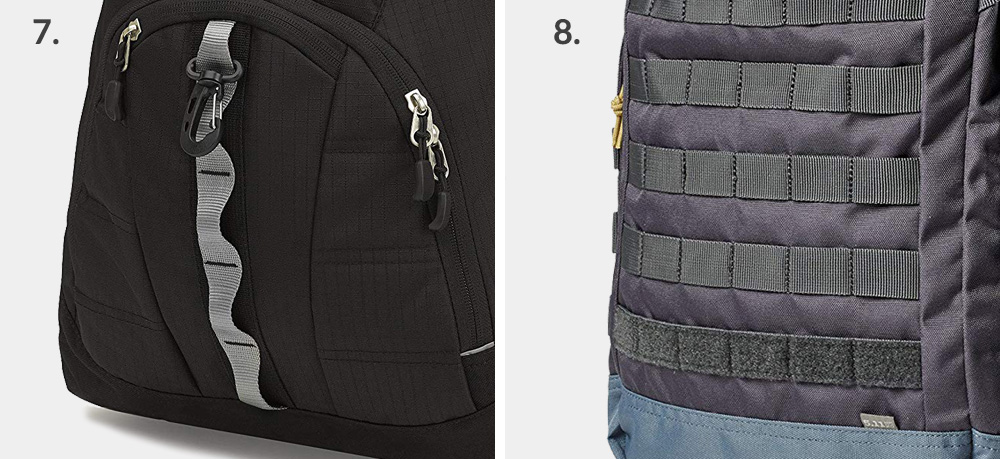
7. DAISY CHAINS
Usually made of nylon webbing sewed into the backpack to create loops, daisy chains allow for things like carabiners, clips and external pouches to be attached to the outside of the backpack for extra storage. Daisy chains are mostly found in outdoor backpacks where external gear attachments are important but they can also be found in daily carry backpacks as a design accessory. Daisy chains are commonly found on the front and side of a backpack or on the shoulder straps.
Example: High Sierra Access II (Amazon)
8. MOLLE / PALS
MOLLE stands for “modular lightweight load-carrying equipment” and much like a daisy chain it is made of nylon webbing that is sewed into the backpack to create attachment points. Multiple MOLLE rows create a system called PALS which stands for “pouch attachment ladder system” and allows for a variety of attachments such as external gear pouches, canteen carriers and firearm magazine pouches to be attached to the outside of the backpack.
Although originally designed for tactical bags and gear, it’s not uncommon to see MOLLE webbing on fitness, travel and everyday backpacks that want to take advantage of this useful external attachment system.
Example: 5.11 Tactical Rapid Origin Pack (5.11)
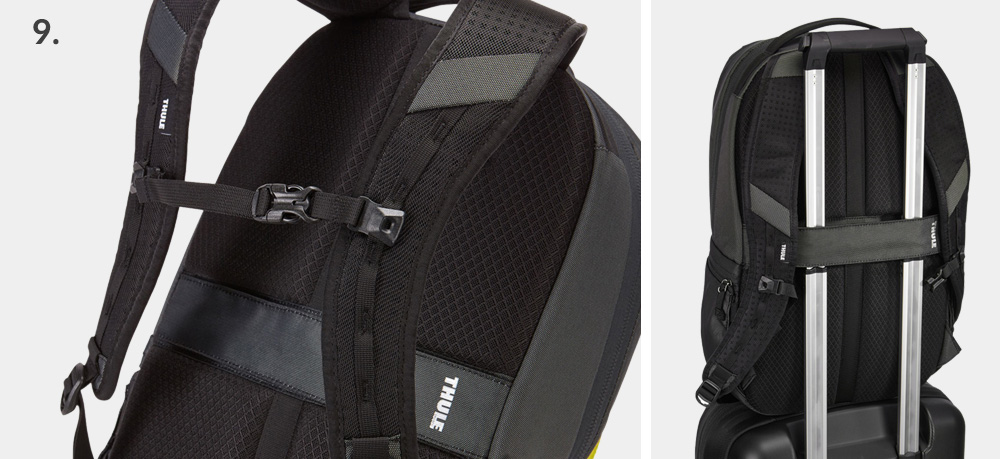
9. TROLLEY SLEEVE
Have you ever noticed a sleeve or strap on the back of your backpack? It has a few names; trolley sleeve, luggage pass through sleeve, luggage slide over and its purpose is so that you can attach your backpack to the handles of your suitcase when traveling. It’s a neat feature that has grown in popularity with travel and business backpacks.
Example: Thule Subterra Backpack (Amazon)
Backpack frames and sheets
The purpose of a frame is to take the weight of a backpack’s load and help distribute it down to the hip belt. This is why backpack frames are usually reserved for technical outdoor backpacks that are made for carrying large bulky loads over long periods of time. For smaller bags such as daypacks, tactical and travel backpacks you are more likely to encounter frame sheets. Your typical daily carry backpacks are likely to have nothing at all.
Now let’s go over the difference.
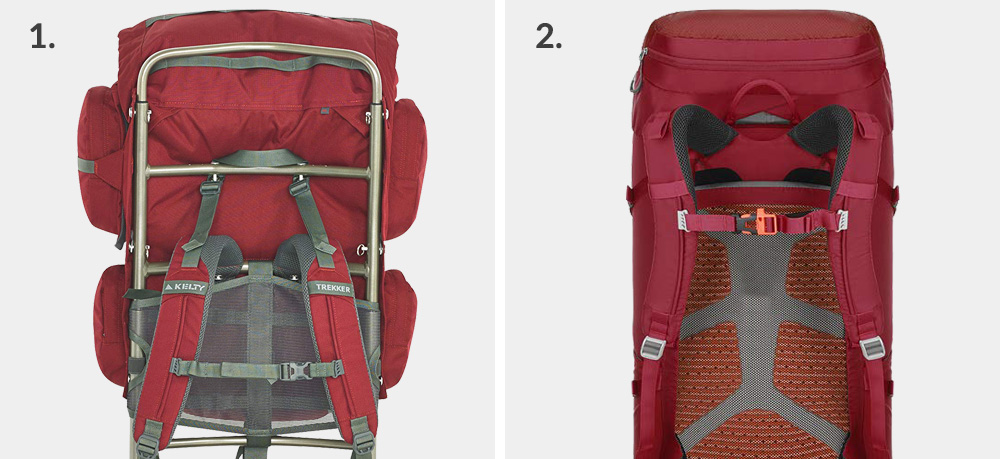
1. EXTERNAL FRAME
External frames became popular in the 1960’s as a way to help carry heavy and uneven loads in outdoor and military backpacks. These frames are usually made of aluminum tubing that allow for large and uneven items to be carried. When paired with a hip belt, an external frame transfers the load weight to the hips for better stability and balance. External frames also offer amazing ventilation because of the air pocket between your back and the backpack that the frame creates.
Example: Kelty Trekker Hiking Backpack (Amazon)
2. INTERNAL FRAME
A majority of today’s framed outdoor backpacks feature an internal frame. Unlike an external frame, internal frames are embedded into the backpack and the backpack will rest directly onto your back when worn.
Internal frames allows the backpack to retain its shape even when stuffed full for the proper distribution of weight and more stability under load. Modern internal frames vary in material, shape and size. Some are body-hugging fiberglass sheets that mimic the curves of your back while others are just aluminum stays that help keep the backpack’s shape.
Example: Gonex Internal Frame Hiking Backpack (Amazon)

3. FRAME SHEETS
A frame sheet is a single piece of plastic that rests behind the back panel to keep the bag’s shape when worn. While most of the time a frame sheet is permanently embedded into a backpack, some brands allow you to remove or replace the frame sheet as needed.
The idea behind a frame sheet is to prevent the back panel from rounding when the backpack is stuffed full. To prevent this, a stiff frame sheet is placed against the back panel so that the backpack can rest correctly on the back when worn. This prevent stress on the shoulders and a more even weight distribution overall. Frame sheets are popular with backpacks that are made for carrying heavier loads such as tactical, outdoor and travel backpacks.
Example: Tom Bihn Synapse 25 with removable frame sheet (Tom Bihn)
4. FRAMELESS BACKPACK
Most daily use backpacks are frameless backpacks. These are packs without any sort of frame whatsoever. You’ll know you have a frameless backpack when you can bend and fold the back panel with ease. Most frameless backpacks simply have mesh or padding on their back panels for comfort and weight distribution.
Example: Herschel Supply Co. Settlement Backpack (Amazon)

Look Ma, I can name all the parts of a backpack!
That concludes our anatomy of a backpack guide. Hopefully you have learned something fancy and new that you can apply to your next backpack purchase.
For the past year we have been bombarding you with our opinions of backpacks — what makes each one great and what needs improvement. So maybe you have picked up what all the different parts of a backpack are or what we call them. Many are pretty self-explanatory, but if you come across an occasional term that you’ve never heard of, don’t worry. We might have just made it up.
So… what are all the parts of a backpack?! We present what we believe is a fairly comprehensive list. Maybe we should have written this post a year ago, but better late than never?
The below post outlines:
- The compartments (including opening style, access point, and other types of pockets)
- Types of straps
- Additional features and add-ons
- The hardware (zippers, buckles, etc)
COMPARTMENTS
Opening style
There are a few types of backpack openings that you commonly see. Aside from the normal zipped opening, which runs from the midpoint of one side, over the top, to the midpoint of the other side, you will often read about clamshell openings, splayed openings, roll-tops, drawstrings, and lids.
- Clamshell backpacks open like… clamshells. Three sides can be upzipped, leaving one side to act like a hinge. Another name for this is suit-case style opening since the panel can lay flat. You’ll most often see this on travel bags or backpacks of larger capacity.
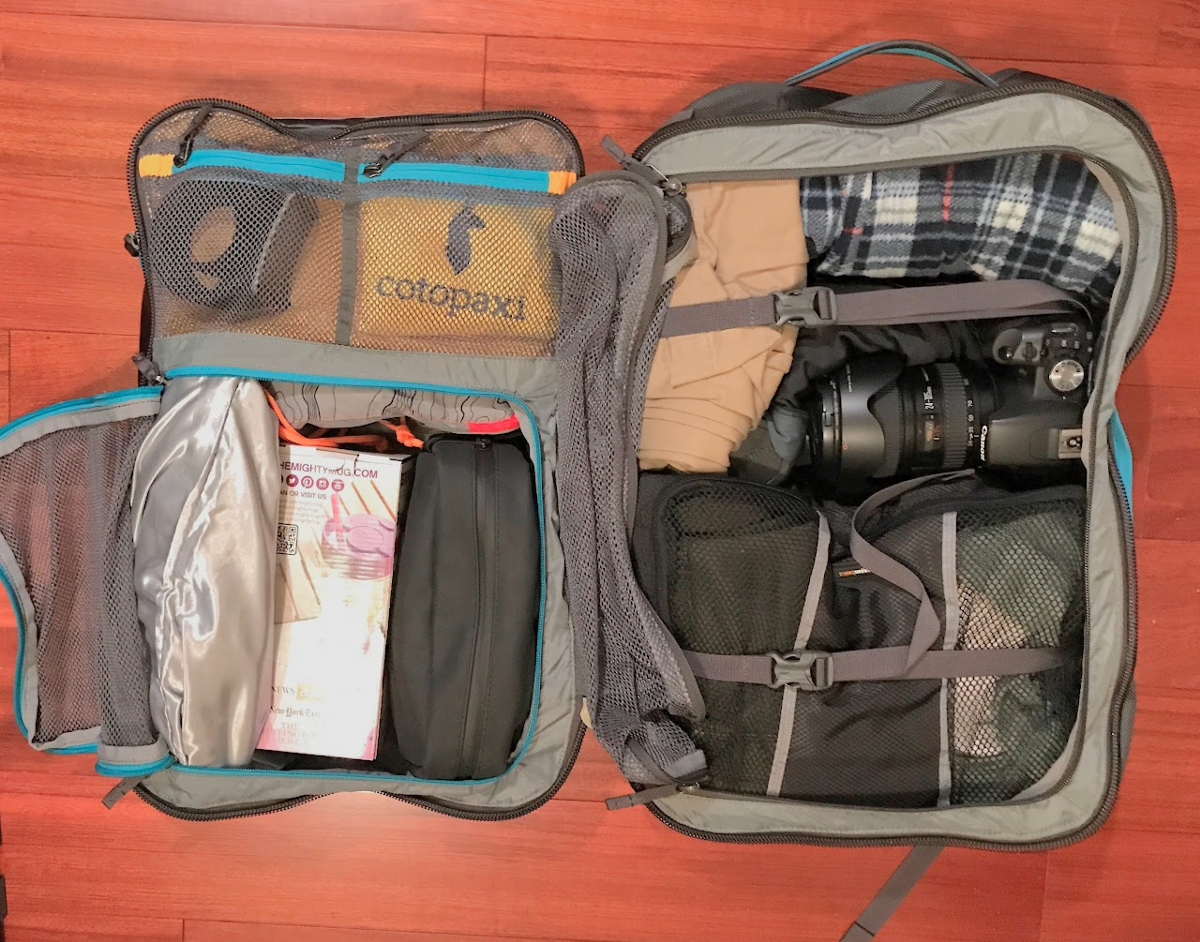

- Splayed openings are very similar to clamshell/suitcase openings except that they may not necessarily open all the way. You’ll see this often in techy backpacks — the splayed opening allows you to open a hard-shelled backpack. Some backpacks have a splayed opening that can be converted to clamshell.
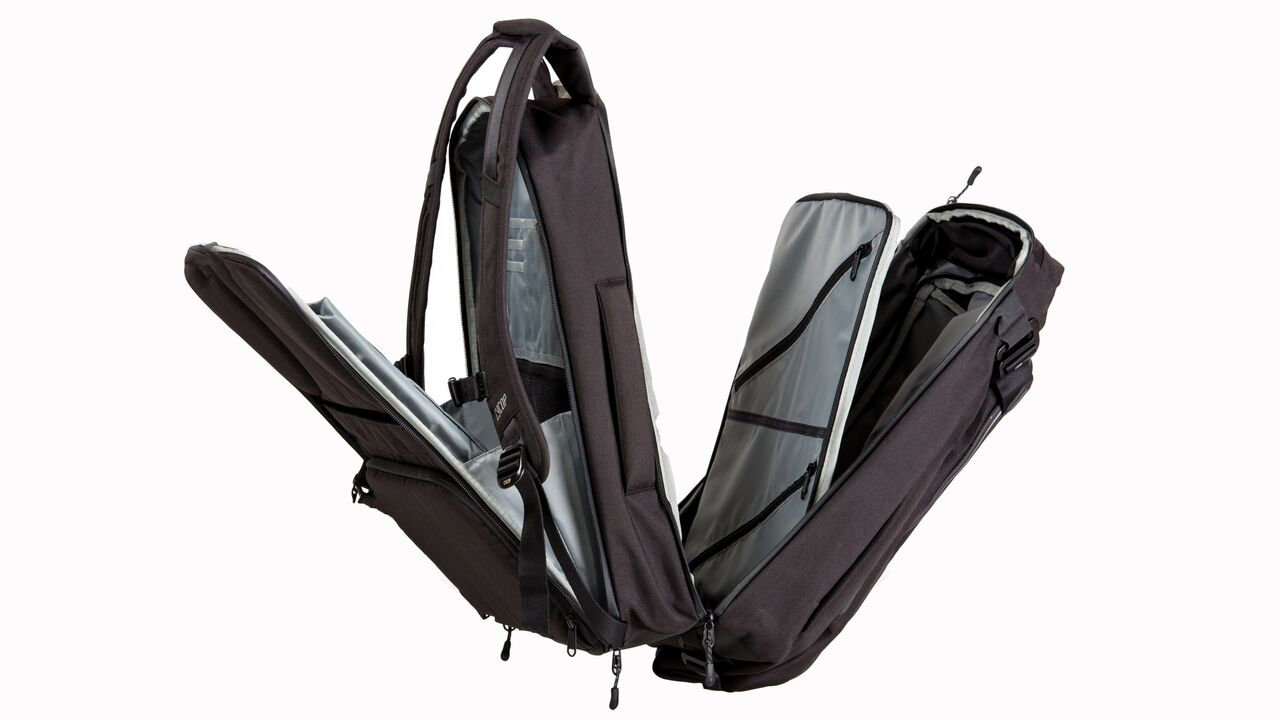

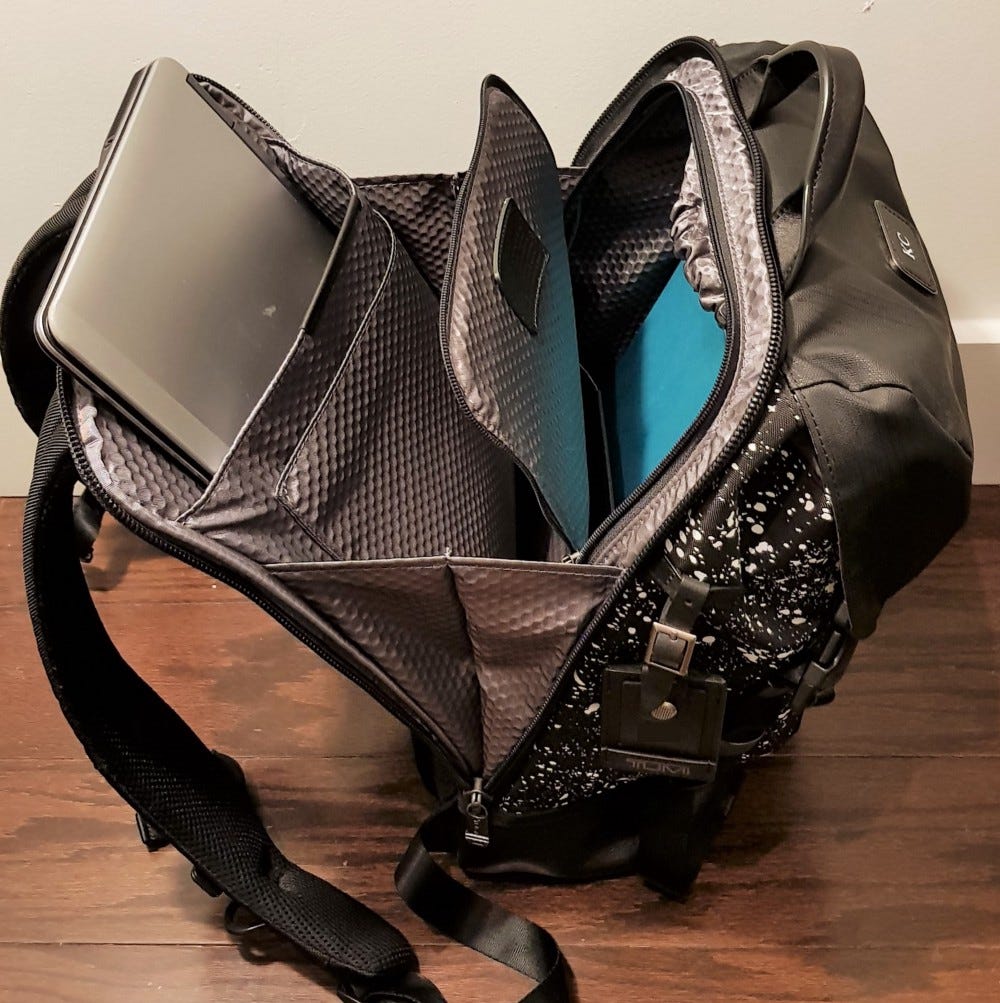
- Roll-tops are tops that… roll down. Once rolled, these openings are usually held down by buckles or hooks on both sides. The benefit of these are that they allow you to expand the volume of the backpack upwards and are also more effective at keeping water out than zippers. Hence camping dry sacks are roll-tops. On the downside, they are not as convenient to open and close as zippers.


- Drawstring tops (or cinch cord) are tightened via a string that can be clamped to hold the opening closed. These are common in large trekking backpacks because they can open very wide to allow you to fit large items like tents and sleeping bags inside. They’re often accompanied by a lid.
- Lids (also informally called “brains” if the lid has pocketing with its own volume) refer to what is literally a cap that sits on the top of the backpack. Many trekking backpacks have this as a floating lid that provide a cap over drawstring openings to keep water out and are buckled down. Smaller backpacks with lids often use zippers instead.
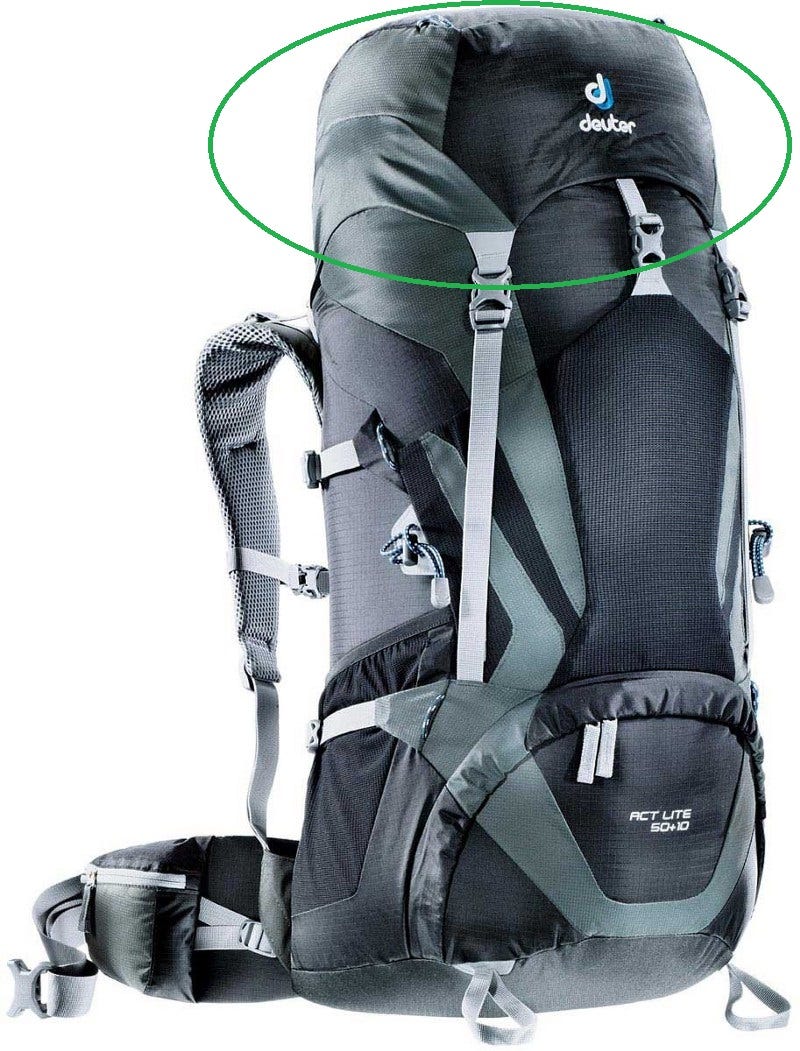

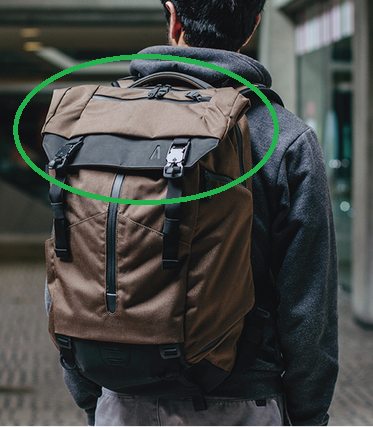
- Central zipper — Some newer bags have a more unique design with zippers that open down the middle of the backpack’s front face. This reduces the amount you need to unzip and opens up the bottom of the bag, allowing you to access contents near the bottom.



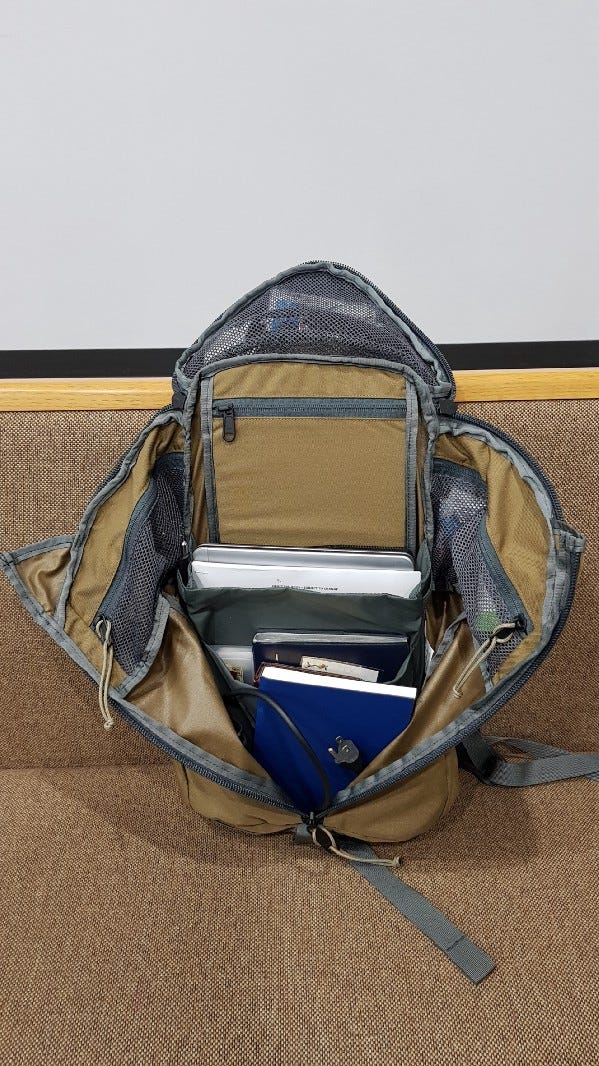
Access
The most common access point seen in backpacks is through the top of the bag. While this has the benefit of being the easiest to load, since you can stand the backpack upright or lay it down on its front or back, it also means that if you want to reach anything at the bottom, you’ll need to get through everything on top.
Alternatively, many trekking backpacks also have access points at the bottom allowing you to retrieve items at the bottom or middle of a fully packed bag without having to take everything out (e.g. Wanaka Adventure Pack and Alpaka Shift Pack). This is particularly useful for camping/trekking since there are very specific ways to pack your items based on weight.
Certain special-use backpacks also have side access zippers, such as the Boundary Prima. These allow you to swing the backpack on one shoulder to your front and access items in the main compartment. It’s a convenience feature and useful for quick access.
A last common access style seen is the back panel access, such as on the NYA-EVO Fjord36 or the Bobby Anti-theft backpack. Back panel access is usually meant for special uses or designs such as camera bags in the case of the Fjord36 or anti-theft features in the case of the Bobby.



Other pockets
- Kangaroo pockets are elastic pouches that are frequently seen on the front face of hiking backpacks. They usually aren’t secured by zippers or other hardware but are a really easy and quick place to stow small items or relatively flat items like a shovel. They’re often stretchy so jackets can also be stowed there.
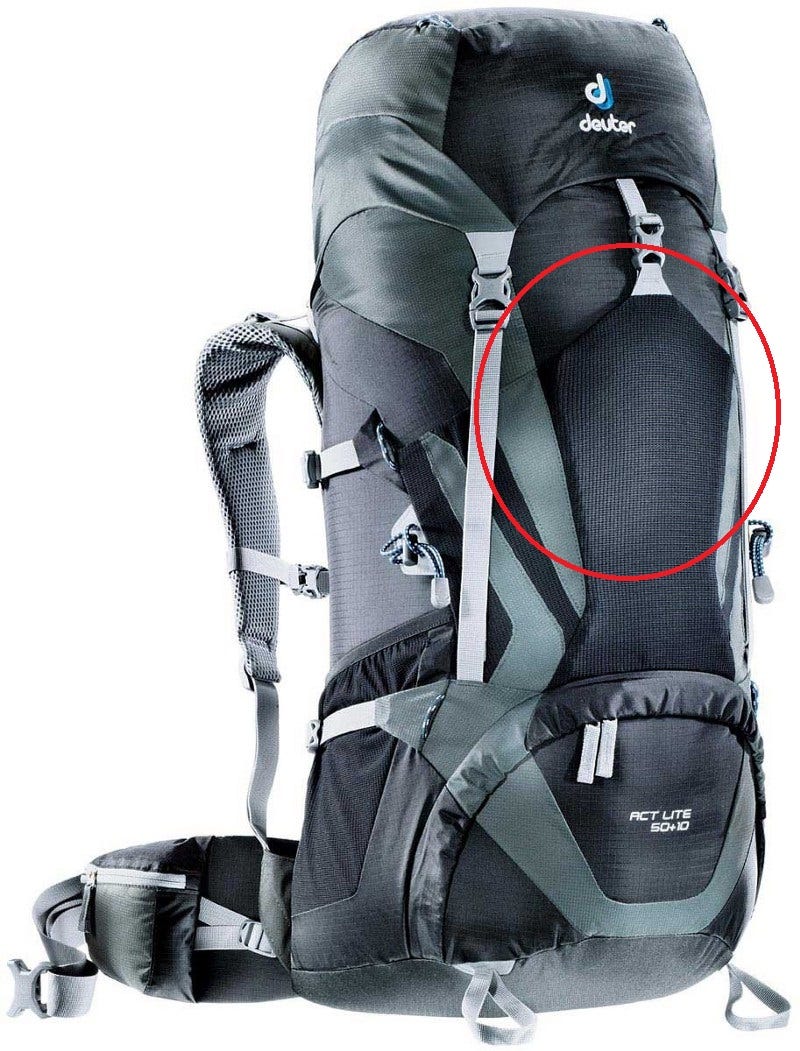
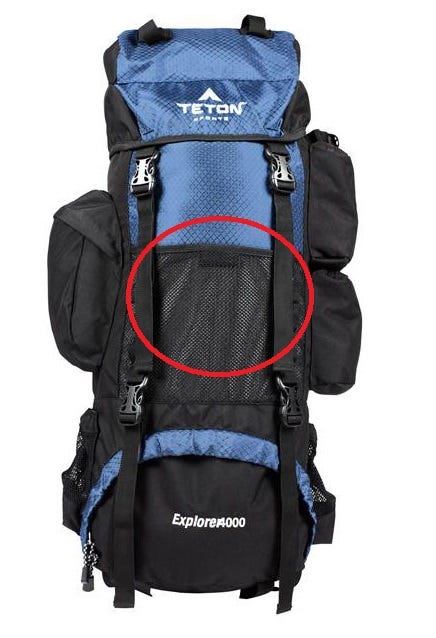
- Hydration sleeves hold your water bladders or pouches and are usually accompanied by some sort of port that allows you to thread the bladder’s tube out of the bag and a clip on the shoulder strap to hold it in place.
- Tech sleeves / Laptop sleeves are pretty self-explanatory and these days they are a staple for any EDC bag. One thing to look out for in the laptop sleeves is whether or not the laptop will have any padding on the bottom of the bag or if it’s suspended from the bottom.
STRAPS
You can check out our guide on Shoulder Straps to get the details on shoulder straps, sternum straps, and load-lifter straps.
Sternum straps help disperse the weight of the backpack off your shoulders a little bit, but not very much. It’s main purpose is to prevent the shoulder straps from sliding off your arms when moving around and to tug them inward a bit so your arms can move freely.
Load-lifter (or sometimes called stabilizer) straps also relieve your shoulders from some of the weight of the backpack by bringing the bag forward to bring the center of mass inward.
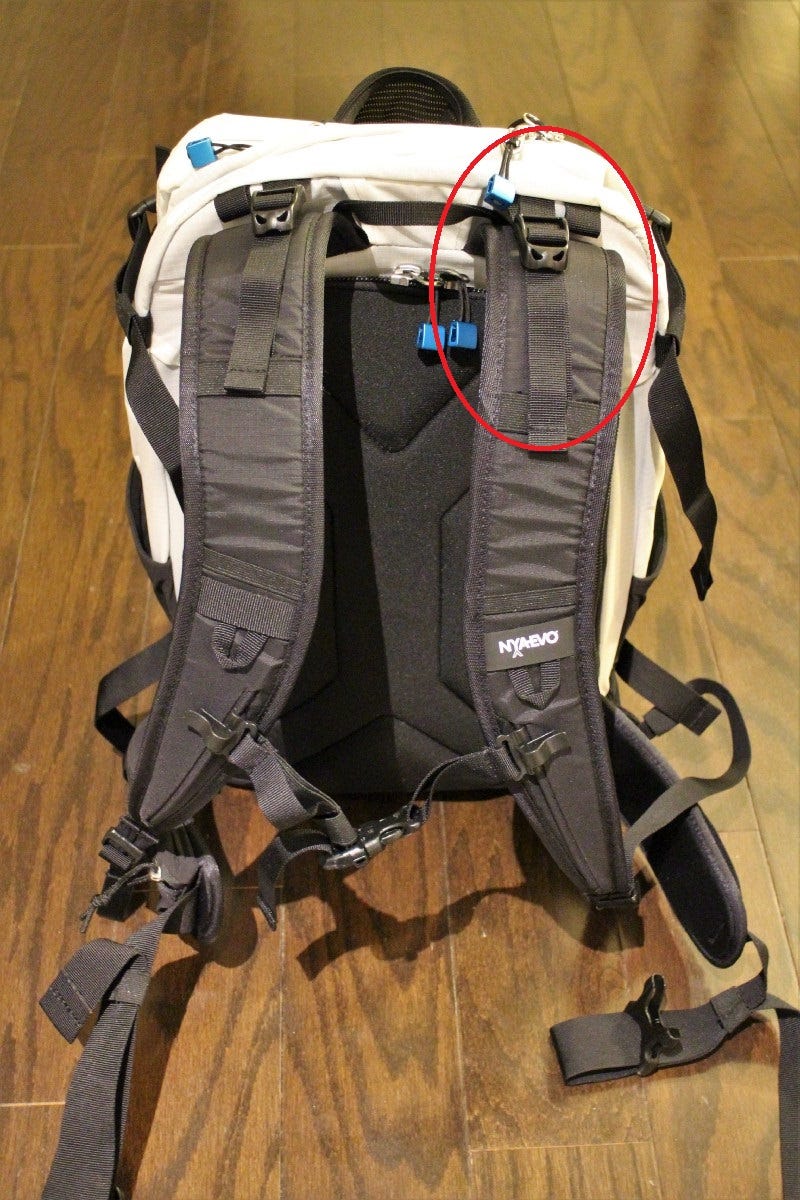
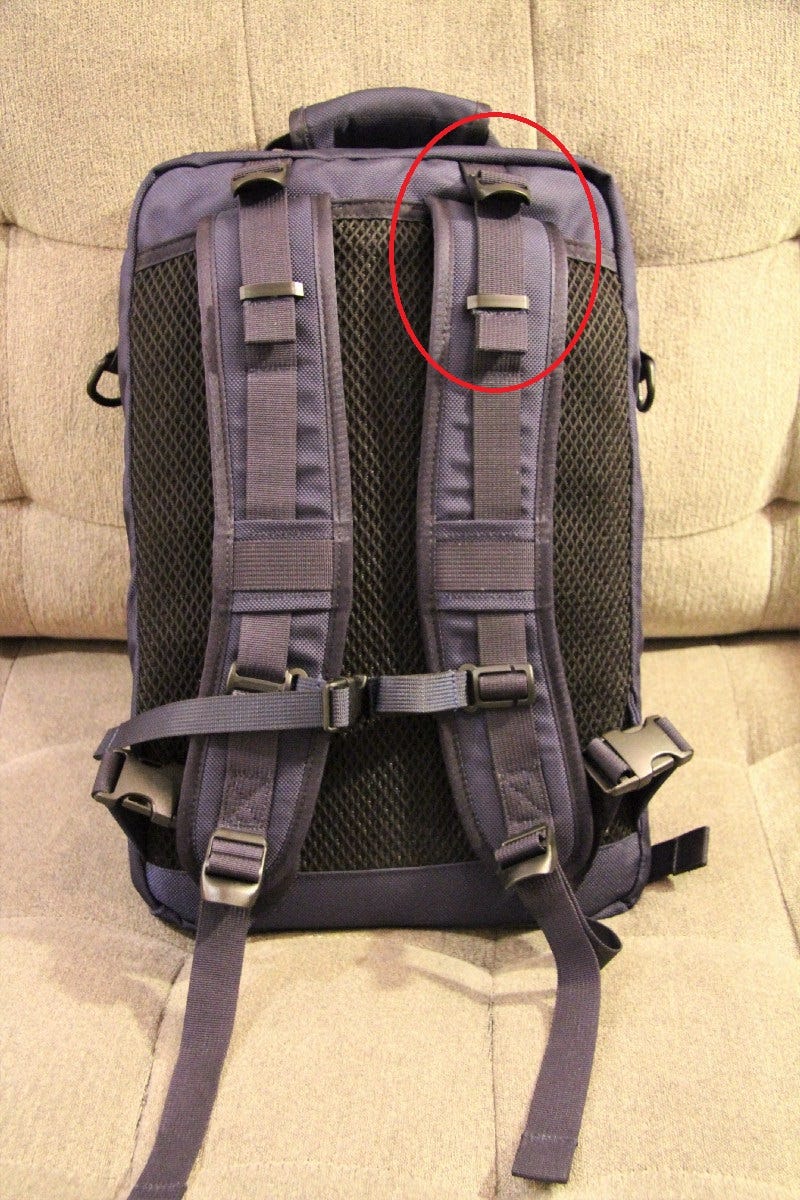

Aside from these, everyone is also very familiar with the waist / hip belt, which is also used to relieve your back from the weight of the pack. Ideally, the waist belt should be padded and sit directly on the top of your hip bones or just above it. Theoretically, the waist belt can also handle the entire weight of the backpack (e.g., if you have a waist belt securely fastened, you can take the shoulder straps off and the bag should still be held against your body by the waist belt). Small waist belts that have no padding and are just pieces of nylon webbing and keep the bag from swinging around (i.e. stabilization) and don’t offer much in terms of weight distribution.
Additional stabilizer straps can sometimes be found on the waist belt. Similar to the load-lifter straps, these straps pull the backpack closer to you (in this case they pull the bottom of the back closer to your butt) to improve balance by bringing the center of gravity closer to where it would naturally be if you weren’t wearing a backpack.
ADD-ONS
Here are a bunch of additional features commonly seen on backpacks! Some are pretty self-explanatory…
Pig snout (lash point) — Those square/diamond-shaped patches with two-slits in them? They have a purpose! These are lash points and allow you to tie items to the outside of your backpack or hook up a carabiner. Remind you of a certain animal’s nose?

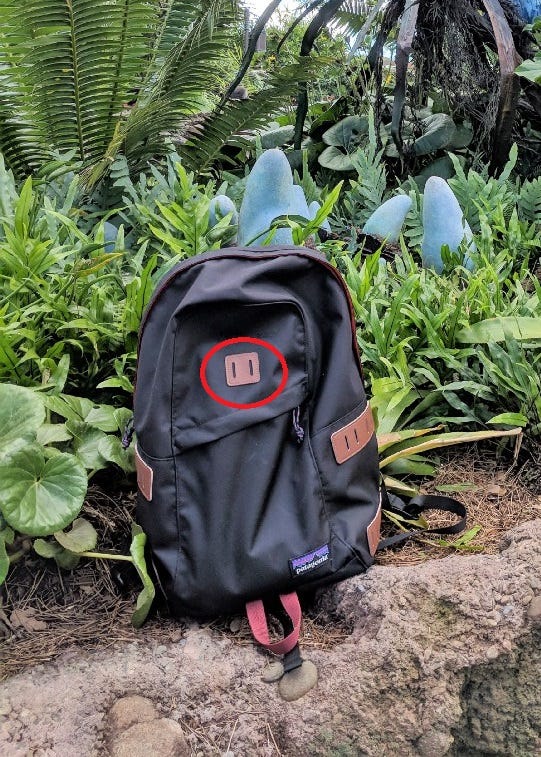

Grab handles / haul straps — Typically, a backpack will have some sort of handle at the top between the shoulder straps. These grab handles range from a simple layer of nylon webbing to fully-padded grips. Larger bags with more features may also have multiple grab handles around the other sides of the bag.
Water bottle holder — you all know what this is. For some reason a lot of modern EDC bags don’t have water bottle holders anymore and it makes me sad. They’re really functional, even if you’re not climbing Angel’s Landing in the middle of the summer heat.
Compression straps help reduce the size of your bag when it’s not fully packed and minimize your bag’s appearance. They’re also useful lash points to attach/hold gear and are most typically on the sides of the bag, but can also be found on the bottom.
Gear loops — outdoorsy packs often have loops on the front face that allow you to strap in items like trekking poles, axes, shovels, or picks. To use the loop for axes and picks, drop the handle all the way through the loop and rotate the handle upward to be secured by the elastic hook at the top of the bag.



Lumbar padding — large trekking bags will often also have some sort of lumbar padding for your lower back. This point is where a lot of the weight of the pack might sit or rub against your body.
Air flow channels help ventilate your back and delay the onset of your sweaty mess. The ridges are typically shaped to try to balance comfort with airflow and also reduce the surface area of your back against the backpack. In hot weather, though, they won’t be able to prevent your back from getting sweaty. But at least they’ll delay it.
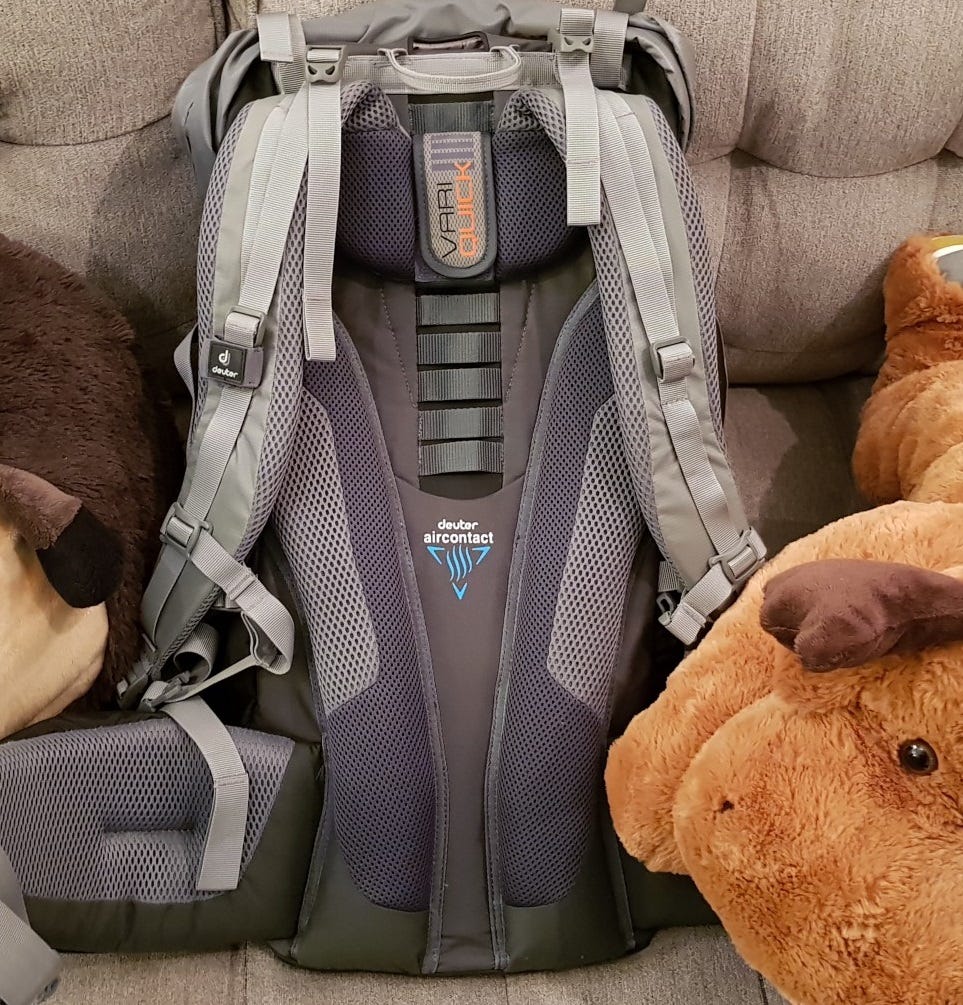
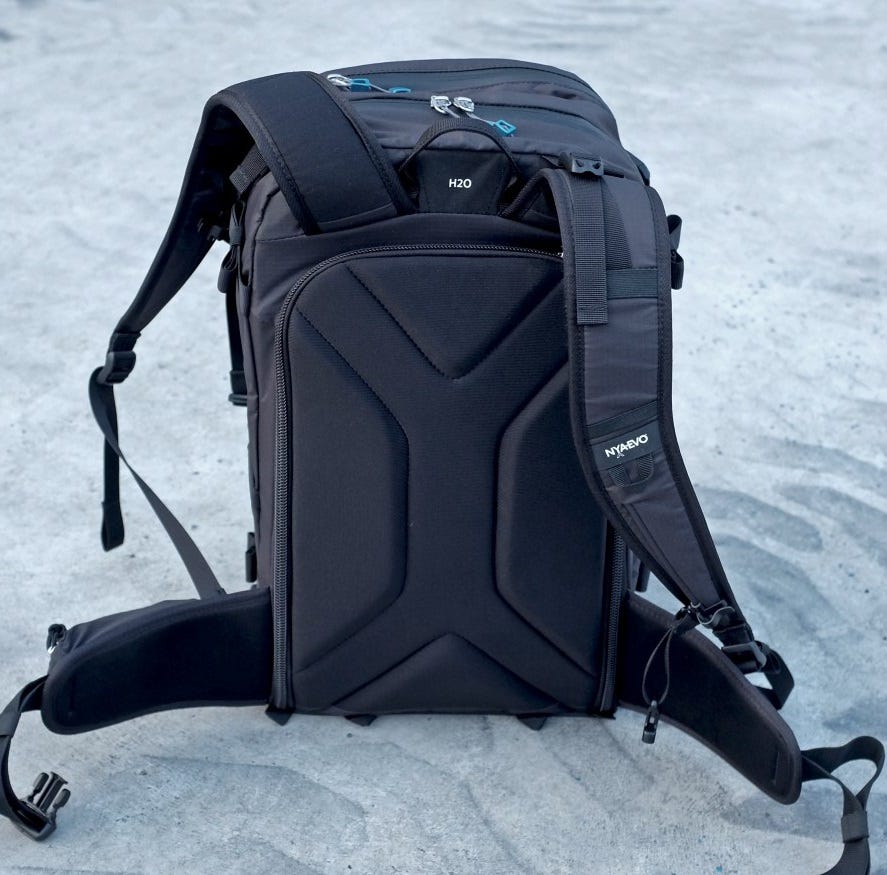
Daisy chains are a number of webbing loops sewn in a linear series that are basically a whole bunch of lash points lined up. Useful for attaching small items when you’re hiking.
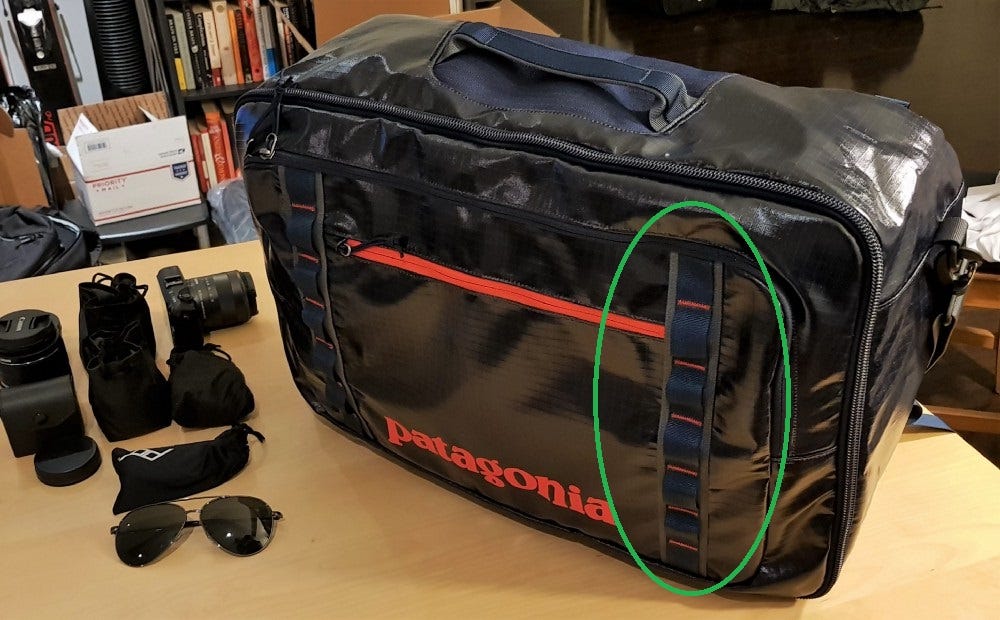
MOLLE system / PALS — like daisy chains, but on steroids. MOLLE is an acronym for modular lightweight load-carrying equipment and allows users to attached gear to an array of nylon webbing. These rows of webbing are called PALS (pouch attachment ladder system). MOLLE systems are a standard for tactical gear and are used by the current generation of backpacks used by the US Army and many other armed forces.


Tie out loops can be used in place of daisy chains and are essentially a few tiny loops stitched around the perimeter of the bag. These loops can be used as attachment points for elastic cords or twine to hold gear and add virtually no weight to the bag.
Pass-through / Eyelet / hydration port — All names for what is essentially a small hole in a backpack. They’re intended to allow you to pass a cable, wire, or tube through the fabric of the backpack and can be seen with a variety of uses (e.g., tubes for water bladders or cables for headphones).
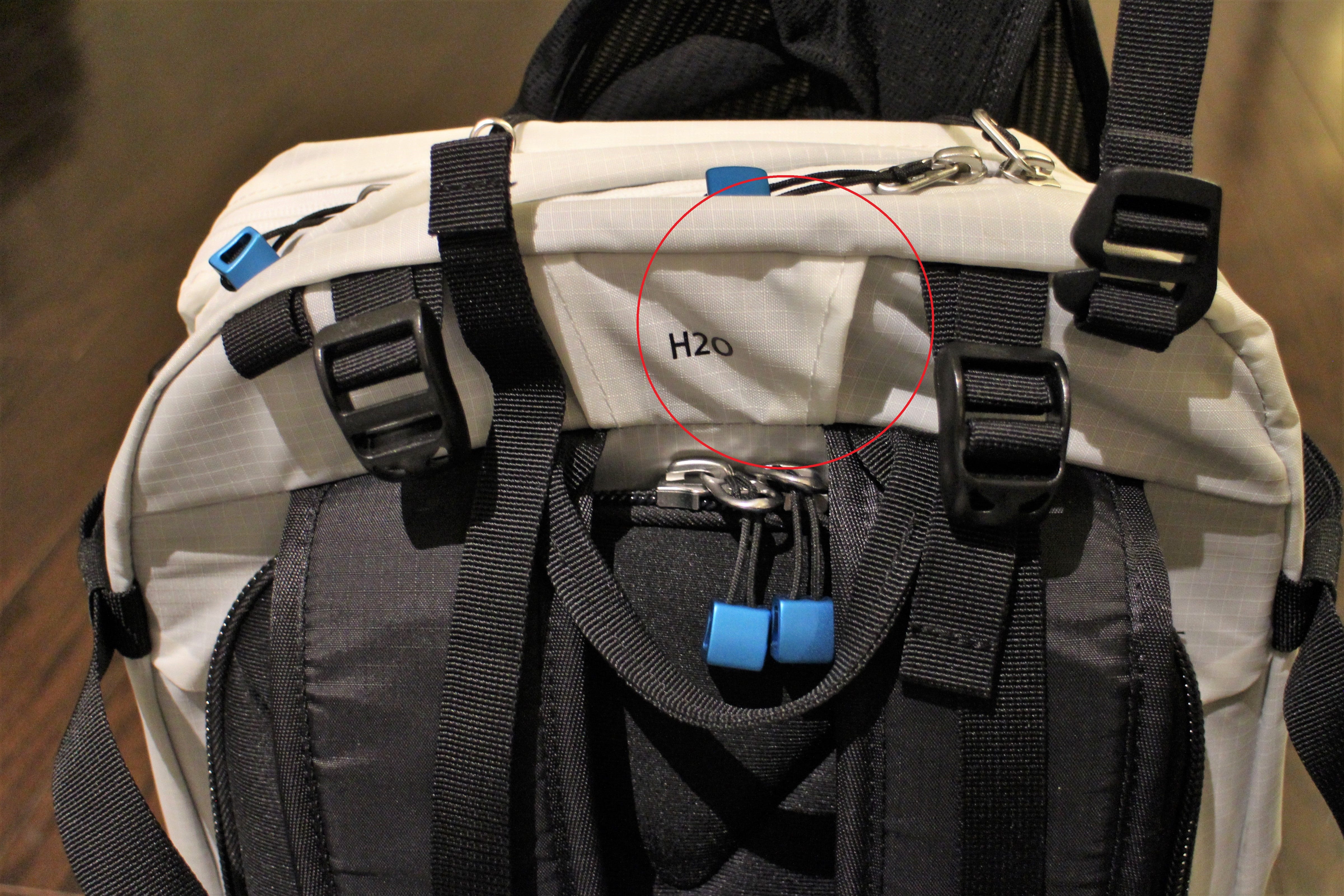
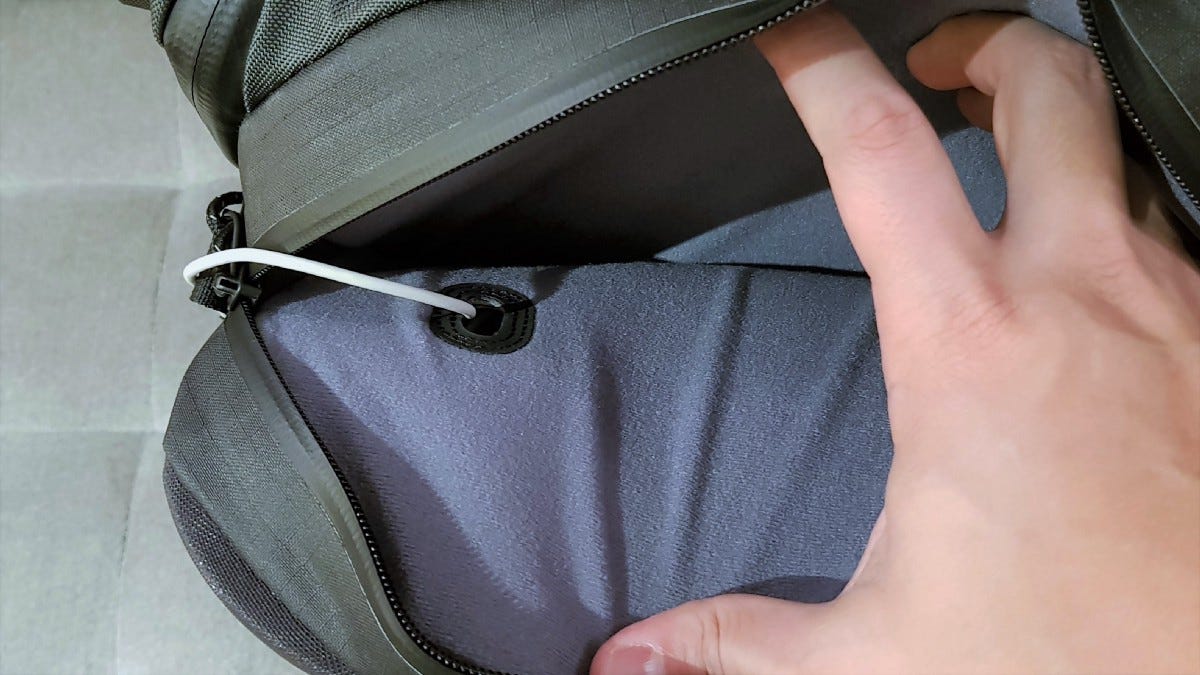
Rain fly — Since some backpacks are not as water resistant as others, they may come with a rain fly. These rain ponchos for backpacks just provide an extra layer of protection from the elements. Some backpacks come with them included or attached, but you can also buy them separately.

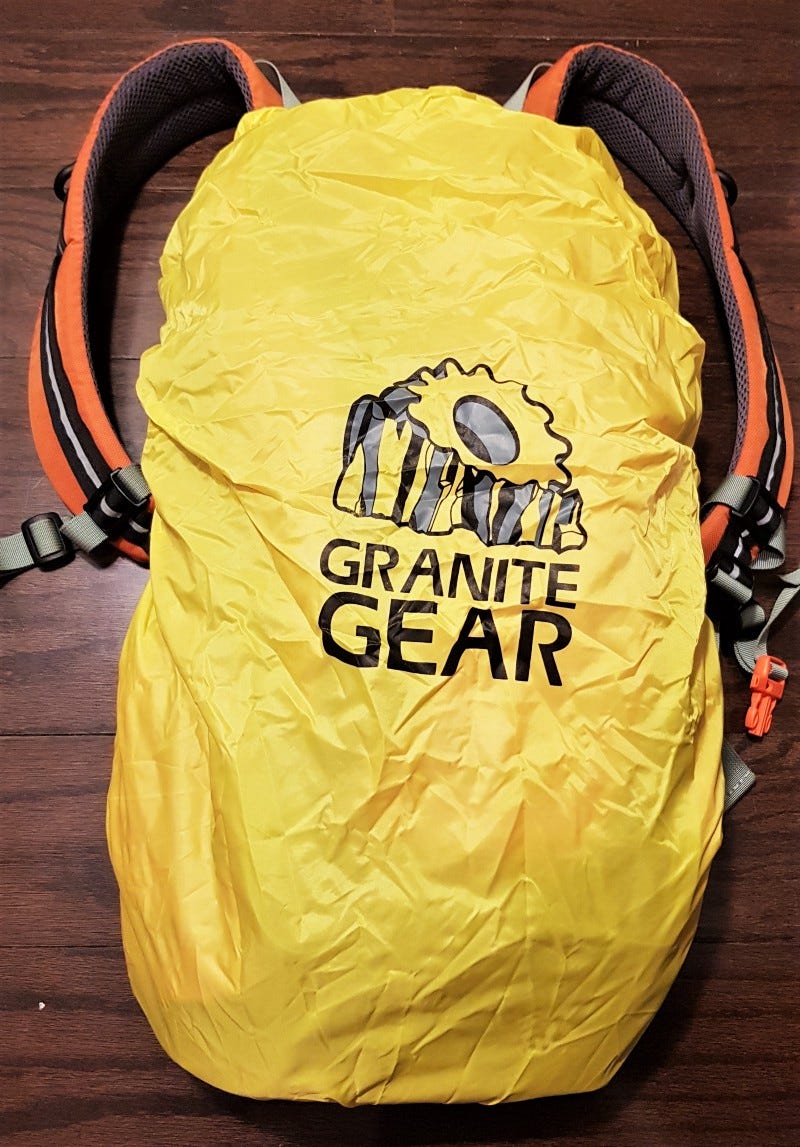
Luggage strap / pass-through — Travel backpacks usually have a wide strap on the back panel that allows you to attach it to the handle of a rolling luggage. It’s a very convenient feature, but just be careful if you’re using a large backpack. It may outweigh a small rolling luggage and cause it to tip forward if you try to stand it up.


HARDWARE
Zippers
Everyone knows what a zipper is and what it does. Here is a run down on all the components typically seen in backpacks:
- Teeth — the small ridges that interlock to form a sealed chain
- Chain — the continuous piece formed when the two halves of teeth are interlocked
- Sliders — the device that moves up and down the chain to open and close the zipper
- Pull tab — the “handle” that’s used to pull the zipper up and down, often with an extension tied to it for easier use
- Tape — the fabric on the sides of the teeth and chain
- Stops — the parts at the top and bottom that prevent the zipper from sliding off the chain
- Garage — a covering at the end of zipper where the slider can be parked to prevent water from leaking through the slider
- Aqua guard — a design that uses a polyurethane laminated tape that is more water resistant than traditional fabrics to improve the water-resistance of the zipper
Here… just look at these instead:
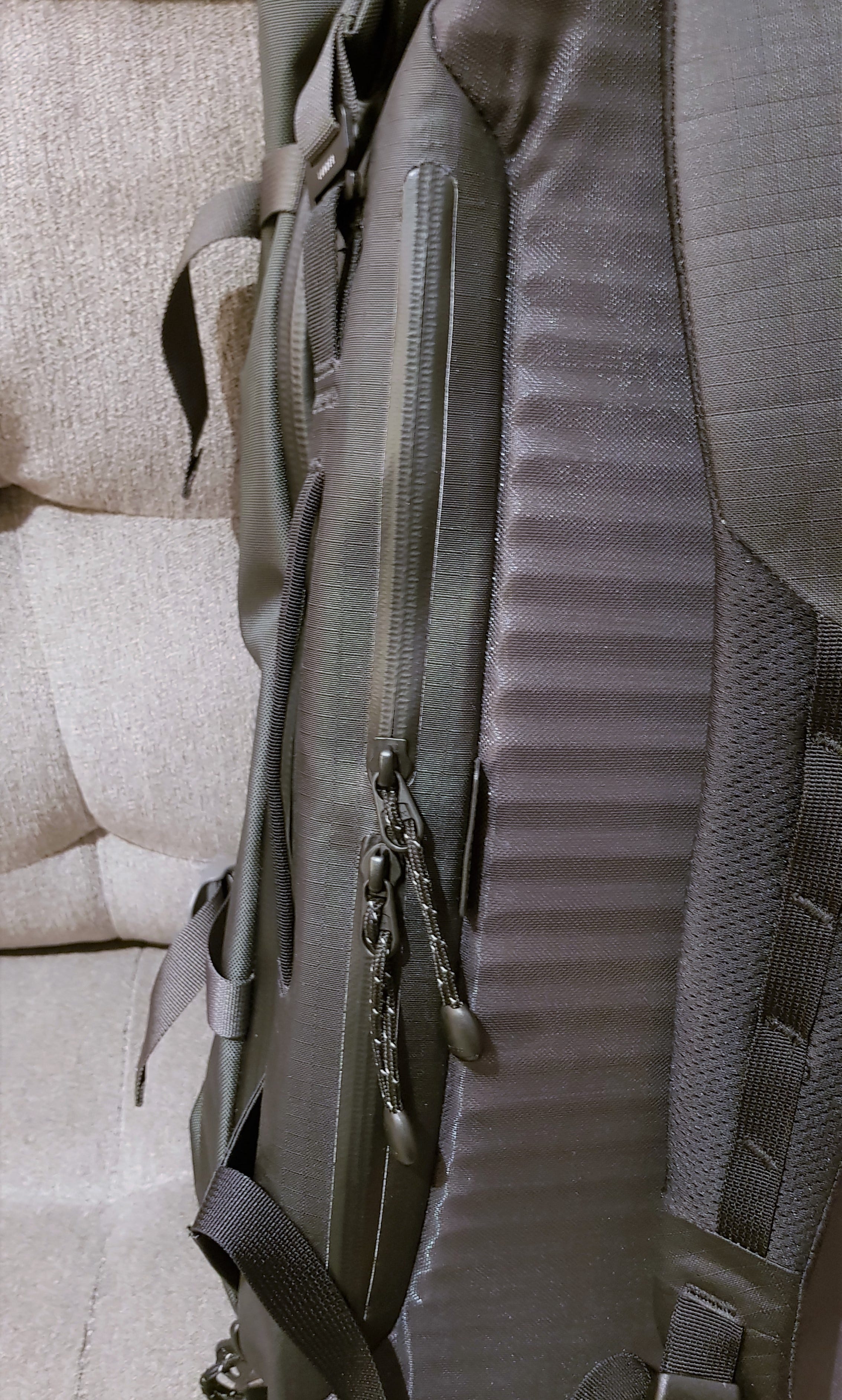

You may also see us refer to zippers by gauge size (usually #3 — #10). These indicate the size of the chain widths and teeth. The larger the number, the wider the chain/teeth are.
Airtight zippers also exist, but you don’t see them on backpacks. NASA developed them for high-altitude pressure suits and space suits.
Other Hardware
Hooks (G-hooks) — Around backpacks, you might also find various hooks, often in the shape of a “G”. These have a variety of uses, but can be used on compression straps, for attachments like nets (e.g., the helmet net on the NYA-EVO), or even closing mechanisms like the Lander. The problem with G-hooks is that how well the operate often depends on how tightly the hooks fit into the loops.


Buckles are the hardware pieces that fasten together (e.g., on hip belts and sternum straps). They’re usually made of plastic but you might occasionally see metals ones too, often something lightweight like aluminum.
Adjusters are what we call the hardware pieces used to adjust the length of the straps. They usually also have a tab that you can pull outward to make it easier to loosen the straps.

Magnets — I’ll assume everyone knows what magnets are. They create their own permanent magnetic field. These days, magnets are incorporated into buckles and lid flaps. Look for Fidlock components. They make amazingly smooth magnetic buckles that are just addictive to play with.
Frame — Many backpacks feature a frame to provide structural support and give the bags a consistent shape. Most frames are internal and can be either a a stiff tube that follows the perimeter of the bag or a sheet frame that’s usually buried inside the back panel. External frames usually sit further away from your torso and while they increase the air ventilation against your back, but tend to be more top-heavy.
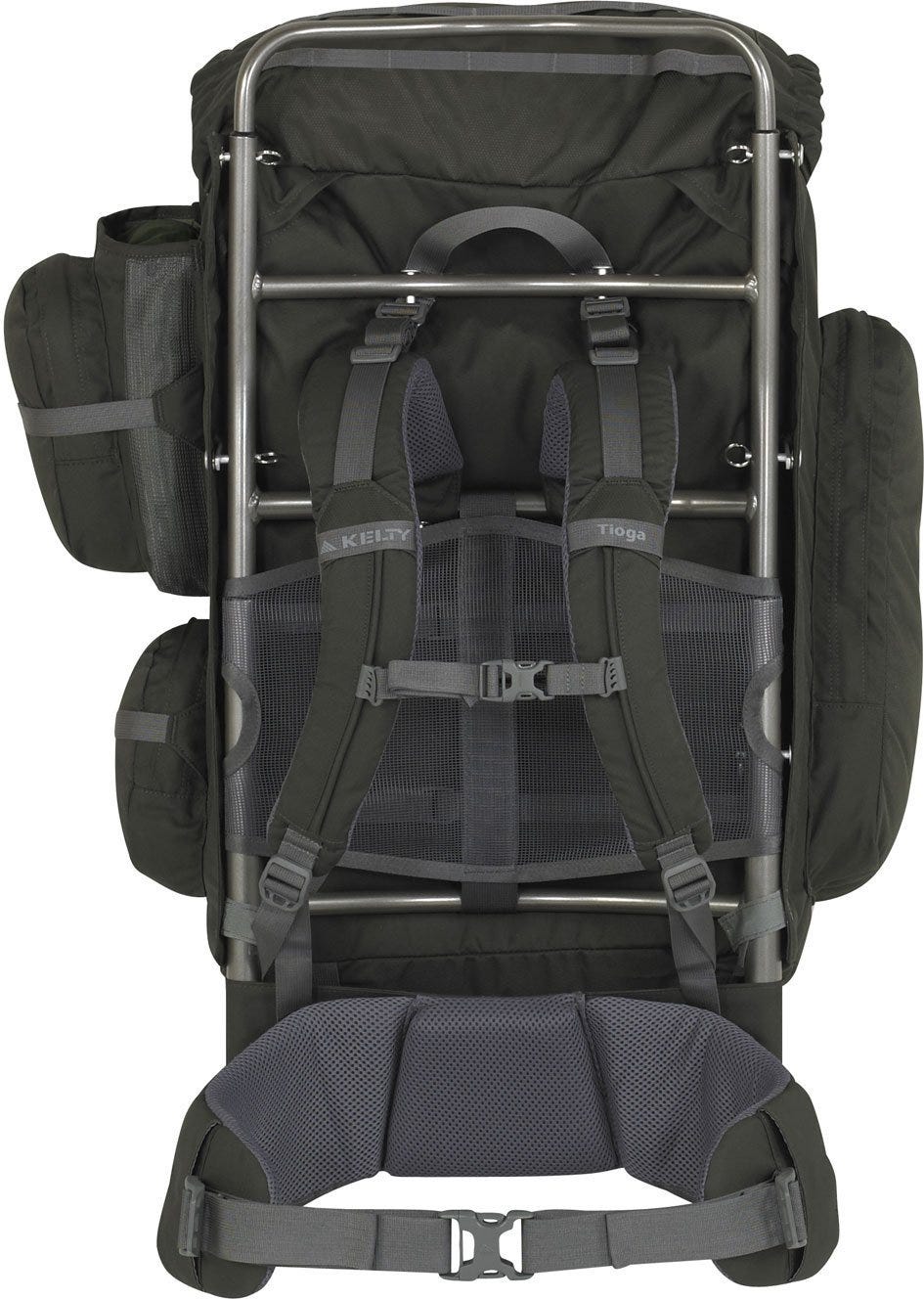
No rating chart at the end of this post! If you made it this far, you have far more patience than I do. Let us know if there are any other parts of the backpack we should mentioned!
Bag Accessories
Backpack accessories refer to a range of items that can complement a backpack, like a waterproof backpack cover, or handle wrap.
Bag Bottom
A bag bottom is a panel at the bottom of the bag that provides support for the main compartments and also protects the bag from damage with extra reinforcement. This can be in the shape of a single material panel or additional bag feet/base studs.
Bag Charms
Backpack charms are a way of adding personalization and touch to a backpack from a hanging tassel to a luggage tag to a bag fob or charm.
Bag Feet / Base Studs
A plastic or metal piece at the bottom of a backpack that protects the bag from dirt and damage. This is commonly seen in handbags and other types of crossbody bags as well and in a backpack will probably be used for leather bags to protect the leather from outside damage.
Bag Opening
The bag opening refers to the main way of accessing a backpack’s largest compartment and plays a large role in determining the shape and silhouette of the backpack.

Binding
Binding occurs in the inside of a backpack as a way to sew and attach different parts of the bag together, like the lining and inner compartments with a bag’s outer shell.
Buckles
Buckles are used in a backpack that has a shoulder harness or sternum strap as a way to connect the harness to the strap.
Decorative Panel
Some backpacks feature a decorative panel that is used for embellishment and aesthetic purposes.
D Ring
A D Ring is a part of a zipper puller, it refers to the “D” shaped piece that connects the zipper teeth to the puller and can be made in metal or plastic with a variety of color and aesthetic finishings.
Handle
A handle is commonly placed on the top of a backpack and is used to carry and hold a backpack for short distances.

Hardware
Backpack hardware generally refers to all of the literal hard components of a bag, like the buckles and zippers.
Hip Padding
Padding that extends from the back of the backpack and straps in the front. Similar to the sternum strap and shoulder harness, hip padding is most commonly seen in outdoor and travel backpacks for weight distribution.
Interior Zipper Pocket
An interior zipper pocket is a small pocket in one of the bag’s compartments designed to store small items for easy access.
Laptop Compartment
Backpacks that are made for work, travel, or everyday use often feature laptop compartments, since carrying a laptop has become a staple item for many. Laptop compartments often feature padding on both walls and on the bottom to keep a laptop safe while on the go or in the event of a bag dropping. Some backpacks also feature separate laptop compartments, where an individual compartment made for the laptop allows for quick and easy access.
Lining
The lining in a backpack refers to the material that’s used inside a backpack’s compartments. These can vary depending on the bag’s shape, price, and construction, but typically

Luggage Strap
A luggage strap is a flat piece of material that is applied to the back part of a backpack and is used for sliding the strap over a luggage handle, making it useful for travel.
Main Compartment
The main compartment of a backpack will be the largest area in volume of a bag for storing items. This will be accessible via a zipper on the outer part of the bag and placement of the zipper can vary depending on the shape of the backpack.
Materials
A backpack can be made of a single material or a combination of multiple materials. Even with backpacks made from a singular outer material like leather or ballistic nylon, the interior lining backpack will often feature a different type of material.
Padded Shoulder Strap
A padded shoulder strap is when a strap has extra cushioning or support in the form of a padded material like foam (like EPE or EVA) or mesh as opposed to a strap only containing a singular material type.
Shoe Compartment
Shoe compartments are seen in backpacks for the gym or sports as they provide a way to organize and separate items like shoes and sweaty clothes from other parts of the bag.

Shoulder Harness
Upper section of the backpack straps that provides shoulder support. Commonly seen in outdoor backpacks or travel backpacks that require reduced weight load on the shoulders, but less seen in everyday or work backpacks.
Sternum Strap
A strap that extends across your chest when the backpack is worn. Similar to a shoulder harness, it’s most commonly seen in larger backpacks for outdoors and travel.
Stitching
Stitching occurs throughout a backpack from the outer straps and materials to the inner main compartments. Some backpacks require different stitching methods from bar-tacking for extra durability and strength to leather backpacks that require more stitches per inch than a backpack made from a woven material like nylon or canvas.
Strap
A piece of woven fabric that connects the top to the back of the backpack that’s made to fit around your shoulders. They can be made from different types of materials and commonly feature the same material as a bag’s outer shell.
Strap Adjuster / Tri-Glide
A strap adjuster, also known as tri-glide, is a plastic or metal piece that is connected to a backpack’s strap and allows for adjustment of a bag’s webbing to change the height of how high or low a backpack lies on your back.

Trims
Trims are commonly seen in bags that feature leather and are used as an aesthetic detail inside a bag’s compartments or on the outer facing areas like straps or pockets.
Water Bottle Pocket
A water bottle pocket can be found on the outside or inside of a backpack for storing water bottles. An outer pocket allows for easy, quick access on the go.
Webbing
Webbing in a backpack is a piece of woven material (often a type of nylon) that connects the bottom of a backpack’s strap to the bottom base of a backpack. The webbing can be adjusted via a strap adjuster for changing how high or low the bag sits on your back.
Zipper
Metal or plastic piece that allows for the opening and closing of a bag or a bag’s internal compartments. Zippers commonly come in either metal or nylon material and can also be made to be waterproof or finished with different color options (learn more about the history of the zipper).
Zipper Pullers
While a zipper refers to the entire zipper from the teeth to the puller, a zipper puller itself is the part of a zipper that one is able to grab to open and close a zipper’s teeth. A zipper puller can be made from plastic, metal, or a range of materials including real leather and vegan leather.
Although they’ve been proven to be extremely helpful, there are some concerns when wearing backpacks. Due to the heavy nature of some of them and incorrect design, many people find that after some time they have the potential to cause back, shoulder or neck injuries that may be short-term or permanent.
This is one reason why backpack manufacturers today are focusing on ergonomic features that prevent these problems from occurring and also make it more comfortable to carry the load of a backpack.
Those who wear these bags for longer periods, like hikers and campers, will especially be grateful for ergonomic designs and may find it even helps to lessen their fatigue while hiking.
In 2013, there was over 5,000 backpack-related injuries treated in the United States which is quite alarming to consider.

Wearing one of these handy accessories dosn’t really lead you to think of pain and injury, however, it’s certainly possible when you wear a backpack that doesn’t fit right, isn’t ergonomically designed, or has far too much of a weight load in it for your body.
As a rule, it’s recommended not to wear anything that weighs more than 25 percent of your body weight in a backpack, and this number dramatically decreases for younger people and those who might not be physically fit. These are just some of the long-term effects of carrying a heavy or poorly designed backpack:
-
Reduced breathing ability due to improper positioning of the chest;
-
Short and long-term damage to the spine;
-
Headaches caused by a strained neck;
-
Muscles spasms and back pain during and after use;
-
Scoliosis.
The nature of the backpack leads it to pull back on our shoulders and affect our posture, so it’s a purchase that needs to be taken seriously. When you’re in the market for a new backpack, ensure that it has the right ergonomic features and has been designed with support and comfort in mind.
The earliest examples of backpacks were made of cotton canvas, thanks to its lightweight feel but durable texture. Since then, we’ve seen many different materials being used to make our backpacks, with some more beneficial for specific purposes than others.
Today, we find that a single backpack is made of different materials to cater to the wide arcs of traveller demands. The materials being:
Cotton
Cotton canvas has been used in the initial backpacks, used in the olden days. These were not waterproof and would tear sooner or later due to rough usage and abrasions.
In order to make them last a little bit longer and be made waterproof, cotton bags were coated with molten wax. Military duffel bags during world wars were made using this concept. But, there were many drawbacks even then.
The wax if not dried properly used to end up getting decomposed.
There was a certain level of rigidity, yes, but all of that wore off as soon as there was a slight abrasion on the surface. Even today, cotton canvas is used but not alone, there are many synthetic fabrics used to make these bags better.
The major drawback of not being water resistant, however, is a characteristic of cotton bags.
People who want just a fragile, good looking bag to carry items that are not too high up both, on the weighing scale as well as the volume meter, can take to using cotton canvas bags.
It is good for those who are mostly indoors or at the least, not exposed to harsh weather. Since such an exposure would significantly reduce the lifetime of one’s cotton canvas backpacks.
Leather
Leather usage, over the years, has been more of a style statement than for real purpose. Today, it comes as one of the most sought-after materials utilized to depict richness.
Keeping that fact aside, leather does come with a few advantages of its own. It is resistant to wear and tear caused by the weight of articles it holds. It becomes more flexible and accommodating over time due to continuous use.
When it comes to being water resistant, the extent up to which this property exists depends on the type of leather being used because leather, due to its permeable nature, allows water to seep in after a certain threshold.
Two methods, called “conditioning” and “synthetic spraying”, are applied to leather with the intention of increasing its water-resistance. In both these methods, there is another layer of synthetic material sprayed or conditioned into the pores, thereby, decreasing its permeability.
The leather is expensive but it definitely lives up to its quality expectations and is durable. There is a lovely blend of elegance and functionality in leather backpacks manufactured nowadays.
Those that don’t mind going that extra mile to spend on backpacks, to walk around their workplaces with élan definitely should go for these leather ones. They are available in various textures and styles, with well-organized compartments suitable for corporate use.
Polyester
Polyester is a kind of a synthetic fabric like nylon. It is used generally, in making backpacks for students, both school and college going.
It possesses the ability to recover quickly when put through very dry conditions and when exposed to water.
It is rigid and lightweight. But, this material is way cheaper than its competitor nylon. In other words, polyester is a cheaper replacement of nylon. The reason for the same being that it wears down quickly and doesn’t last as long as nylon.
UV sensitivity is one area where polyester stands out when compared with nylon. Nylon is said to be more sensitive to ultra-violet light than polyester.
Backpacks made with this material do not degrade when exposed to continuous heat or UV.
Hence, the best audience that backpacks made of this material caters to would be those, who stay out in the sun more often and do not require to carry a very heavy load on their back.
Mostly, school and college going kids prefer possessing these bags. These bags are inexpensive and very easily available in many bright colors too.
Nylon
Nylon is one of the most used synthetic fabrics, specifically in the design of backpacks. It is the next popular material after cotton canvas because it covers up for almost all the drawbacks posed by cotton canvas.
Nylon is resilient equally to wet and dry conditions. It has a long durability factor.
The material itself is expensive because of the manufacturing process itself is so but, it lives up to its worth in numbers due to the various properties it possesses.
It is lightweight, easy to wash, and resistant to wear and tear caused by abrasions. However, nylon does tear when punctured.
In order to overcome this drawback, backpacks use nylon with different sewing and weaving patterns like that present in “rip-stop nylon” and “ballistic nylon”.
In materials like this, there are threads of varying thickness sewn tightly together to avoid a rip or puncture, to spread and cause damage to a greater area. Nylon is used in almost in all backpacks that fall in the middle range of affordability.
The only disadvantage of those nylon backpacks that have a tightly packed structure is that this property makes the fabric less breathable, causing the items inside to remain moist, in case, already wet or soaked.
Cordura and Kodra are names used to indicate that a certain fabric has been made using the highest quality of nylon in it.
These find its utility in backpacks that are required to be durable, strong and well resilient to weather and chemicals. Backpacks made of Cordura nylon or Kodra, lie in the higher price range due to the additional abilities it offers to the backpack.
Cordura is the fabric chosen by the military used for their bags and baggage. Kodra is its counter-part founded in Korea. Due to its production cost, Cordura forms a part of most the high-end nylon backpacks.
Hence, if one is not looking for a big investment into backpacks, Cordura is not a good option. They could go for polypropylene or polyester or PVC fabric. Nylon package cloth is another good option for those going for borderline durability and quality.

Kodra Nylon
Kodra was developed as an alternative to Cordura and originally comes from a manufacturer in Korea (Kolon International) who have a strong history of Nylon based fabrics, dating back to the 1950s.
These days Kodra seems to be mainly produced by a variety of Asian manufacturers, so is not as tightly controlled as Cordura. However, it is considered to be very abrasion resistant just like Cordura is.
Ripstop — Ripstop nylon is very commonplace now particularly for camping and hiking backpacks. Rip-stop nylon integrates a grid of thicker threads sewn directly into the nylon at close intervals. This prevents the issue of ripping or unraveling if the nylon is punctured and also helps waterproofing. On the other hand, if rip-stop is used in light fabrics, abrasion or regular use can cause holes to open along the seams more quickly than in other thicker fabrics, as lighter threads and the thicker ripstop threads wear at different rates. Ripstop is used in sails, parachutes, and hot air balloons and was originally developed in WW2 to replace silk parachutes.

Ballistic — Once in awhile you’ll also see nylon that is termed “ballistic nylon”. This is a thick and durable nylon that was originally designed by DuPont for military apparel during WW2. Its name reflects the intention of protecting airmen from debris and shrapnel caused by bullets and shell impacts. It was, in short, the limited body armor used before Kevlar was developed, but is still used today for sporting equipment, motorcycle jackets, and tool/utility belts. Technically, ballistic nylon is woven nylon made in a 2×2 or 2×3 basketweave of varying denier, typically 840D to 1680D — it’s a very heavy nylon. More on denier below. The Aer Fit backpack is a high denier ballistic nylon.
Polypropylene
Polypropylene is a kind of thermoplastic polymer. It is not as resistant to stretching and shrinking as its counter-part polyester. It is definitely resistant to water and it floats over water.
It has almost the least ultra-violet resistance and hence loses its color and texture when exposed to direct sunlight for a long duration. It dries very quickly hence, finds its use in bags and backpacks taken to areas having water bodies nearby.
It is one of the cheapest fabrics found that offers properties like being water and chemical resistant along with good mechanical properties.
Polyester Pack Cloth – This cloth adds resistance against UV to a backpack and is great for those that are constantly taken outdoors. Although by itself it might not be ideal for a backpack it works well with other durable materials to prevent sun damage from occurring.
Strength & Durability Ratings
Now you are well versed in the materials used in backpacks, it is time to dive into the specifics. Strength and durability.
In most cases you will see a whole lot of letters and numbers associated with the material your backpack is being made with, such as:
- 600D Nylon
- 100T Polyester
- 150GSM Polypropylene
And many other variations. In this section I will try to quickly and simply breakdown what it all means.
Denier Rating (D)
The first and most important part is the number with the D at the end. The D refers to Denier and is a rather complex sounding measurement of how heavy a length of materials is. It is calculated based on a specific length (9000m) of yarn. But, in reality what it means is this:
A higher Denier means a heavier overall fiber. If you are comparing the same kind of material, a heavier fiber will normally also mean that it is stronger.
For example: a 1050D Nylon is stronger than a 650D Nylon, all things being equal.
However, if you are comparing Polyester against Nylon or even Cordura against standard Nylon, things can vary a lot.
Also be aware that some manufacturers use coatings, backings and different weaves to increase the strength and abrasion resistance of the material. This post shows you the relative (tensile) strength of various materials, and demonstrates how various types of fabrics can vary in strength.
Thread Count (T)
Not as often seen in the high-end backpack world, but still used with fabrics in general, Thread Count is an alternative to Denier when it comes to measuring fabric weight. It is a count of how many threads there are in a square inch. Again, a higher number generally means a stronger fabric.
Grams per Square Meter (GSM)
The third alternative is based on the metric measurement of density – grams per square meter (which would be something like ounces per square inch in imperial). It is most often seen with Polypropylene and other fabrics where no weave is used, so thread weight or thread count is not as relevant.
Tenacity (Strength to Linear Density Ratio)
When you get a little down and dirty with various types of backpack materials, it pays to compare their actual strength on a weight for weight basis. That is where the so called “Tenacity” of the material comes in.
Most of you won’t be concerned with this measurement, as it is rarely available in backpack specs. However, it is worth noting that:
- Nylon normally has a higher Tenacity than Polyester
- There are two main types of Nylon – 6 and 66. Nylon 66 is stronger but rarely seen in backpacks.
Backpack Material Waterproofing Materials
Making a backpack 100% waterproof is difficult due to the stitching, zippers and openings.
However, a lot of manufacturers add layers or coatings to their packs to help keep them dry.
The following is an explanation of some of the most widely used waterproofing materials.
DWR – Durable Water Repellent
Probably the most often seen letters when it comes to waterproofing. DWR is a coating that is added on the outside of materials to help keep water at bay.
The problem with DWR is that it slowly deteriorates over time due to abrasion, dirt, sun and other factors. So, although the water may bead when you first get your pack, slowly this effect reduces until it starts to soak. This is where the next line of defense comes in – the material or the backing.
Another alternative is to re-coat your pack with DWR, or prevent it from deteriorating in the first place by keeping it clean and salt-free, as well as storing it in a dark, cool, and moisture-free place.
PU Coating
An alternative to the standard DWR is to have a PU (Polyurethane) coating on the material to help waterproof it. So, you might see the initials PU mentioned in the specs after the material name (eg. Nylon 500D PU).
PVC Coating or Laminate
Another material that is sometimes seen in waterproofing efforts on backpacks is good ol’ PVC (Polyvinyl Chlorid). More often associated with your drainpipes at home, this can also be used in smaller quantities to help with this process.
TPU-film Laminate
One of the most commonly seen interior layers on waterproof packs is the TPU – Thermoplastic Polyurethane Film. Depending on the manufacturer’s use of the material as well as the quality of the layer, it can be quite effective, especially when combined with DWR on the outside.
For example, Exped, which is known for their great waterproof bags, uses this combination on their Torrent bag.
A backpack can be as simple as a rucksack or something more serious that you take on a week-long camping expedition, so the sizes and shapes they come in vary. For this reason, some like to have an array of backpacks to choose from and others have just one they rely on, so it all depends on the individual and the occasion.
The size of a backpack is usually measured in terms of liters, starting from around 25L and ranging upwards of 75L. For those who spend a couple of weeks in the outdoors something around 55 liters is ideal, and you can move up or down in size depending on where you’re going and how much stuff you’ll need.
Backpack shapes are generally square or rectangular, with a few minor differences depending on their other features. Naturally, a rectangular backpack is the best shape for packing efficiently and storing other items like laptops and tablets in safely. However, the best way to choose the right one is to think about the gear you’re carrying and then shop accordingly.
These are the most common backpack styles and their sizes:
Daypacks
Daypacks are backpacks that are designed for excursions that are only a day long. These are meant to carry things that you’ll only need for a few hours or up to 10 hours. Daypacks are usually between 8 to 30 liters in volume. Small daypacks, such as those that are less than 10 liters, are ideal for day hikes or even while you’re out traveling and exploring an attraction or city for the day. You’ll probably use it to carry snacks and refreshments, a towel or a change of clothes, and perhaps a lightweight jacket. Generally speaking, any backpack under 30 liters is suitable for use as a daypack. For half day hikes, 10-20 liters would be suitable but for a full day hike, you might want to consider getting a 30 or 35 liter daypack.
- They generally have a carrying capacity of 15L – 35L. Hiking daypacks and backpacks are measured in liters. Fifteen liters is usually big enough to give you room for a laptop or water bladder and a few extras. A 35L version is big enough for a weekend trip when you are staying in a hotel or an ultralight overnighter.
- They are lightweight. What is a daypack if not a lightweight way to keep your hands free while tooling around town or on a day hike?
- They are cheaper than backpacks. You can get an entry level daypack for $40. I’d run the other way if you find a backpack at this price point. This is a general rule. However, if you choose an expensive brand name (like North Face or Fjallraven), you could very well dish out just as much for an 18L canvas bag as a 55L round-the-world-ready backpack from Osprey.
- There is little or no back support (aka an internal frame). A hiking daypack may come with some padding to make it more comfortable, but most daypacks are meant to be compressible (aka packable) and not worn for long periods of time. A backpack will come with an internal frame for better back support.
- They don’t have padded shoulder straps. Again, a daypack backpack is not made for very heavy loads or long treks. The best hiking daypacks WILL come with a small hip strap to snap around your waist and a sternum strap for across your chest, though. This will help keep it close to your body and prevent it from bobbing around while you hike.
- They are top loading. This means that the main feature of a hiking daypack is the opening at the top. This is how you will get small items you need for a day hike in the pack. Backpacks will usually have a side opening and a bottom section where you can stuff a sleeping bag.
- They can be canvas, leather or another synthetic material. Depending on whether you are looking for something stylish to trek around town with or just a hardy hiking daypack, the size and limited carrying capacity allow daypacks to have more material options. Backpacks generally need to be water and weatherproof (or resistant) to meet the demands of overnight trips or extended travel.
- They tend to be a bit more stylish. Daypack backpacks are very versatile. People often use daypacks on the trail, in the coffee shop and even at work. So, companies usually make a lot more options to fit everyone’s style.
Weekend backpack
Weekend backpacks are suitable for quick getaways lasting 2-3 days. A good weekend backpack is around 40 liters in volume, and is typically used to carry enough clothing for your trip as well as a few other necessities. Additionally, a weekend backpack should have enough space for you to bring all the clothes you need for up to three days without needing to have your clothes laundered, assuming you change outfits just twice a day at most.
Multi-day backpacks
Multi-day backpacks are used for longer trips that span several days; it could be used for trekking and hiking, as well as backpacking trips abroad. They usually come in 50 to 90 liters in size, and in the larger range can accommodate sleeping bags and a tent. If you’re going on a 5-night trip or more, opt for a backpack that can accommodate 70 to 90 liters but this is assuming you’d have your clothes laundered occasionally and pack versatile pieces that can be reused throughout your trip. For a 3-5-night trip, 50-65 liters will suffice; and for 2 nights, 35-50 liters.
School backpacks
School backpacks are those used by kids, high school students, and college students who usually have to carry a heavy load. These are usually 6 up to 20 liters in size. They are spacious and roomy; designed to carry several books, notebooks, and even a small laptop or tablet. The same size of backpacks that are used for school can alternatively be used for sports as well. For example, the popular Jansport brand is well-known for their versatile line of school backpacks. Deciding on how many liters a school backpack is should depend on the weight and quantity of things you’ll be taking along.
Laptop backpacks
Students and professionals alike rely on various types of laptop backpacks. But determining the right laptop backpack for you will depend entirely on the size of your laptop. In this case, you’ll have to measure the dimensions of your laptop to check if it can fit inside its sleeves. Common laptop backpacks are designed to cater to 13 inch, 15 inch, and 17 inch laptops. It is entirely up to you to choose a laptop backpack that has less or more volume; some people need a backpack only to carry their laptop and few other things, while others require more spacious laptop backpacks to carry other items.
Tactical military backpacks
Used by soldiers who require heavy-duty bags, tactical military backpacks are distinct because of the kind of material it’s made with. These are designed to resist water, tearing, and is durable enough to survive even in the most rugged environments. Tactical military backpacks are also excellent choices for outdoor adventures and traveling because they are just so robust. They come in 25-50 liter sizes.
Drawstring backpack
If you’re looking for a lightweight backpack, a drawstring backpack is one of the best options out there. The material is typically made from fabric, and these are excellent choices for carrying an extra pair of shoes, or your gym clothes and a towel. Drawstring backpacks make great extra backpack storage to your regular backpack or can also be used as a lightweight carry all; most of them come in 14×18 inch sizes or 17×20 inches.
Carry on backpacks
Carry on backpacks come in varying sizes to meet the general 45-linear-inch requirements of most airlines. Your carry on backpack shouldn’t exceed 22x14x9 inches (length x width x depth) if you want to breeze through security and prevent issues with your carry on. But when deciding how many liters for a carry on backpack you should get, check the limitations of the airline you’re flying with.
Hydration backpacks
Used by cyclers, runners, and hikers, hydration backpacks are an efficient solution for recreational needs. These are made with an ergonomic design that places comfort above all, and security for your belongings. The most distinct feature of a hydration backpack is its hydration bladder compartment which is used to store water that you may need during your trip. It’s one of the best choices for outdoor trips, especially for storing things that you may need several times throughout your hike, run, or ride such as water and some snacks. The best way to choose a hydration backpack is by determining the capacity of its water reservoir; its most important feature. Water reservoirs can range from 0.5 liters (1.10 pounds) to as much as 3 liters (6.61 pounds). On the other hand, gear capacities for hydration packs range from under 5 liters to as much as 50 liters.
Suitcase backpack
A popular choice among frequent business travelers, suitcase backpacks are compact and easily fit within the aircraft overhead bin. These are designed to be easy to travel with, sometimes have rollers or wheels, and are made with flyers who often go on many domestic or short flights. Depending on the size, suitcase backpacks can fit a laptop and some clothes, or more items. The most common styles in the market range from 25-40 liters.
Duffel bag backpack
This model combines the best of both worlds: duffel bags and backpacks. These are great choices for the gym and travelling, since they’re portable and big enough to carry your clothes, shoes, and toiletries while adding the ease provided by backpack straps. Additionally, duffel bag backpacks also have a very distinct design that stand out from other backpacks in the market. These hybrid backpacks can also double as weekend and multi-day bags, and can usually hold from 20 to over 100 liters.
Compression backpacks
Also known as a compression sack, as its name implies these bags can be compressed so that you get as much storage efficiency as possible. It makes a great additional backpack or carry all, and helps ensure that you make use of all the space possible when you’re traveling. Compression backpacks are also ideal for travelers who want a compact and light bag without sacrificing storage space, which gives you a much more comfortable adventure. Compression backpacks range from 15 to 50 liters.
Female-specific backpacks
While women can wear unisex or an appropriate men’s backpack, there are some models in the market that are designed to fit women more comfortably. Female-specific backpacks are usually designed with a curved waist belt, shorter torso length, and narrower shoulder width; features that are more mindful of the differences in a woman’s body, which typically won’t be in a man’s hiking backpack. These types of backpacks make it easier for women to find a suitable pack that they can travel with to long distances, which is an excellent option for women who want to explore the best choices for their body types in the market.
External attachments
Lastly, if you intend to take a lot of bulky items with you, this doesn’t always mean that you’ll need to buy a second pack. External attachments are also available, made for water bottles, rain gear, bulky sleeping pads, and snowshoes which can be stuffed into your backpack’s exterior pockets. Alternatively, some external attachments can also be attached to the bottom, back, or side of your backpack so that you can use the same bag for longer trips.
When you’re researching for a backpack to suit your next adventure, whether it’s a weekend trip or a month-long backpacking expedition abroad, the first thing you’ll probably notice is the sheer variety of backpacks and their sizes. What do they all mean, exactly?
To answer this question, let’s look at the most common sizes backpacks are made these days and what they mean for you as the traveler. Looking at what they were made to carry, and how much of it, is a good way to tell if it’s right for the kind of adventure you’re going on.
0-10 Liters
Most hydration packs, trail running packs, and lumbar packs fall in this volume category. It’s minimalism at its best, and designed to truly only carry the essentials such as a hydration reservoir, a lightweight rain cover, and a few snacks.
10-20 Liters
This backpack capacity is for adventures requiring you to travel quickly for no more than a day. These include day commuting to work or day hikes, where all you’ll need are food and drink for the day, light insulation layers, a headlamp, two liters of water, a headlamp, and a space blanket.
20-30 Liters
Most daypacks fall under this category. These are made to include the essentials such as food for the day, light insulation layers (puffy or fleece jacket), rain shell, a headlamp, a small first aid kit, and a space blanket.
30-40 Liters
This is the category where most weekend and overnight backpacks fall under. If you do go hiking, backpacks of this capacity would be suitable if you have a partner who can carry your sleeping system in their packs. Otherwise, you should be opting for an ultralight sleeping pad or a down sleeping bag for packs this size.
Backpacks that are 30-40 liters in size are usually designed with additional pockets and compartments found on its exterior and hip belts for storing headlamps, snacks, and knives. Keep in mind that backpacks this size are made to cater to various torso lengths, so it’s ideal to choose one that fits you like a glove to ensure comfort and safety during your trip.
These backpacks could fit everything you’d need for a 2 or 3-day adventure, including a lightweight sleeping bag, food for up to 6 meals, hammock/lightweight tarp/ultralight one-person tent, small sleeping pad, underwear, and an extra pair of socks.
40-50 Liters
Ideal for multi-day trips, a 40 – 50-liter backpack is suitable for carrying everything you’d need in a smaller pack including a small pot for cooking, food back for carrying up to 6 days’ worth of food, camp fuel and stove, change of clothes, a water filter, and a down sleeping back.
50-60 Liters
These backpacks are an upgrade of the 40 – 50-liter capacity, allowing you to carry everything in the previous category with additional breathing room for bigger sleeping pads and a tent.
However, many overnight and weekender backpacks are also made in this size range to cater to the essential three things you’ll need on an overnight hiking trip: shelter, sleeping bag, and pad which, while needed, are usually bulky if you don’t purchase the ultra-light varieties. Backpacks this size can hold more extra clothing, a pillow, larger sleeping pad, a tent good for 2-3 persons, camping shoes, and a synthetic sleeping bag.
60-70 Liters
These size backpacks are also used for multi-day backpacking trips which would fit all the conventional equipment and items you’ll need in the previous category, but these will also have additional space for non-essentials that would make your trip much more comfortable and enjoyable.
Many hikers prefer using this capacity for a backpack because it allows you to take more such as a larger first-aid kit, food for as much as 10 days, and extra cookware such as an extra pot or a frying pan.
70-80 Liters
If you take a pack this size, this means that being prepared for your adventure is a top priority. It could also mean that you are carrying supplies for other people, such as your kids or other hiking companions. The only limit to packs this size is the weight you can carry on your back.
A 70-80 liter backpack is also essential for going on high-altitude climbs. If being prepared is important to you, then you’ll want to maximize all the space available on these packs. It will allow you to pack everything on the previous categories plus a tent good for four, highly-insulated and cushioned sleeping pad, and a down or synthetic sleeping bag.
Backpack sizes are measured in two ways: the first is by measuring the volume of the bag, which tells you how much it can hold. The volume of a backpack is measured using cubic inches or liters. The second way to measure a backpack size is through the specific dimensions of the bag (length, width, height, or depth).
Volume
It is the manufacturer’s prerogative whether the backpack measurement is in liters or cubic inches. But some backpack brands already provide both versions so that it’s much easier for the customer to understand; for example, by staying that a bag can hold 20 liters: it’s also 1,220 cubic inches in size.
The volume of a bag can be calculated by using a formula to compute its dimensions. But most backpack designers and manufacturers readily provide this information, which is determined by analyzing exactly how much all the compartments within a backpack actually store. So if your backpack has several compartments, designers measure the storage space of the small pockets in and out of the backpack, combined with the main compartment.
But not all manufacturers measure bag volume this way. Some companies also include the open pockets on a backpack’s exterior, such as its mesh pockets for water bottles, and take that into account. So even if the volume of the backpack seems like the backpack is large, it may not always be 100% accurate.
Dimensions
The backpack’s size refers to its dimensions; specifically, its length, width, and depth. The size of your backpack is important since it tells you how the bag sits on the body. For example, if you know how long the backpack is, you’ll have a more accurate idea of where it ends on your lower back.
Why is Size Important?
Before you purchase a backpack, understanding its size is important because it’s an indication of its capabilities as well as its limitations.
But there isn’t a single backpack size that is superior to another. It all depends on your body size and needs. A backpack that is either too small or too big for you means that the weight of your load will not be balanced, and it can cause severe back pain. In the worst case scenario, an incorrectly sized backpack can even make you topple over. You want to invest in comfort and safety, especially when you’re outdoors and far from medical attention.
Ideally, the right backpack for you is spacious enough to hold just a little more than what you are bringing and is comfortable to carry.
How To Choose The Right Sized Backpack For You
There are several important factors to consider before choosing a backpack. The market is filled with hundreds, maybe even thousands, of different styles that are designed to suit a specific use. Here are some tips to help you narrow down the perfect backpack:
Your Body Type
If you don’t choose a backpack carefully, it’s easy to end up with one that is too large or too small for your body type. Either way, it’s going to be uncomfortable no matter how or where you use the bag. The good news is that you can choose a backpack that fits your size by measuring your torso.
The most effective way to do this is to use a flexible tape measure and ask a friend to help you out:
- 1Lean your head forward then look for the bony bump found between your neck and the slope of your shoulders. This area is referred to as the C7 cervical vertebra, and it’s also the upper area of your torso length.
- 2Slide both of your hands down, past your ribcage to where the top of your hipbones are. This is known as the iliac crest. Point your index finger forward and your thumbs inward to draw the imaginary line between thumbs as you do so. This is the bottom area of your torso length.
- 3Stand up with your back straight, and ask your friend to measure the space between the imaginary line between your thumbs and the C7 cervical vertebra. This is the measurement of your torso length.
It also helps to measure your hips because most of the load of your backpack will rest on this part of your body. If you choose a correctly sized backpack, it’s rare that the hips or waist size to be off, but it’s still advisable to double-check anyway especially if you are going on a multi-day journey requiring you to bring a heavy load. Measure your hip size by taking a tape measure and wrapping it around the upper area of your hips, as it hugs the iliac crest. This line will be a little higher than the belt line.
Most backpacks come with adjustable suspensions which allow it to cater to individuals with varying torso lengths. If you purchase a bag with this feature, keep in mind that torso length should be the most important adjustment. If the other adjustments aren’t correct, all you need to do is reset the torso length.
Weight Capacity
Although we’ve been talking in length about size, it’s also necessary to consider the weight that a backpack can carry. Generally speaking, the larger the backpack, the greater the weight it was made to carry. But you also have to think about the kinds of things you intend to bring with you, because sometimes small items will weigh a lot, such as cooking equipment and camp gear.
Weather
The weather conditions you’ll be exposed to during your camping or hiking trip plays an important role because the elements can make or break your trip if you aren’t prepared. For example, if you’ll be outdoors during the hot summer months, hydration will be a priority which means that you’ll need space for water or hydration packs. On the other hand, adventures during cool weather will require you to have space for sweaters or jackets in your bag. When it snows, you’ll need snowshoes. And finally during winter, you’ll likely need a much bigger backpack for everything.
Your personal packing style
All things said and done, at the end of the day you should also think about your own packing style and preferences. Some individuals have already identified what packing style fits them; rolling their clothes and other items to make it fit in a back or distributing items based on certain weight distribution. If this sounds like you, there may be a chance that you’ll need a smaller bag than you thought but always consider the larger things that can’t be folded.
The Bottom Line
If you love the outdoors, you may be tempted to just get one big backpack and use it for all your hiking expeditions. However, this isn’t the best way to go about it because you should be opting for a bag that suits your specific need. Investing in a few backpacks that can accommodate different occasions will be the best decision you will make; it ensures you’ll always be comfortable and safe no matter your load and no matter the journey.
Those who’ve never worn a backpack before might think their briefcase or suitcase can do a better job at holding their possessions, but they couldn’t be more wrong. Here are just a few ways that the backpack towers over the competition.
-
Frees up your hands: Carrying a briefcase or lugging around a suitcase means you’re using at least one of your hands. A backpack gives you both hands-free so there’s no need to focus on anything else but the moment.
-
Fits more inside: No matter what capacity, you’ll be able to fit more into a backpack than you would a briefcase. Some suitcases may fit more, but they’re a lot harder to carry, especially when you’re outdoors hiking or camping.
-
Is Versatile: Owning just one backpack can cover you for work, school, weekends, hiking, camping, traveling, and exploring, whereas a suitcase or briefcase only has one very specific purpose.
-
Suitable For All Kinds of Weather: Most backpacks today are built weather resistant and tough so there’s no need to worry about water getting in and damaging your prized possessions, but the same can’t be said for briefcases and suitcases.
-
Affordable: Backpacks made today start at quite low in price and are still made with quality materials and construction. Suitcases and briefcases are known to be expensive and only serve one purpose, meaning far less value for money.
When you first purchase your backpack you probably don’t give much thought to wearing it correctly as the design of them seems simple enough. While it’s true that you just slip both hands through the straps and wear it on your back, there are some things you can do to ensure that it’s being worn safely.

Never sling your backpack over just one shoulder and carry it this way, even if you think you’re going to look cool doing so. This can do serious damage to your shoulders and spine because of the weight imbalance, even if you do it just once.
When you first put it on, spend some time to adjust the shoulder straps to the correct position. The backpack should be seated high on your back with the shoulder straps not too tight around your arms.
Aim for a stable load as you carry your backpack and if you notice that it’s moving or swaying from side to side as you walk you’ll need to redistribute the load. There are some backpacks that use compression straps to make this easier, otherwise, you can learn how to pack a backpack efficiently.
Utilize any additional straps that your backpack comes with like sternum straps or lumbar straps. These have been designed to keep the bag in place and give your body the most supported position when carrying a heavy load.
Children should carry no more than 10 percent of their body weight in a backpack, and for fit adults, this goes up to about 25 percent. Never carry anything that feels strenuous or uncomfortable otherwise it could do serious damage.
No matter what you spend on your dream backpack, it’s not an item that you want to be replacing any time soon.
Our backpacks get quite a bit of use and some of them even accompany us into the great outdoors, so you need to take care of them to help them last. Not only is it important to clean and maintain them, but be careful in general when wearing them to prevent premature damage occurring.
When placing anything damp or wet in the backpack, it’s always best to keep it covered with another waterproof material first. Even the stronger materials like nylon can be easily damaged by water or a build-up of mildew and mold, so avoid leaving wet stuff inside. If they do happen to get wet, simply hang it out to air dry and keep it out of the sunlight until it’s done.
After some time, you might want to wash your backpack to get it clean and smelling fresh again. You should never place a backpack in the washing machine regardless of what its instructions might say. The best approach is to gently hand wash with a mild detergent and give it adequate time to dry before using again.
Some might be quick to discard a backpack if it gets a small tear or hole, but most of the time these problems are easily patched up. A sewing kit can be all you need to repair your backpack, and many hikers and campers even have one ready to take with them should such an emergency arise.
With some backpacks costing upwards of $100, it’s nothing a purchase you want to just get rid of when a problem occurs.
As you can see, the backpack is the most versatile of all bags ever made, and as such, it can be a process finding the right one for you. Whether you’re looking for something with a special purpose or just want a multipurpose bag that can take you from day to night, there are so many great options out there.

Finding the right backpack can be a challenge for some though, and especially with all of the new features, materials, and specifications we see today. Take time with your search, though, as rushing into a backpack purchase might leave you with some regret if it doesn’t perform how you hoped it would.
Two of the most common types of bags include the hiking backpack and the anti-theft backpack, so if you’re in the market for either of these you might need some assistance. we’ve compiled a thorough buying guide for both of these unique styles that can point you in the right direction to finding the ideal bag for you.
Although the backpack started with such humble beginnings it’s developed into something innovative and problem-solving today, making it the popular bag choice of millions around the world.
With the right backpack on your back, you’ll be ready to tackle any type of occasion and do so with style, comfort, and efficiency, which is more than you could ask for of any type of bag.
If you’ve just bought a new large backpack with several adjustment straps, you can easily adjust the load at home for maximum comfort during your trip. Keep in mind that your legs are some of the strongest muscles in the human body, so the objective would be to adjust the straps in order to rest most of the load on your hips.
The four main adjustment straps are the hip belt, shoulder straps, load-lifter straps, and the sternum straps. When you get home, simulate a load by adding around 15 pounds into your backpack. It would be helpful to have a friend, or at least a mirror, to help examine the fit whenever you make an adjustment.
Before starting, loosen all adjustment straps. The process starts with the hip belt or shoulder straps, and ends with the sternum straps or load-lifters. Most importantly, when you finally use your bag during your excursion, remember that fit adjustment will always be dynamic.
This is why experienced hikers constantly fiddle with the straps throughout their journey in order to relieve certain pressure points as needed. Familiarizing yourself with the adjustment process as soon as you get home will prevent you from the stress of unnecessary fiddling and adjusting on the trail.
Step 1: Hip belt
- 1Put your backpack on and move the hip belt around until the padding comfortably rests right above your hip bones. If it’s too high or too low, loosen or tighten the shoulder straps as needed in order to place the hip belt in its correct location.
- 2Once your hip belt is in the right location, fasten its buckle to tighten it. Don’t tighten it too much; it should be snug instead of pinching at your skin.
- 3The belt padding should be a little spread out beyond the front area of the hipbones. Also keep an inch of clearance on either the left or right side of the center buckle.
Step 2: Shoulder Straps
- 1Tug down on the shoulder straps for a snug fit around your shoulders. However, shoulder straps shouldn’t be carrying a significant load. Otherwise this will cause pain and stress to your neck, shoulders, and upper back muscles.
- 2The shoulder strap’s anchor points should be around 1-2 inches beneath your shoulder slope, around the area where your shoulder blades are. If this isn’t the case, then either your pack torso length needs to be adjusted or the hip belt is sitting at the wrong location on your hips.
- 3Adjust the tension of your shoulder straps by playing around with straps until you find the sweet spot. Learn how to adjust the shoulder straps well to easily relieve pain or pressure points when you’re on your hike.
Step 3: Load Lifters
- 1Load lifter straps angle at 45 degrees, leaning towards the pack body. They connect the top of your shoulder’s harness to the back panel through an anchor point.
- 2Be sure not to tighten the load lifters too much. This will cause added tension that can result in pain and discomfort in your shoulders. The goal is to have it fit snugly and securely. If there is excess space in the shoulder harness, adjust it again.
Step 4: Sternum Strap
- 1Slide your pack’s sternum straps around until you reach a comfortable height running across your chest. Ideally, the sternum strap would rest around an inch under your collarbones.
- 2Tighten the straps and buckle it at a width that gives your arms enough freedom to move around.
- 3One of the most common mistakes with adjusting backpack straps is making the sternum strap too tight. Avoid doing so because it will disrupt the harness fit, restrict breathing, and constrict chest muscles.
There is no such thing as a perfect fit throughout your hike. At some point, what felt like a comfortable fit when you started out will somehow disappear. A good backpack fit goes through a dynamic process, which requires your continuous attention throughout your journey.
Here are tips to keep in mind in ensuring your backpack fits well while you’re on the trail:
- As soon as you get your backpack, make it a point to master exactly how everything adjusts by experimenting with each of the straps. Investing time in mastering how the straps work at home will save you stress and headaches while you’re on the trail.
- When you’ve memorized what the perfect fit looked like at home, it will be much easier for you to return to it when you’re on the trail.
- As you go through your hike, tweak the various straps to relieve pressure, aches, and pains. The only way to find out the ideal adjustments to make on the trail will be to do it through trial and error.
- If you’re carrying a heavy load, you’ll most likely suffer from load fatigue. This is common, and the best way to alleviate it is to loosen the hip belt straps and tighten the shoulder straps. Eventually, you can reverse these steps again.
- When you go on your hike, try to be conscious about your posture. A slightly forward tilt on your upper body will help make the load feel balanced.
- Each time you stop for a break, remove your pack. It will give your muscles a much-needed break as you rest, stretch, and recover for a few minutes.
Over the last few years, the backpack has evolved from a school goer’s necessity to everyday carry to a hitchhiker essential, and even a fashion statement. But it doesn’t matter what you use it for, if your backpack sees regular use, it is eventually going to need a thorough wash. It could have been used to carry around office stationery, have had sweaty or dirty clothes or maybe it has survived a rugged hike. Backpack sizes also may differ from rather small to very large ones, and you can read all about them here.

Over a period of use, a lot of dust, moisture or even food particles can accumulate over and inside the backpack and make it dirty and smelly. And as impossible it may seem, backpacks that are built to endure everyday wear and tear are not all that difficult to clean. A lot of manufacturers use nylon in backpacks, which is easy to clean and can survive a machine wash.
Some of the backpacks may need to be hand washed, because of the material they have been made from. Some backpacks have a waterproof coating on them, and it can be easily determined by touching the fabric on both sides. If one of the sides is smooth, and the other side not so smooth, there may be a coating over it. These backpacks should not be put in washing machines and should be hand washed. Washing a backpack from time-to-time will not only keep it clean but also extend its lifespan somewhat. You can head here to learn about choosing the right backpack for you. Here we will read about how to hand or machine wash a backpack.
Hand Washing the Backpack
Clean out Your Backpack
The first step to do this is to empty out your backpack. This needs to be done carefully and patiently. This is to make sure that you remove any items that can be damaged by water. The best way to do this is to turn out your pockets and let out any bigger objects that you may have had inside them. But like all pockets, they will have smaller particles of garbage and dirt stuck inside. To effectively remove the debris, you can use the laptop attachment of your vacuum cleaner. After you are done cleaning the pockets, leave the zippers open.
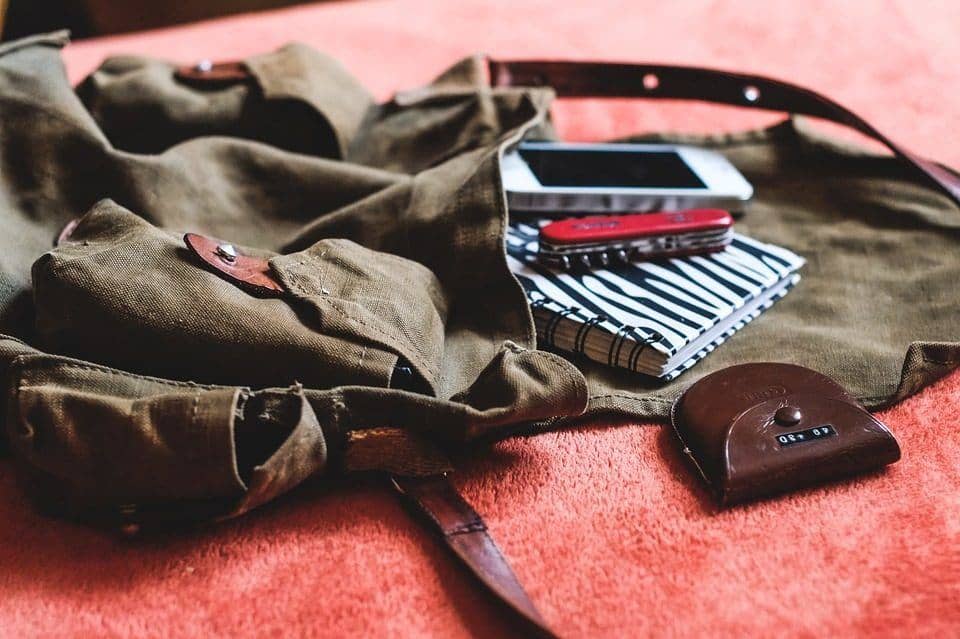
Keep the removed items in a Ziploc bag so they can go back in their original place once the bag has been cleaned and dried. This way, you will not have to look for them all over the place once you need them. Also, this would be a good time to clean these items (hand towels, handkerchiefs, water bottles) so that everything you carry the next time is fresh and clean.
Check the Backpack Label
Most backpacks come with labels with washing instructions on them. These are to make sure that you don’t end up damaging your backpack while washing them, and they will also inform you whether your backpack can be put into a washing machine or not. Most of the time these labels can be found inside the bag along the zipper.
Read these labels carefully, as they contain useful information about your backpack. It will usually contain information whether your backpack is water resistant or not . In the scenario that your backpack does not have a label, you should test out your washing agents on a small area to see if they adversely affect the fabric of your backpack. If it does not, you can go ahead with it, but if you see a change in color, you may want to replace the cleaning agent with something milder.
Prepare the Backpack

If your bag has a metal frame inside it, remove it. A few models have a removable metal frame at the back for support. This frame should be removed before you start washing your backpack. If your backpack has any other detachable pockets, remove them and soak them for washing separately, so that the entire bag gets a thorough cleaning. You can also take this time to snip off any loose threads that may have been bothering you. This will ensure that your backpack does not sustain any more damage during the washing.
Use a Stain Remover
Do this if your backpack has stains which won’t go with ordinary dusting. For these, you can use a stain or grease remover. Spray it directly on the stain and use an old toothbrush to scrub as much stain residue as you can. Let the stain remover be on for another 30-40 minutes. This way, most of the stain will be gone once the bag is being washed. Alternatively, if your stains are not very old, you can use a weak solution of water and some liquid detergent on the stain, and scrub it with the toothbrush.
Use Lukewarm Water
Fill your bathtub (if you have one) or a large tub or your laundry sink with lukewarm water. This should be large enough for your backpack to be soaked in as you lay it out flat. Make sure the water is lukewarm and not hot, as hot water can either wash away or bleed the colors on your backpack (if you have a multi-colored one, this could ruin your backpack), or it can lock the stains in.
Use a Gentle Detergent
You want to use a gentle detergent that has no dyes or fragrances on your backpack. Any harsh or industrial chemicals can have an adverse effect on the fabric of your backpack and maybe chip away at the waterproofing that it has been coated with. Also, you want your backpack to smell neutral (because if you are a trekker, you would not want to smell strong detergent for hours on end).
Submerge the Bag (Or Not)
Lay out your backpack in the water (or not, if the washing instructions forbid it), and use a rag to clean away the dirt. You can alternate between a rag and a hard brush, depending upon the fabric of your backpack. If it is made out of canvas, for example, you can go ahead and use the hard brush. If it has a lot of mesh, use a sponge. For hard-to-reach places, you can use the toothbrush. You can take as long as you want with this process until you are satisfied that the dirt is being removed.

Rinse Thoroughly
Once you are done using soap, you will need to thoroughly rinse the backpack from as much soap as you can. Try and wring out as much water as you can, without damaging the shape of the bag. If you are afraid you will do that, you may want to lay it out on a towel and wrap the towel around it, and let the water be soaked. This way, you can get rid of large quantities of water.
Drying the Backpack
Now that you have rinsed the detergent and water out of the backpack, all you need to do is to hang it outside in the sun and let it dry. Hang it upside down if that is possible and leave the pockets hanging out and turned out as well. Let gravity work for you! Make sure the backpack is completely dry if you have plans to store it so that there is no formation of mold and you can avoid a nasty surprise when you need to use the bag again.
Machine Washing the Backpack
The preparation to the point until you put your backpack in the washing machine is the same as washing it manually. Steps 1-4 (until using the stain remover) are the same. Once you have removed or weakened the stains, it is time for your backpack to go in the washing machine.
Using the Washing Machine
Preferably, do not put the backpack as it is in the washing machine. If you have an old laundry sack, put the backpack inside it and then put this into the washing machine. The laundry sack will keep the dangling zippers or any other strings safely inside and prevent them from getting tangled inside the machine and causing any damage to the machine and the bag. If you do not have a laundry bag, you can turn the backpack inside out for the same effect.
Use a liquid, gentle detergent, and set the washing machine temperature to either cold or warm water. Use the gentlest setting on your washing machine. After each spin cycle, the bag could be bunched up. You may need to straighten it out a few times before starting the spin cycle again.
Drying the Backpack

If your backpack is already turned inside out, all you need to do is hang it upside down on a clothesline, preferably upside down. This will ensure that all the residual water will drip out gradually. You can do this indoors, but it is recommended that you do it when then the sun is out.
This will ensure that all the moisture inside the bag is evaporated and that stops mold from forming. As before, you will have to wait until the backpack is completely dry.
Conclusion
If you have followed all the instructions, there is a good chance that you now have a clean bag. Once your backpack is clean and dry, you may need to treat the zippers by lubricating them so that they do not rust. This is as easy as running a crayon or a paraffin candle over the length of the zipper. Also, you don’t have to wash your backpack on a regular basis; cleaning it once or twice a year is great too. This is because excessive washing can damage the fabric of your bag and damage its water-resistant coating, if it has any.
-
TRALVE BAG
Ahh, the modest duffle bag. Evoking images of business folks walking down cobblestone streets discussing literature and debating the ideal level of tannins in wine…Or, maybe, gym rats, military personal, or rugged outdoor enthusiasts.
Whatever image duffle bags bring to mind, there’s no question that they’re a staple of the travel world. Their versatility, packability, and overall simplicity have endured the test of time. Seriously, some say duffles have been used since the 17th century (!).
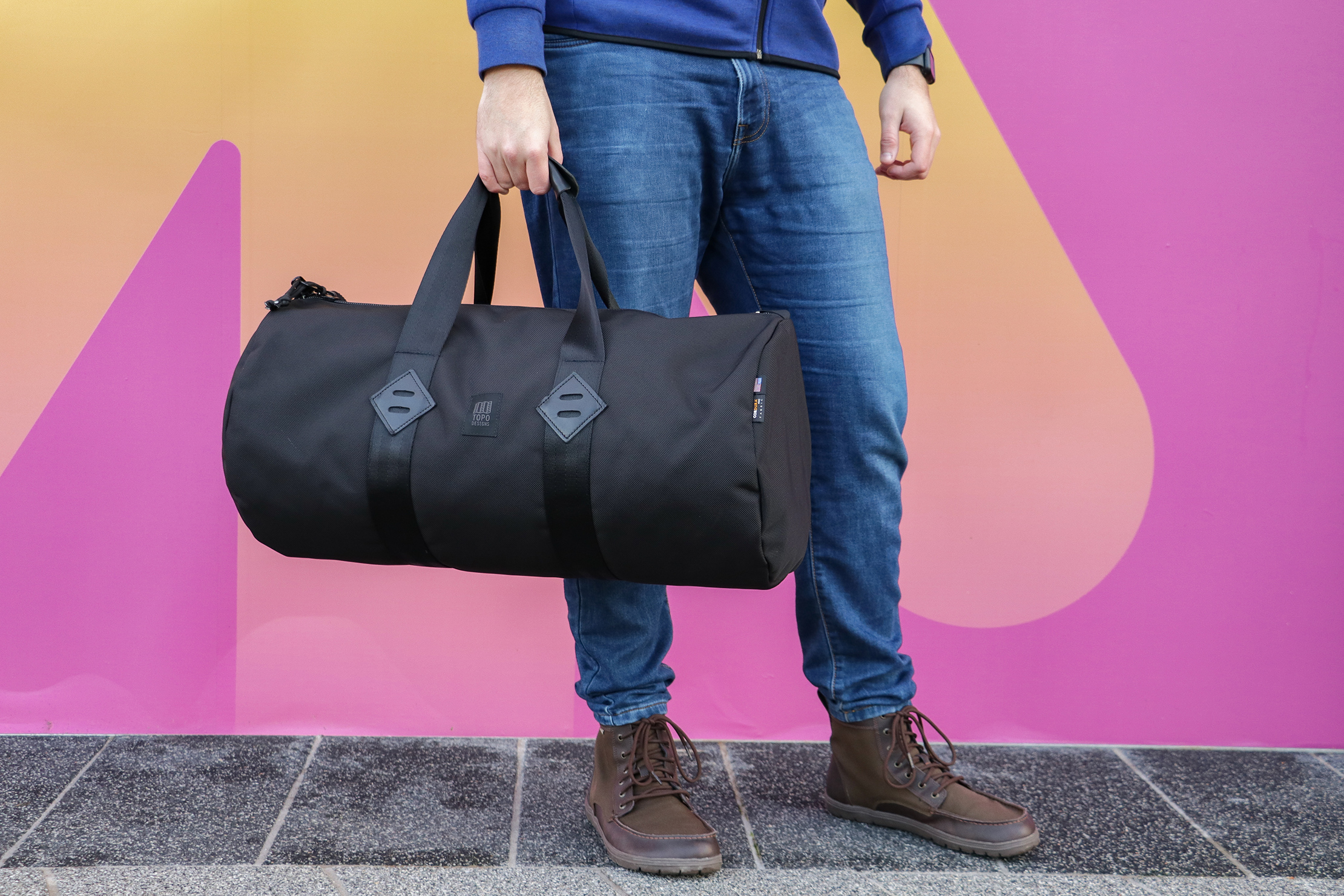
But the duffle (also spelled duffel) is so much more than it used to be. Today, you can choose from massive duffles, waterproof duffles, duffles with wheels, duffles with backpack straps, laptop duffles, weekender duffles…In a world with so many options, how are you supposed to choose the right one? It’s easy to get lost in the duffle shuffle.
First of all, take a deep breath. That’s right. And another one.
Remember, what works well for some people will be not-so-great for others. Who knows, maybe your future favorite duffle bag hasn’t cracked our top ten. So, if you have the time, we highly suggest reading on (and not only because there are some hilarious jokes ahead of you).
Why a Duffle Bag?

These days, there are so many ways to haul your stuff—roller luggage, backpacks, messenger bags, duffles, and bags that are some combination of all of the above. So why choose a duffle bag?
Duffles Are Ideal For Two Bag Travel
As you may have guessed, two bag travel is traveling with two bags. It can play out in a few different ways—a backpack and duffle, duffle and roller luggage, or duffle and duffle. (Really, it doesn’t need to involve a duffle at all, but this is a duffle bag guide so we’re going to ignore all those other possibilities.)
Essentially, you shove your clothes and other gear into the larger bag (usually the duffle) and your laptop and other “daily essential” items into the smaller one (like a daypack).
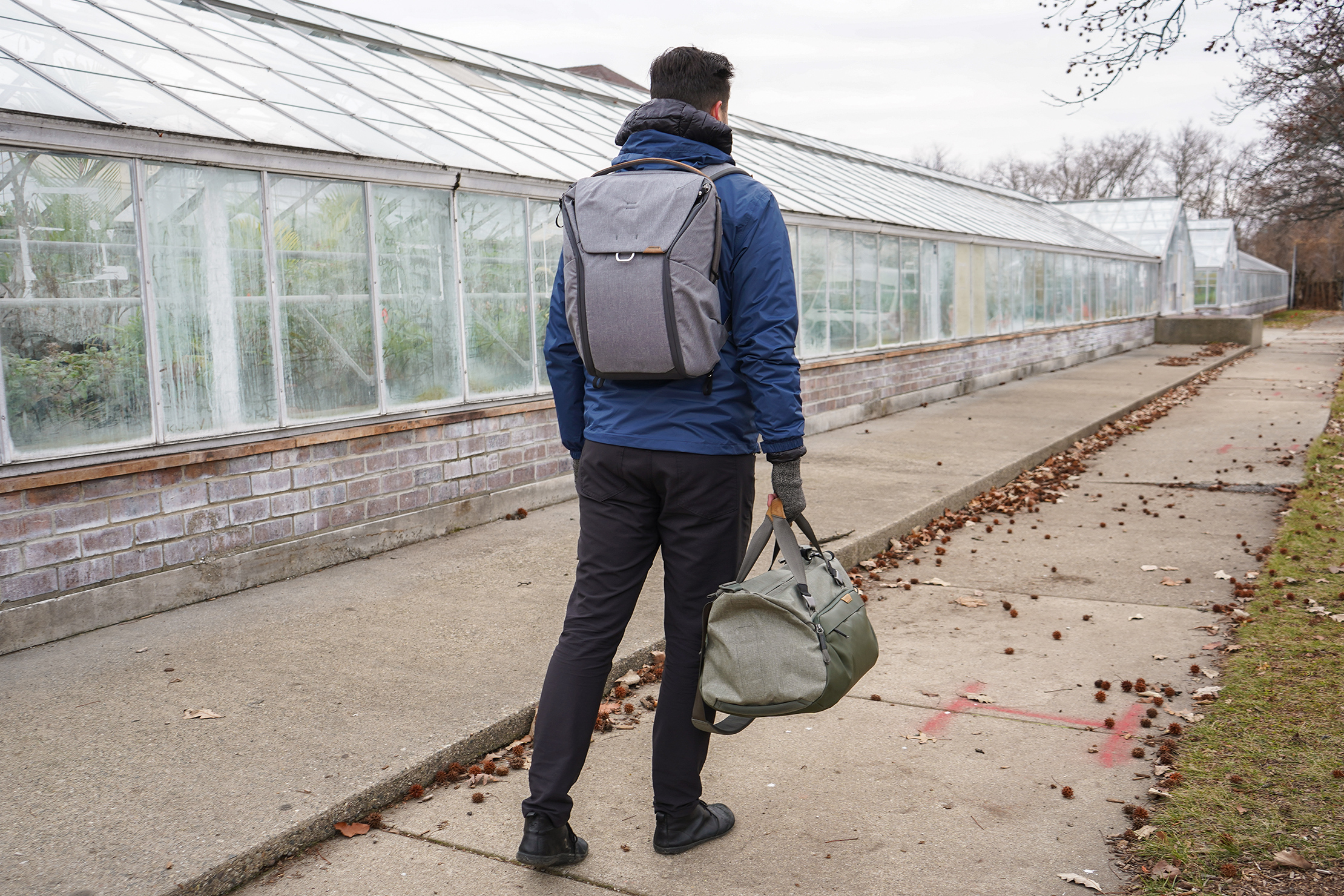
Some companies have designed their bags with the two bag travel system in mind, so you can pick up a duffle and backpack that complement one another. For example, the Tortuga Setout Duffle Bag is intended to be used with the Tortuga Setout Laptop Backpack.
Duffles Make Great Road Trip Bags
Duffle bags—most of them, anyway—are good at squishing. That means they’re pretty dang good at squeezing into the random nooks and crannies left over when you’ve packed your car full of everything you’ll need for an epic, worthy-of-the-big-screen road trip. You can throw them on top of each other pretty easily too. Plus, duffles can hold a lot without much fuss, so you can worry less about optimal packing and enjoy the wind in your hair (metaphorically or literally).
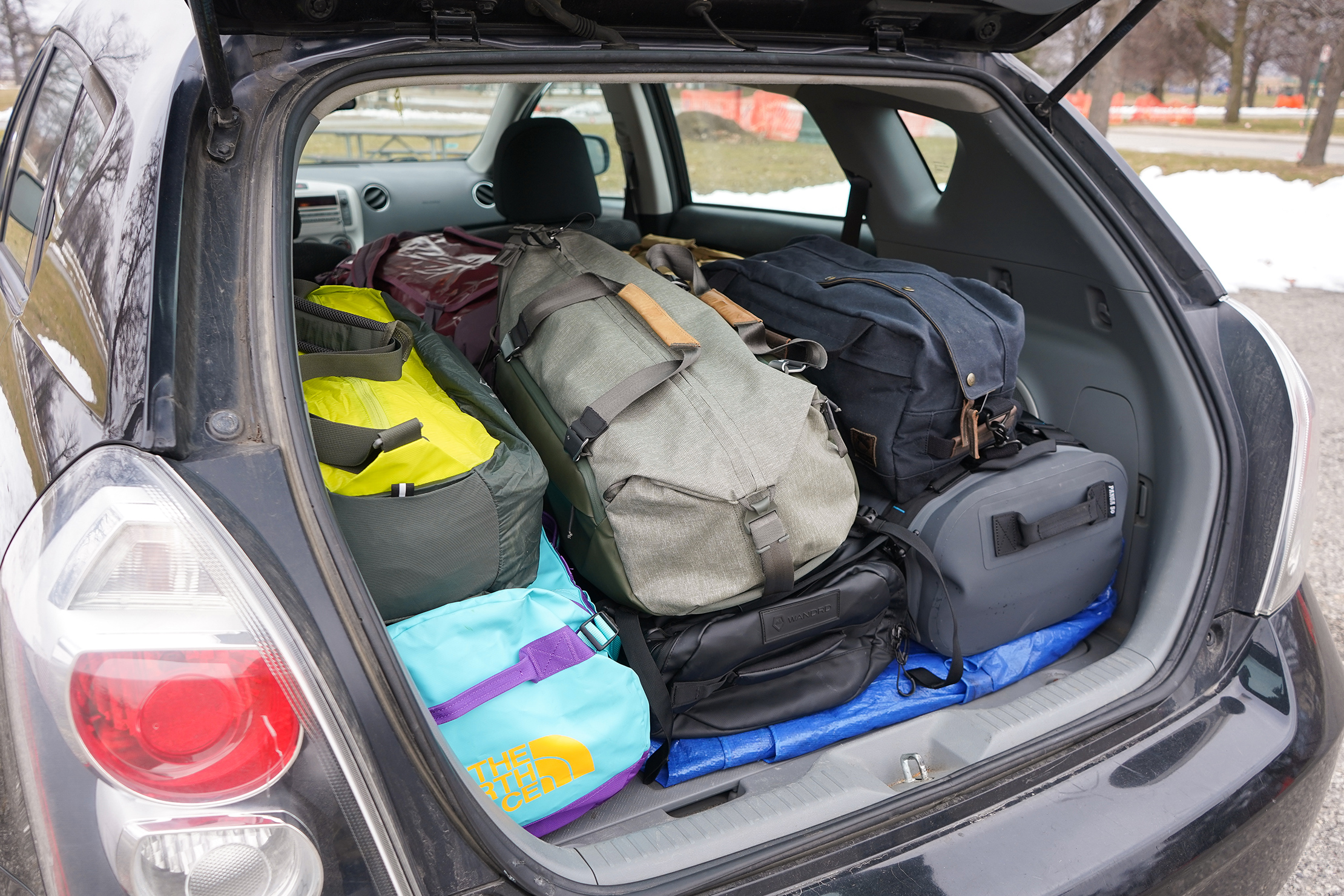
Duffles are Easy
If you have a lot of stuff and zero patience to organize said stuff, you will love a duffle bag. Simply throw all of your unfolded clothes into the main bucket, zip it all up, and you’ll be good to go.
Duffles Can Look Professional
It can feel awkward to stroll into a business meeting dressed in professional garb…wearing a backpack. Duffle bags tend to look a little more polished.

Of course, this isn’t always the case. Some duffle bags look way less sophisticated than some backpacks. But head-to-head—professional backpack versus professional duffle—the duffle usually wins.
Duffles Are Budget-Friendly
There are many, many exceptions to this (looking at you, Gucci), but often you can find quality, spacious duffle bags at affordable price-points.
Because You Like Duffles
You don’t have to have a specific reason for liking duffles, maybe you just like them. If so, go for it.
As we said earlier, we firmly believe there is no such thing as the Perfect Travel Duffle. There are a few key considerations you should keep in mind to find the perfect travel duffle for YOU, which we discuss below. We’ll keep coming back to these considerations throughout the guide, so pay attention! (There may or may not be a quiz.)
Your Use Case
Obviously, your use case will have a massive impact on what duffle you should choose. There is no single duffle bag that will work for every occasion. Ask yourself why you want a duffle bag and what you plan to do with it before looking at any other factors. All of the other considerations play into this one.

Examples of common use cases:
- Weekend trips
- Long term travel
- Business travel
- Beach tote
- Gym bag
- Everyday carry bag
Materials & Durability
Duffles tend to get thrown around a lot. Airline workers have time restrictions, so you can be sure they’re tossed around in the bottoms of planes and—be honest with yourself—you’re probably not so gentle with them either. So make sure you purchase something that’ll last.

Likewise, you will need a more durable duffle if you’re an outdoorsy/adventurous person. Durability is not as big of a concern if you just plan to take your duffle on weekend excursions to the city a few hours driving distance away.
Consider:
The Fabric
When looking at fabrics, you’ll often see a number followed by the letter D (50D, 250D, 1000D, etc). The D stands for denier, which measures the thickness and weight of fabric (okay, truth be told it’s a little more complicated than that, but that’s the gist of what you need to know).
The higher the denier within the same fabric family, usually the more durable, but also the heavier the fabric. Note that denier won’t help you much when comparing two different types of fabrics, which all have inherent strengths (nylon is stronger than polyester, for example). But it works well as a benchmark.
Nylon

Nylon is one of the most common synthetic fabrics—and for good reason. It manages to be soft, durable, and lightweight. These days, nylon is almost an umbrella term. Various weaves, sewing patterns, and deniers play into nylon’s overall strength, weight, abrasion-resistance, and weather-resistance.

Within the nylon family, you’ll commonly see ballistic nylon and ripstop nylon. Ballistic nylon is basically the Superman of the fabric world (The Fabric of Steel, coming soon to a theater near you). Originally developed for military body armor, it’s durable and resistant to pilling and water. But it is heavier, which is not ideal for a duffle bag since they tend to get uncomfortable at lower weights than backpacks. The tradeoff may be worth it if you have an adventurous travel style or want your duffle to last long enough to pass down to the next generation.

Ripstop nylon, on the other hand, is also a great fabric that prevents punctures from spreading into full-on tears—something exceptionally handy to have for a duffle bag. Duffles are often tossed around, jammed into random nooks and crannies, and/or dragged across floors, meaning there’s a good risk of puncturing it. Having a fabric that prevents those punctures from ruining your bag is key. Plus, ripstop is lightweight.
That said, it’s not always as robust as higher denier fabrics like 1680D Ballistic nylon. If it’s a lower denier, it may develop holes more quickly. If so, the ripstop will save those holes from spreading and ruining the duffle, but the fabric will still have holes in it. Also, it’s usually swishy, which may be a deal-breaker for you.
Polyester

Another popular synthetic fabric, polyester tends to be a little less durable, a little bit heavier, and a little bit cheaper than its cousin, nylon. All that to say, you’ll usually find polyester on budget duffle bags. It’s not a bad fabric, but it’s not our favorite for duffles. Especially if your travels involve asking a lot of your bag.
CORDURA® Grade Fabrics (Nylon & Polyester)

CORDURA® is a brand, not a fabric, but it’s worth discussing since you’ll probably see it a few times. Plus, casually mentioning CORDURA® fabrics at a party will let everyone know just how cool you are (it’s worked for us!).
Essentially, the CORDURA® label is a stamp of quality assurance that says that the nylon or polyester has come from a CORDURA®-approved mill and production line. Anything CORDURA® will have excellent abrasion-resistance and strength-to-weight ratio.
Canvas

Historically canvas is made from cotton, linen, or hemp and then coated in wax for waterproofing. You can currently also find nylon and polyester canvas, too. These days, canvas isn’t super common because it tends to be heavy and susceptible to aesthetic wear and tear (like scuffing).
That said, there’s something so classic about a canvas duffle. If you’re into that heritage, historical vibe, it may be worth sacrificing some comfort.
Leather

And that brings us to leather—another fabric that evokes a sense of nostalgia and sophistication. You don’t often see pure leather duffles for obvious reasons (weight, sensitivity to the elements, maintenance required), but several duffle bags have leather accents—zipper pulls, straps, logo tags, and things like that.
Leather tends to go hand-in-hand with canvas. And may be your fabric of choice if you love that heritage look. (If you try to avoid animal products, you can also find duffle bags made with vegan leather to mimic that same bespoke feel.)
Duffel Fabric
Okay, you’re not going to find duffel duffle bags pretty much anywhere, but we wanted to mention it because this coarse woolen fabric is the OG duffle bag fabric. Duffel fabric originated in Duffel, Belgium, giving the duffel (which we now commonly spell duffle) its name. Mind-blowing, right?

You may also run into Tarpaulin or TPE Fabric Laminate, which are swishy fabrics that tend to be coated in a layer of Polyurethane. While both can have a crinkly, plasticy feel, they’re also very weather-resistant and durable. Water-resistance is really nice to have on a duffle since you tend to set down on the ground more than backpacks (a ground that could be wet). For that reason, we’re usually big fans of duffle bags made with these fabrics.
This isn’t a comprehensive list of all of the fabrics you’ll run into while searching for The One (by which we mean your perfect duffle, obviously), but a majority of duffle bags will be made with one or multiple of the materials mentioned above.
The Zippers
Okay, it’s time for some #ZipperTalk. For being so small, zippers are super important. Imagine throwing your stuff in your duffle minutes before you need to leave for the airport when—suddenly—thunder booms and the main compartment’s zipper breaks. A broken zipper on a duffle bag isn’t as heartbreaking as on a backpack because you can still use a duffle with a broken zipper due to its placement on the top of the bag. That said, it’s still sad and inconvenient.

Look for YKK, SBS, Zoom, and Riri zippers, which are the most common and reputable brands (we’re particularly fond of YKK zippers, which have rarely let us down over years and years of testing). And be wary of unbranded zippers—we’ve had some not-so-great experiences with them.
Also, pay attention to size. Zippers are measured on a scale of one (small) to ten (large). You should be alright with #5 zippers and greater for exterior pockets on smaller duffles, while you probably want something slightly more robust on larger duffles. Smaller sizes are okay for internal pockets or less frequented ones.
Finally, zippers can play a role in the water-resistance of the duffle. Reverse-coil zippers (usually marked with an RC next to the size) add some water-resistance, though water will get through them.

For extra weather-protection, there are water-repellent zippers—like YKK AquaGuard® zippers—which repel water due to a polyurethane coating. You don’t need to worry about highly water-resistant zippers unless your use case (#callback) involves traveling to places known for inclement weather, boats, and/or beaches. Note that water-repellent zippers tend to be harder/stickier to zip, so if your travels don’t involve copious amounts of water, we suggest avoiding these zips. (We will discuss weather-resistant duffles in more detail in the Alternate section of this guide.)
The Hardware
Similar to zippers, you’ll be pretty disappointed if any of the hardware on your duffle bag breaks while you’re out of the country.
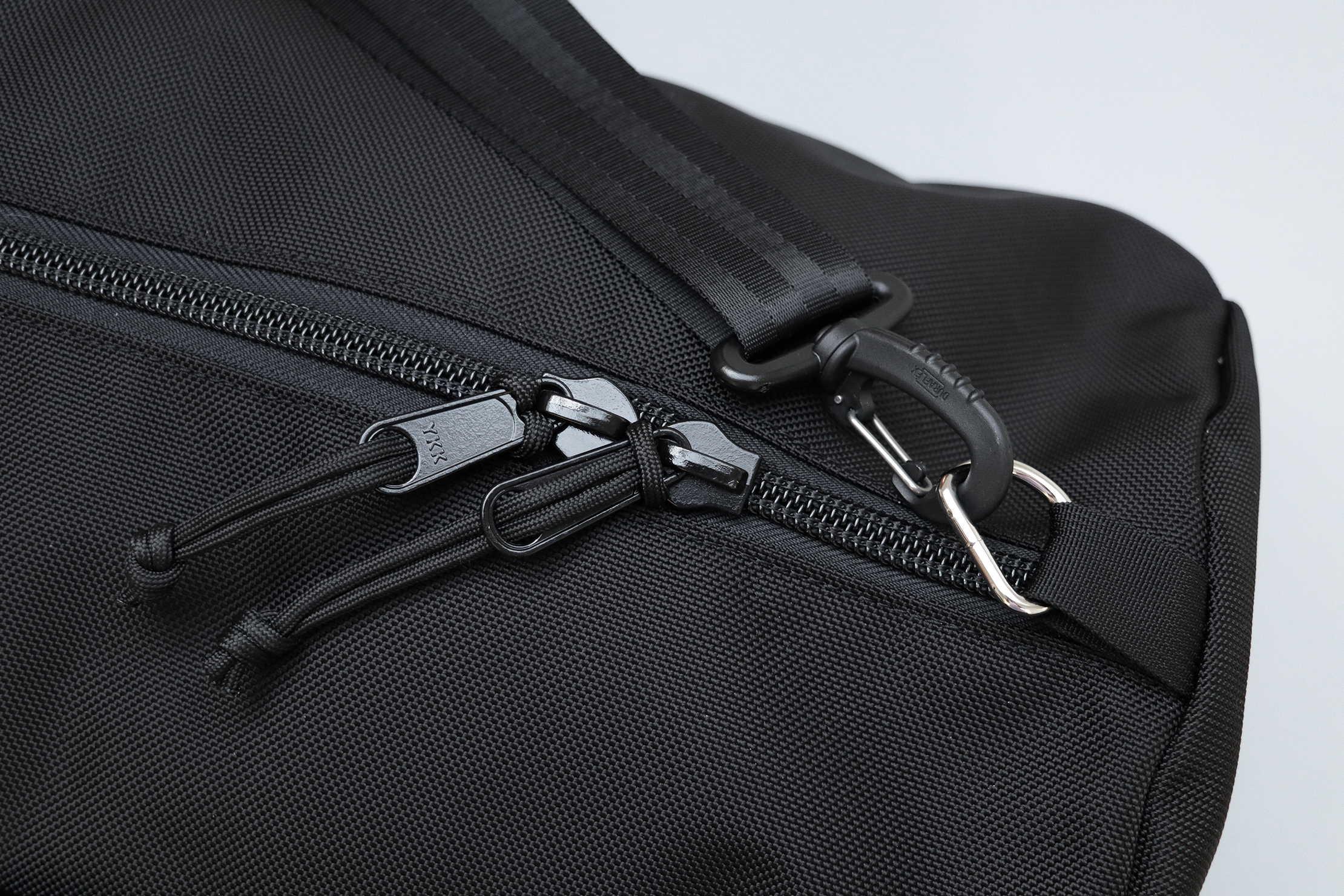
Again, do your best to avoid unbranded hardware. Duraflex, YKK, Woojin, Nifco, and ITW are all good brands that should treat you well. And, when it comes to metal versus plastic hardware, we’re partial to the former. Particularly from a durability perspective. Although if you’re trying to cut ounces, plastic may be the way to go.
Interior Organization
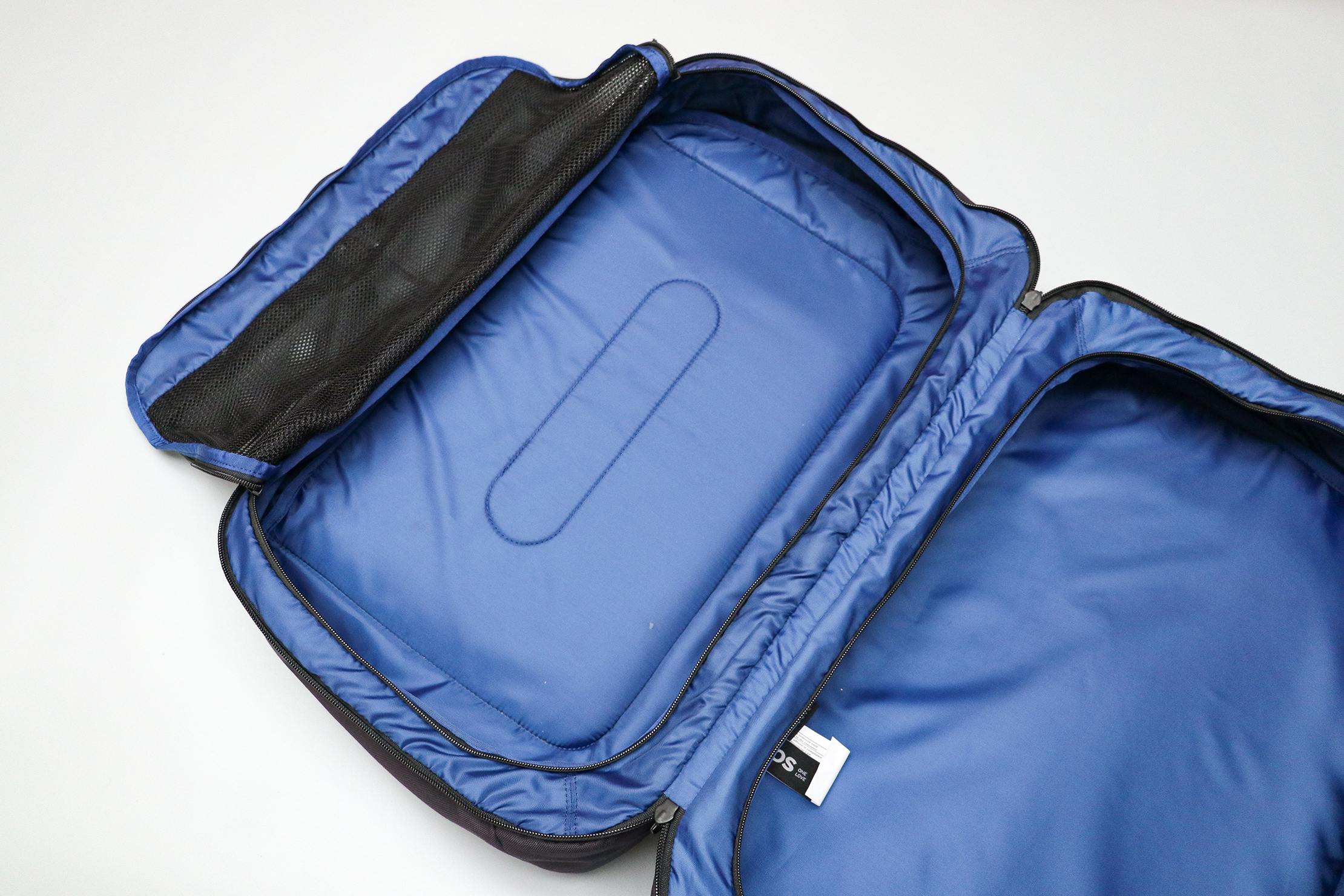
Duffle bags run the gamut of organization. Some have zero organization, while others have a ton of pockets and compartments. Are you planning to use your duffle as more of a gear hauler, throwing your clothes and toiletries in it while organizing everything else in a backpack? Or do you want your duffle to be the only bag you need? Your answers to those questions will tell you how much organization you’ll want.
Mode of Carry
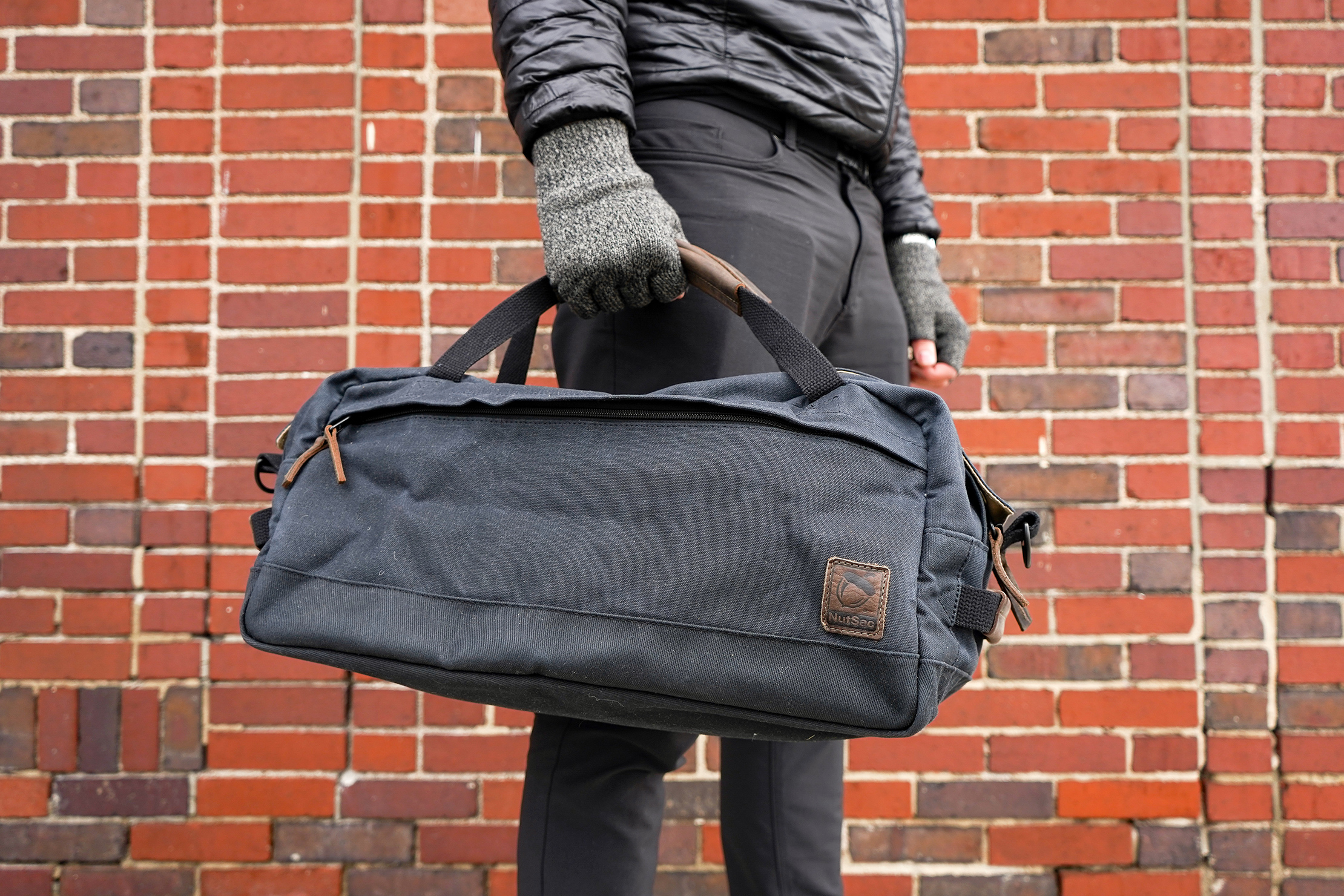
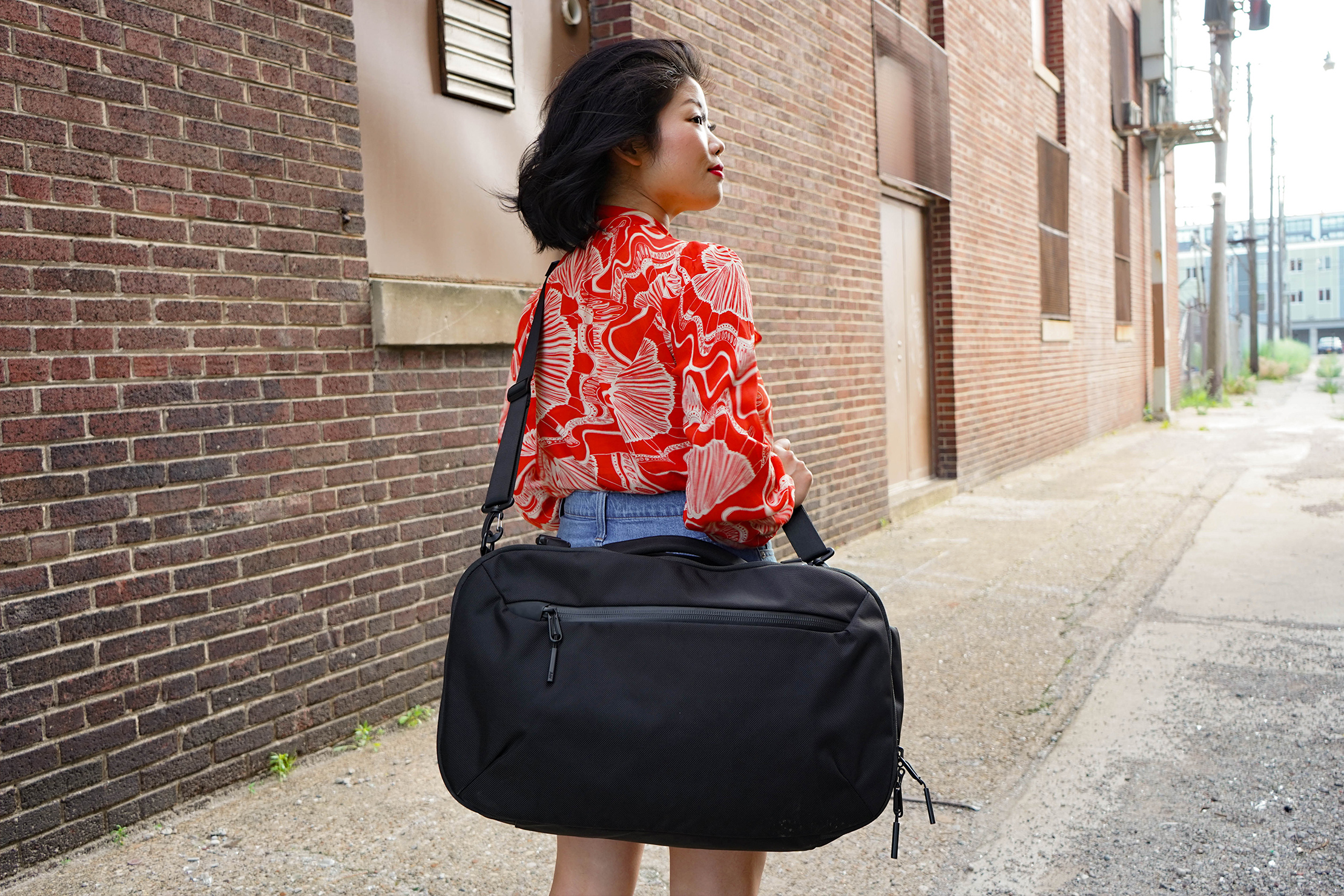
But not all crossbody straps are created equal. While a simple, seatbelt style of strap is okay for smaller duffle bags, padded straps are preferable. Our favorite type of shoulder strap has thick padding that spans the entire length—or at least most of the length—of the strap. Again, how much you’ll walk with your duffle plays a big factor here.
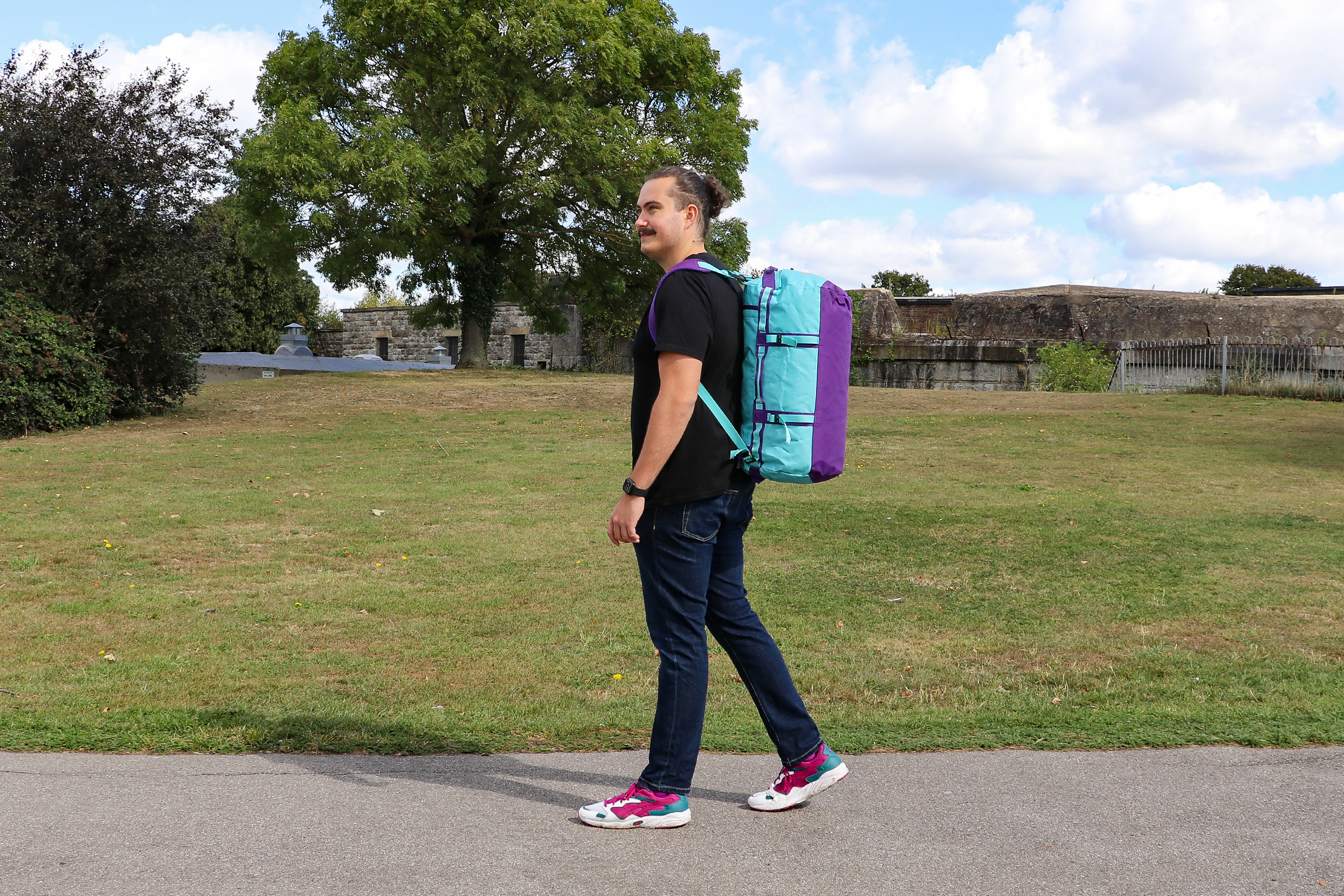
Some duffles have backpack straps. Although these straps tend not to be as comfortable as backpack straps on an actual backpack (go figure, right?). They may be your duffle of choice if you are dead set on owning a duffle but want more versatile carry options. We’ll discuss these duffle backpack hybrids later on in this guide and their potential downsides.
Finally, you have the option of a rolling duffle. Once again, we’ll go into detail about rolling duffles later on. For now, just know they’re a great option if you are unable, or simply don’t want to bear the weight of your luggage on your shoulder(s). In nearly all of the categories below, you can find duffle bags that span a huge range of sizes from 6L to 150L+. You’re not going to want to take a 6L duffle on a three week trip to Egypt (or anywhere for that matter) unless you’re extremely minimalistic. To put that in perspective, we’ve tested a 6L duffle as a lunchbox. You’re also not going to need a 150L duffle unless you’re looking for a massive, massive, massive gear hauler.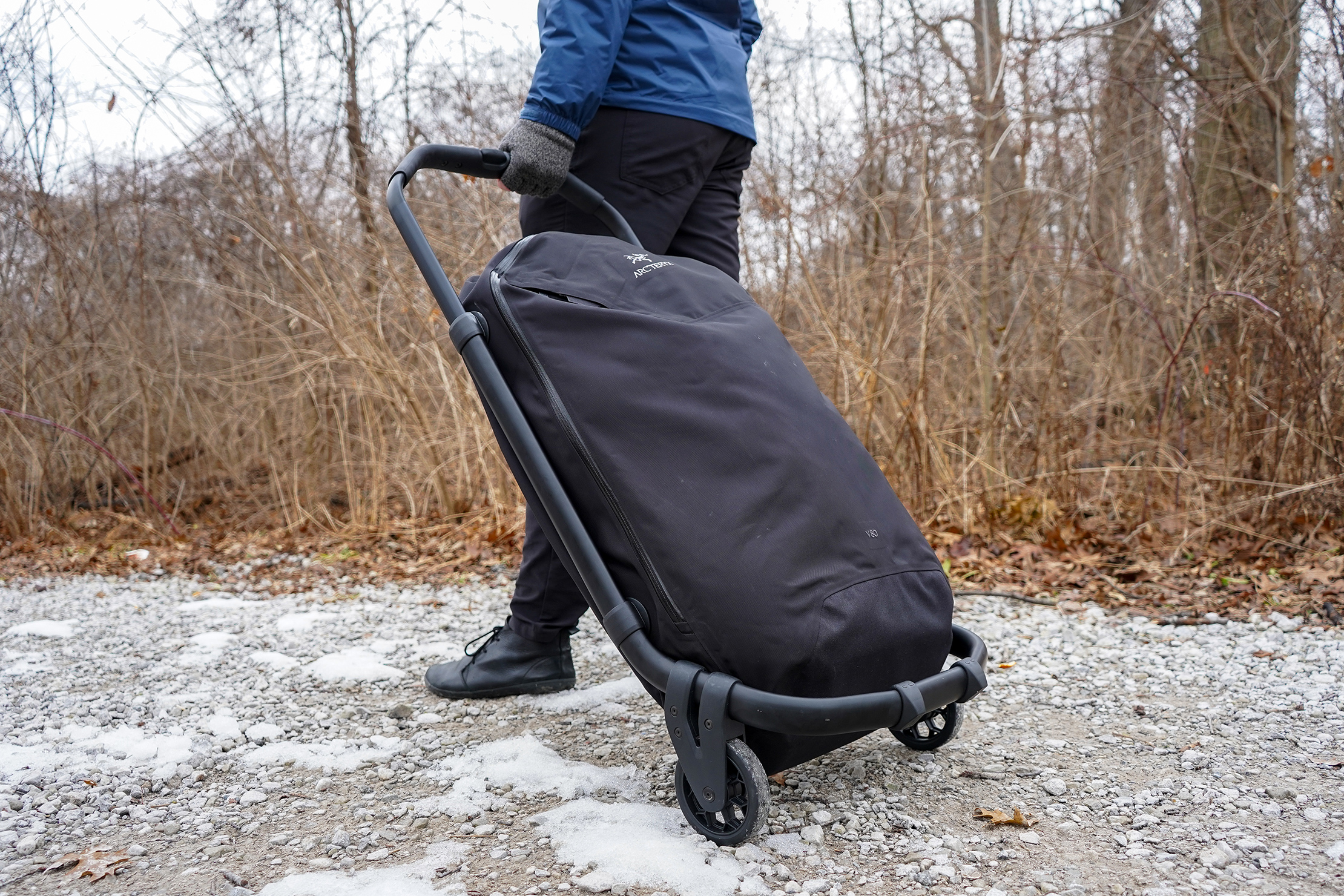
Size & Weight


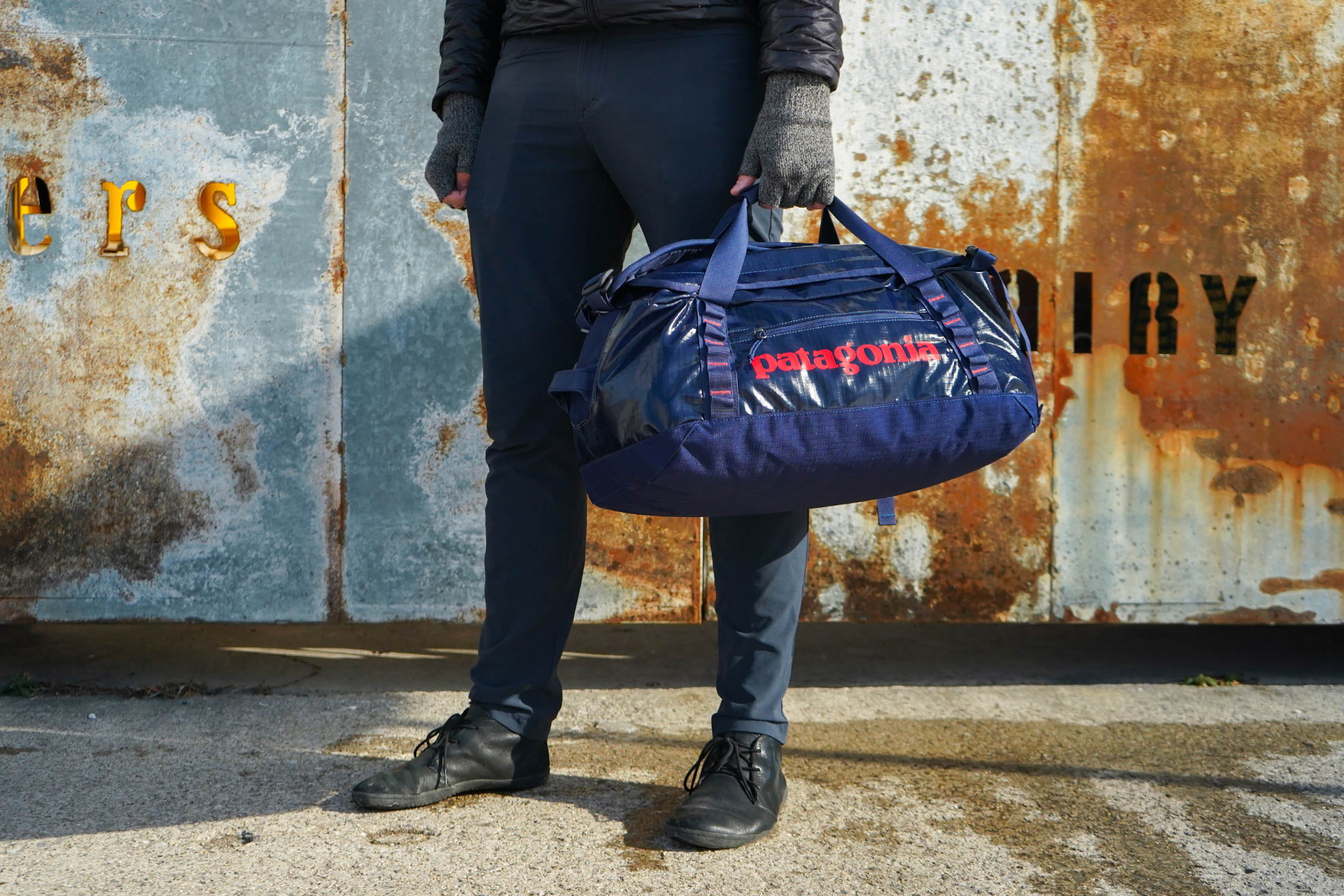
At the same time, you don’t want them to be flimsy since duffles get thrown around a lot. It can be a tricky thing to balance but don’t panic. We’ll be giving you a ton of duffle bag recommendations throughout this guide that manage to walk that line.
Some questions to ask yourself:
- Do you want to use your duffle as a carry-on? If so it’ll need to be appropriately sized.
- How much space do you need for your stuff?
- Will you be traveling with a duffle and a backpack, or do you need a duffle large enough to hold all of your gear?
- How much weight can you carry?
- What’s your body type?
- How much will you be walking?
- Are aliens already among us?
- What do plants crave?
Your Budget
This goes without saying, but you should consider how much money you’re willing to spend. Here at Pack Hacker, we generally believe in the “buy nice or buy twice” motto. In the long run, it may make more financial sense to invest in a duffle that will last you a decade instead of continually needing to replace a cheaper one (if you have the money available, of course).

That said, high cost doesn’t always mean high quality. Sometimes you’re paying for brand name or style. That’s what our reviews are for—to help you know if a duffle is worth the money.
How much you’re planning to use your duffle also comes into play here. If you’re planning to travel with your duffle bag once every other year, you won’t need to spend as much as you would if you’re planning to use your duffle every single day.
A Classic Duffle is a duffle in its simplest form. It’s the image that comes to mind when you think of a duffle—a soft-sided bag with a zippered opening down its length. The bag can be cylindrical or square, fat or skinny, or anywhere in between. And—as we alluded to earlier—these duffles come in a huge array of sizes. We suggest between 20L and 45L for carry-on travel.
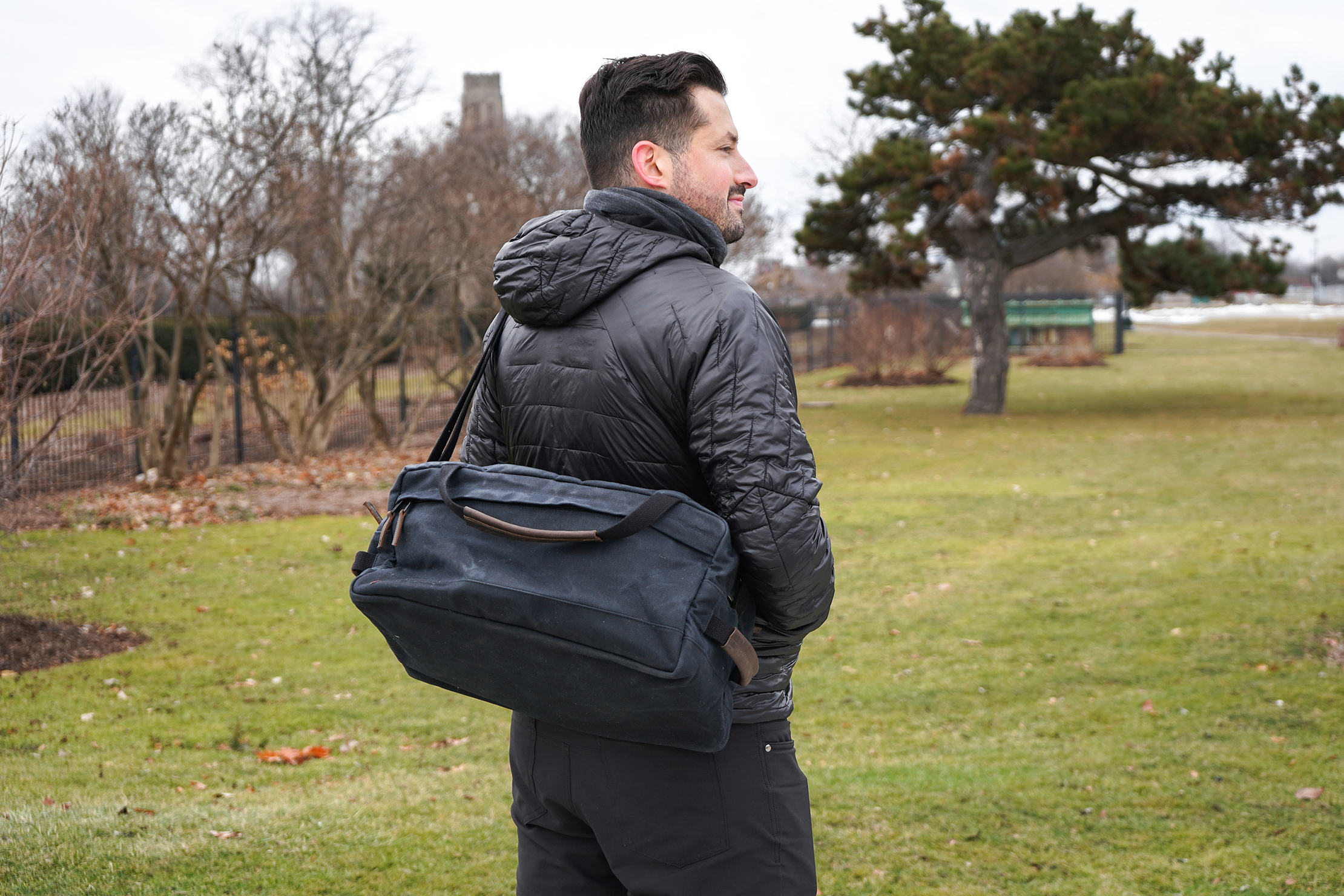
Why Classic Duffles?
There’s something so nice about the simplicity of a Classic Duffle. You don’t have to stress about optimizing how you pack, matching the proper gear to the proper pockets for the easiest access or most comfortable carry. You toss your stuff inside the bag, tug the zipper closed, and voila—you’re packed. And if you crave organization, you can always create your own system with packing cubes and accessory pouches, not limited by the organization built into the bag.
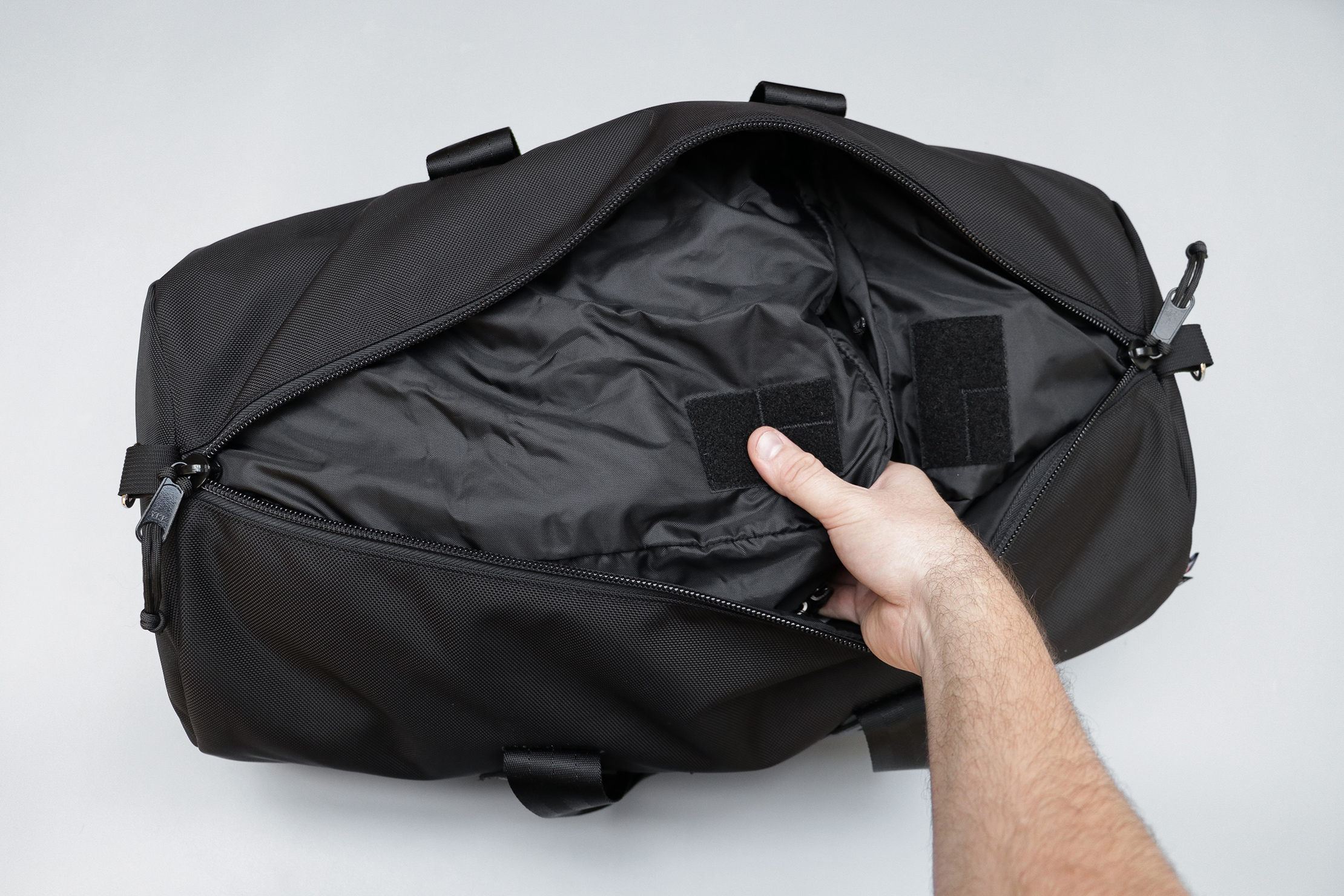
More often than not, Classic Duffles can hold a lot of stuff. We think it has something to do with the viscosity of the fabric divided by the sum of the pockets—and then, of course, you carry the one…Or it might have to do with the fact that there’s usually a big ole bucket of space in the main compartment.
Simplicity also means versatility. A Classic Duffle works for road trips, beach outings, and leg days at the gym (any day at the gym, really). Of course, it also works for air travel.
You can easily use a Classic Duffle in conjunction with a backpack—organize your tech gear in your backpack and jam your duffle bag full of clothes. In the states or on longer flights, you can bring your duffle as a carry-on and backpack as a personal item. If that won’t work, you can check your duffle and bring your backpack with you on the plane.
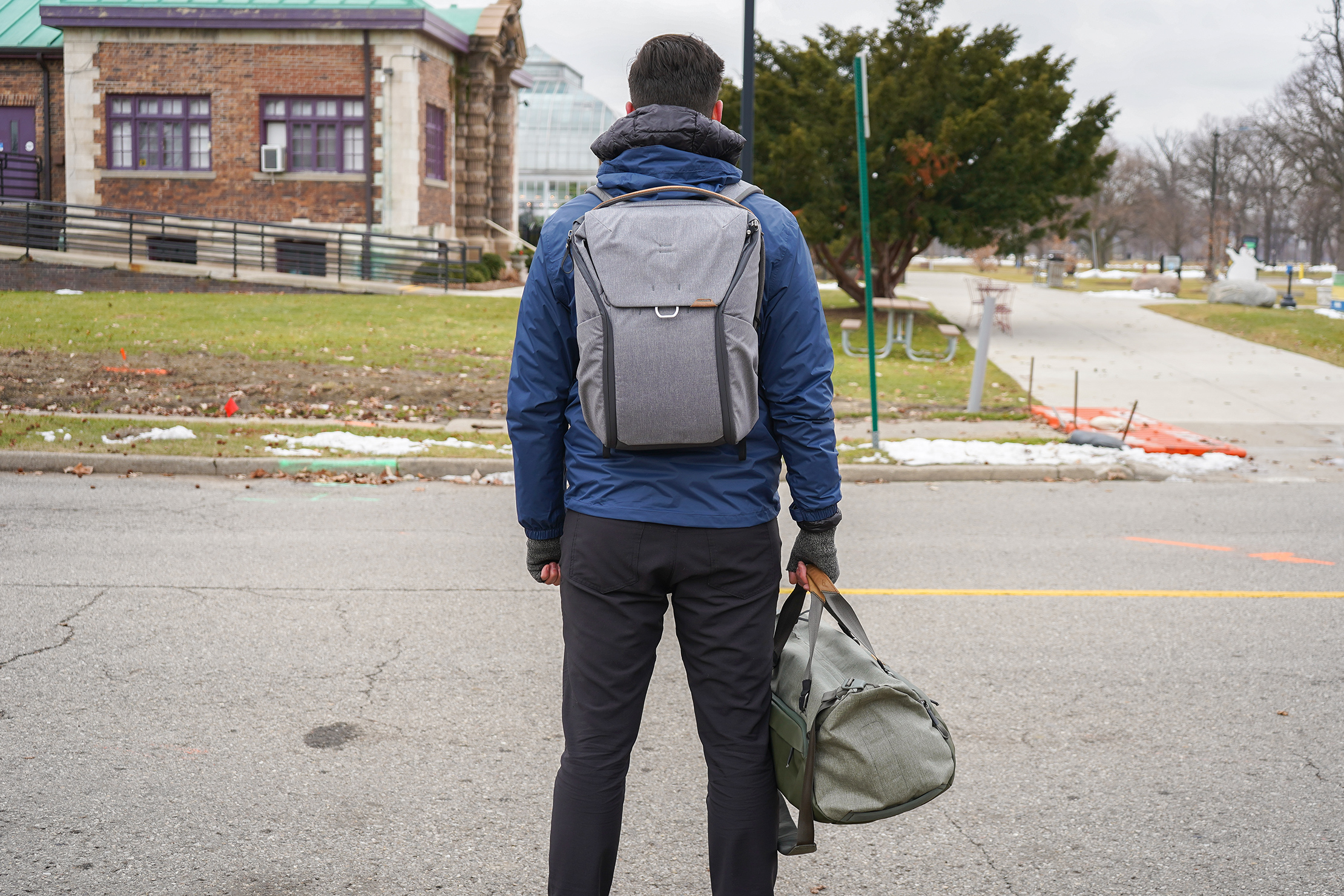
And Classic Duffles do pretty well sitting in the underbelly of a plane—unlike backpacks they don’t usually have a ton of straps and buckles sticking out that can get caught on things. Plus, stacking them with roller luggage isn’t exactly secure, so airline workers tend to put them on top of hard-sided luggage—meaning they’ll be the first out of the plane (we have an inside source who has worked as an airline baggage handler).
How to Pick the Perfect Classic Duffle
Now that you know why you may like a Classic Duffle, we’ll walk you through how to find one that will meet your needs. Before we dive in, remember that, ultimately, you need to reflect on all those considerations we mentioned in the previous section. We can tell you what’s worked for us after months of testing, but you’re the expert on your situation.
Profile
We prefer Classic Duffles that have more of an oblong shape than a square one. A wider, square top isn’t very comfortable to carry—it sits farther away from your body when you hold it by its handles. And that makes for an arm workout and an awkward shuffle. The carry handles also sit further apart from one another on a wider bag, making them difficult to grab quickly.

Your best bet is to look for a Classic Duffle that has a circular and/or slimmer profile—and this is especially true if you have smaller hands or a smaller frame.
Straps & Handles
The best carry handles attach in the center with a snap button or velcro, forming one mega-handle that’s easy to grab and pleasant to hold. A mega-handle means you can pick up your duffle and go—without any seconds lost to floppy handles that keep falling to opposite sides (is it just us or do floppy handles seem to be taunting you on purpose? Just us, okay…).
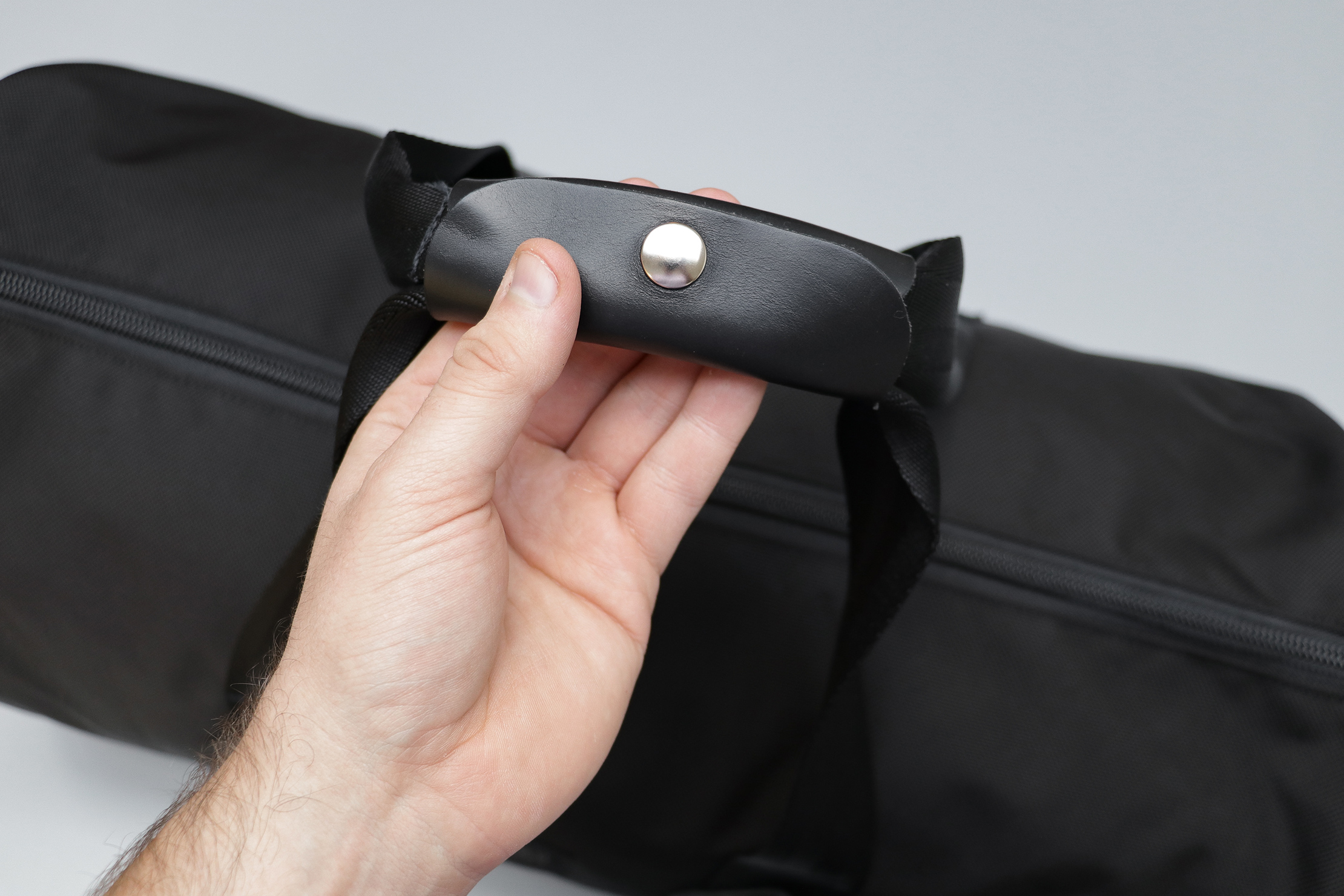
Not all Classic Duffles have an additional crossbody-style strap, but we like the ones that do. Being able to carry the bag across your body or over your shoulder while waiting to board your flight or walking to the train station is invaluable. (We’ve found that most crossbody straps on duffle bags are detachable, so you can take them off when you don’t need them. No commitment necessary.)
As we said in the Considerations section, look for crossbody straps with thick padding that spans, if not the entire length, then most of the length of the strap. A thin nylon strap becomes uncomfortable to wear when the bag is fully loaded or you have to carry it for long stretches.
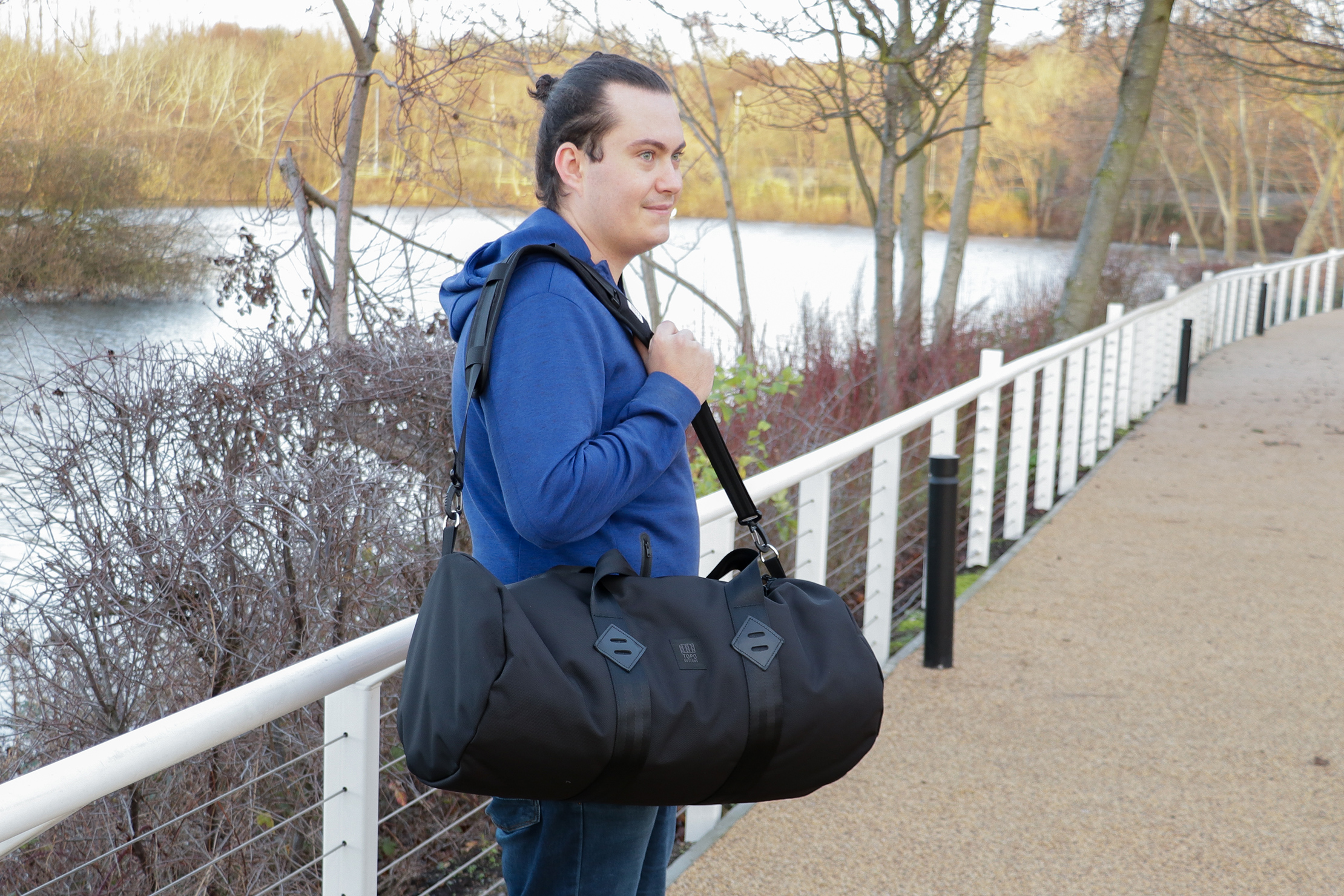
Internal Organization
We like Classic Duffles that embrace their simplicity with organization that has been designed specifically for clothes and toiletries (as opposed to tech/daily essentials). Usually, that means a couple of pockets—maybe even a couple of exterior end pockets—but nothing that majorly cuts into the space of the main compartment. If your travels involve going to the gym or traipsing along dirty trails, you’ll probably appreciate a duffle with a shoe compartment.
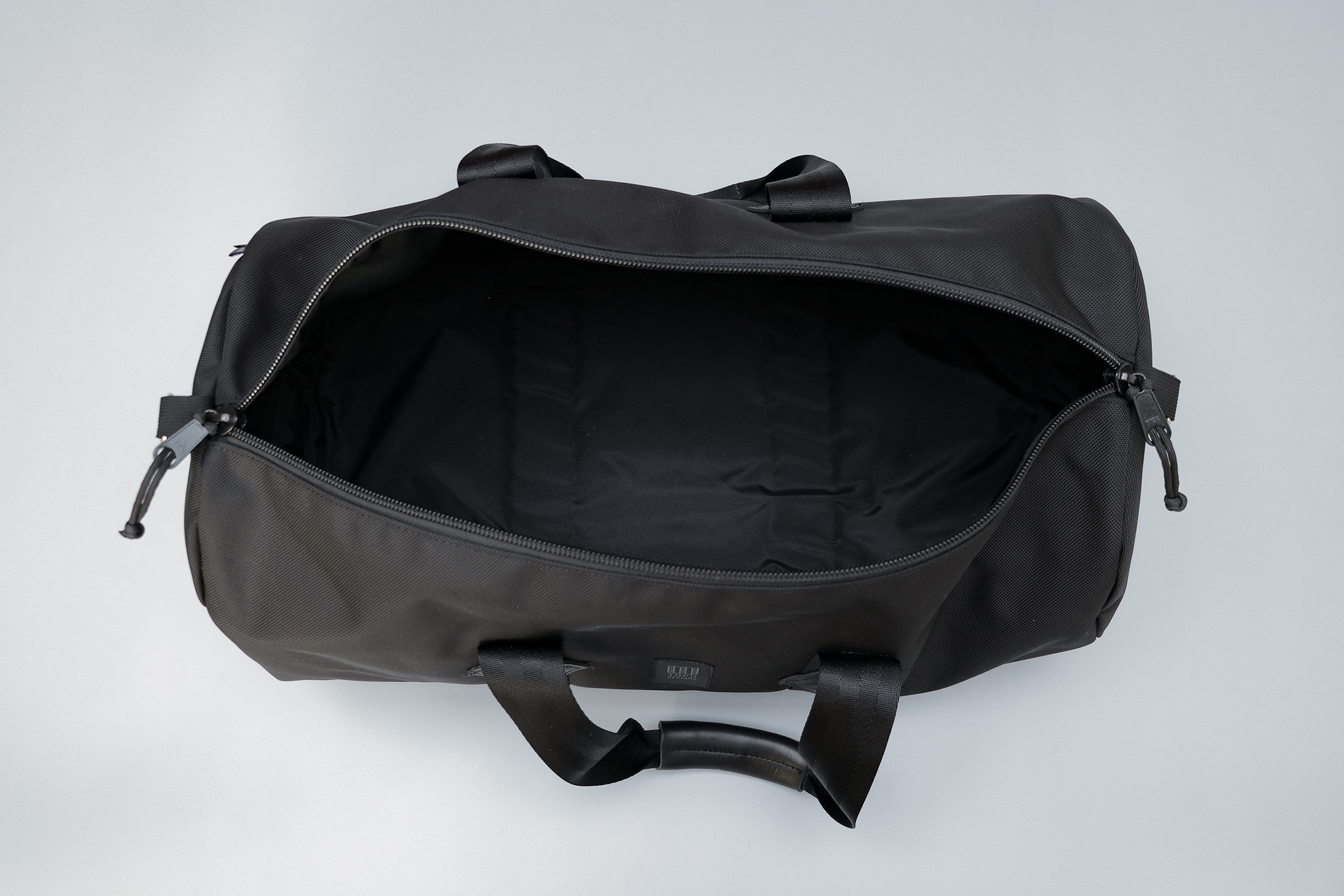
The Good
- What you see is what you get (in terms of size)
- Easy to pack and go
- Holds a lot of stuff
- Works well in conjunction with a backpack for two bag travel
The Bad
- Can get uncomfortable to carry for any extended periods (especially if it’s fully packed out)
- You’ll likely need to travel with an additional bag if you plan to bring any tech with you, including a laptop, tablet, camera, etc
- Doesn’t protect your stuff super well—you have to be careful what you pack
A Duffle Backpack—or Hybrid Duffle, as we call them around HQ—is a pack that’s attempting to be both a backpack and a duffle (buffle? duffpack?…Definitely buffle). Most of the time, buffles skew one way or another—they’re either a backpack first or a duffle first. You can get an idea by looking at the shape of the pack and the orientation of its organization. In this guide, we’ll be focused on packs that are primarily duffle bags with backpack straps.
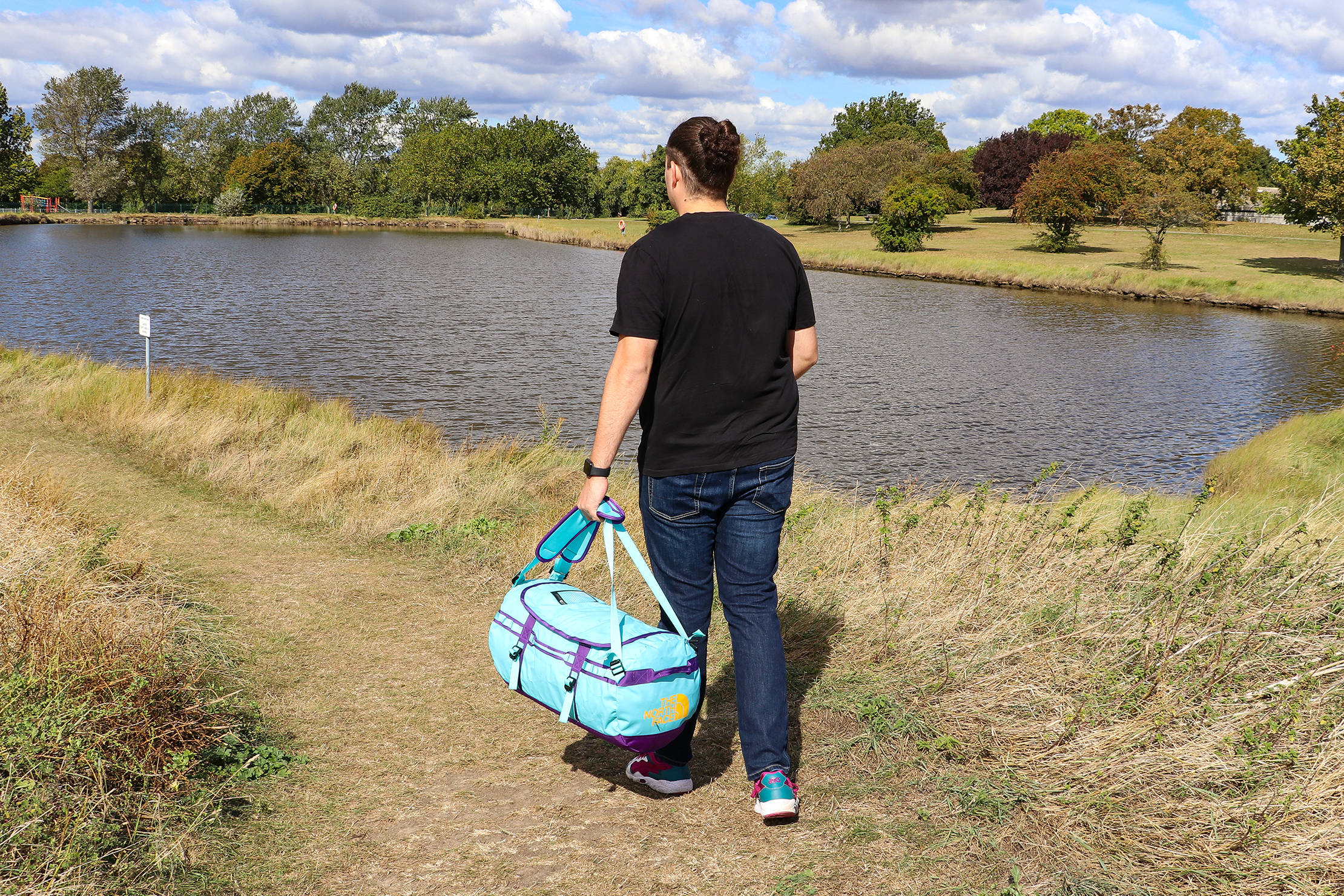
Why Duffle Backpacks?
We like the idea of buffles because they’re versatile. You get the benefits of a duffle—simplicity, durability, space—while being able to carry it as a backpack when you find yourself having to walk far (i.e. the airport to your hostel, across the terminal, etc.) BUT—
We’re going to be straight with you, while buffles are increasing in popularity, we find they’re extremely difficult to do right. (As opposed to messenger bags, which are small enough they can get away with being hybrids.) Usually, these packs end up being mediocre as both a backpack and a duffle, instead of excelling at one or the other. In general, we prefer to have an exceptional backpack or an exceptional duffle bag.
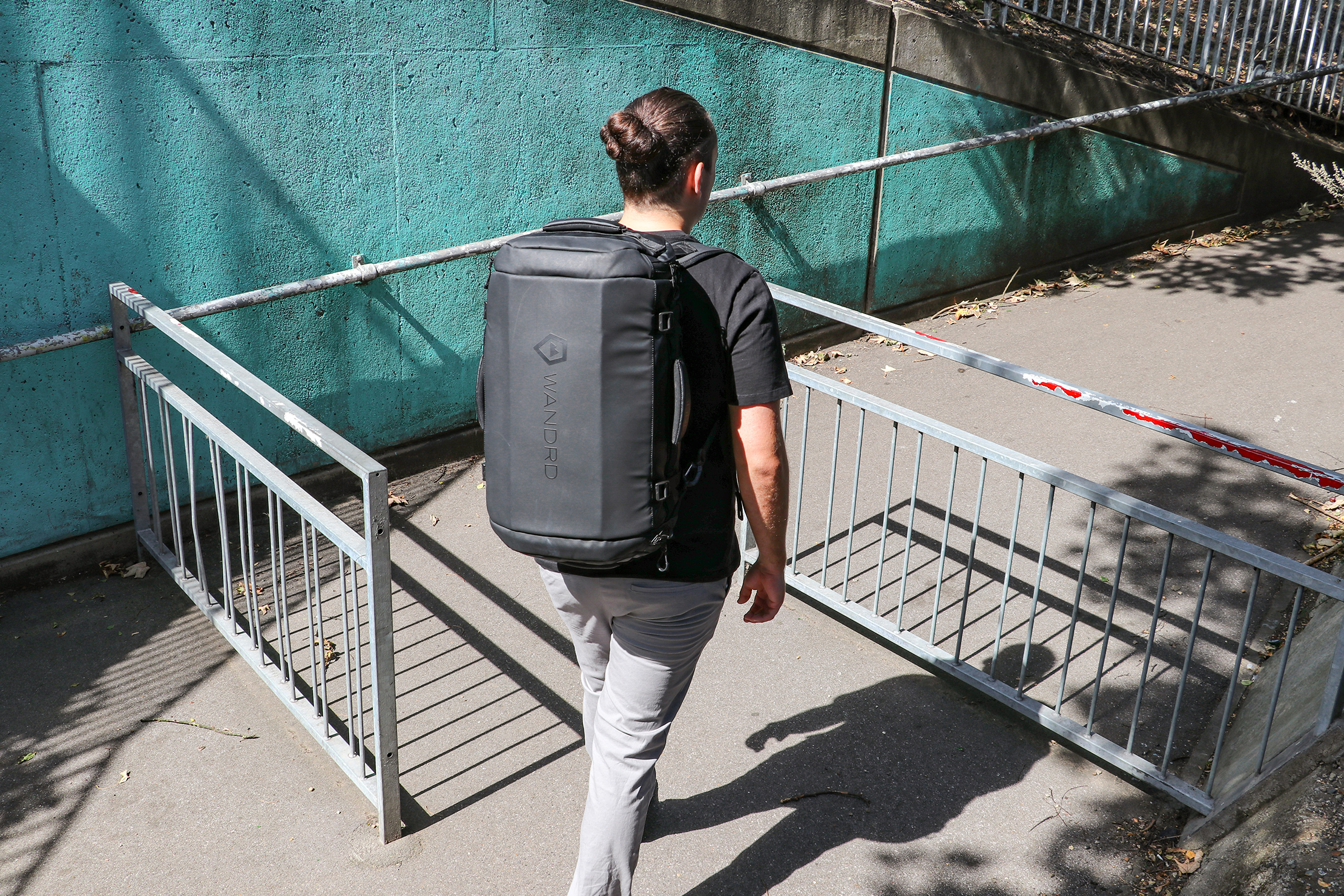
One day a company may crack the elusive buffle (we live in a time with fancy canned wine, so anything’s possible). Until then, we recommend picking either a duffle bag or a backpack (we have a guide to help you out with that one too).
That all said, if you understand the risks, and are still dying to have a Hybrid Duffle because you hate backpacks, but walk enough you would appreciate a backpack style of carry every once and a while, we’ll walk you through what you should look for:
How to Pick the Perfect Hybrid Duffle:
Profile
Similar to a Classic Duffle, a slimmer profile is better for Hybrid Duffles. Not only because the handles are closer together for an easier carry in duffle mode, but a slimmer pack will also sit nicely against your back when converted to backpack mode.
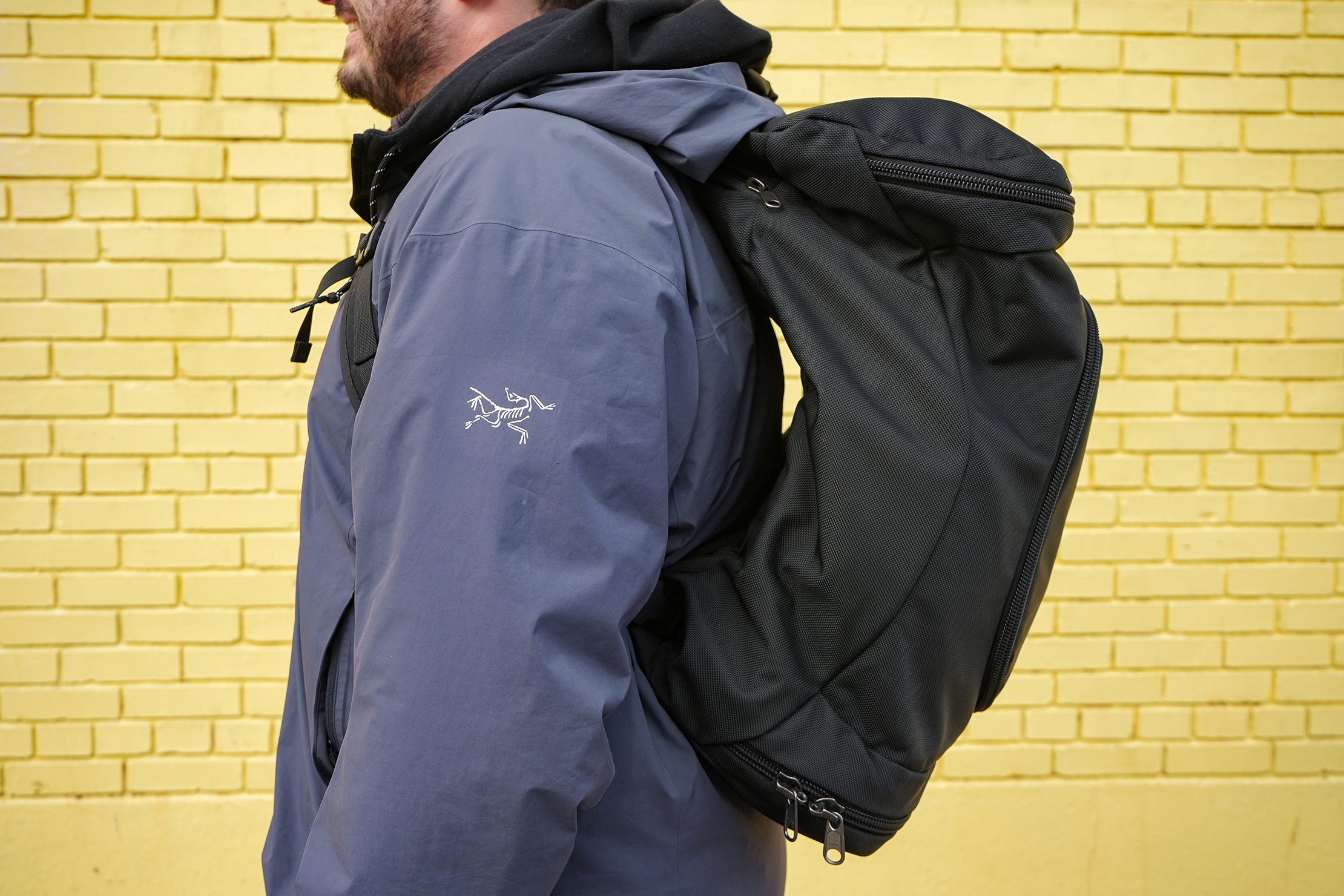
Since duffle bags usually lack the structure typical for backpacks, buffles tend to slouch against your back in backpack mode. Some more so than others. If you’re planning to use your buffle in backpack mode semi-frequently, look for a pack with a bit more structure.
You can also add structure by packing strategically. We’re going to assume that you’ll be packing the bag when it’s in duffle mode (which will usually be the case for a Hybrid), but think about where your gear will end up when you wear your bag as a backpack. Pack the heavier stuff so it’s as close to your back as possible. Also, put flat items against your back to prevent anything poking into you—packing cubes are a great way to flatten out traditionally un-flat items like clothes—and keep the bag fully packed out so it retains its shape.
Straps & Handles
Buffle handles are where things can get weird. Often, the handles are supposed to work as both carry handles and backpack straps. And, often, these two-for-one handles fail at both.

Look for handles that taper in at their center—this will make them easier to grab and hold. If they’re not tapered, the experience of holding the handles will be akin to carrying a backpack by its shoulder straps, which is pretty unpleasant (unless you have massive hands). You’ll also want a little bit of padding for a comfortable backpack carry.
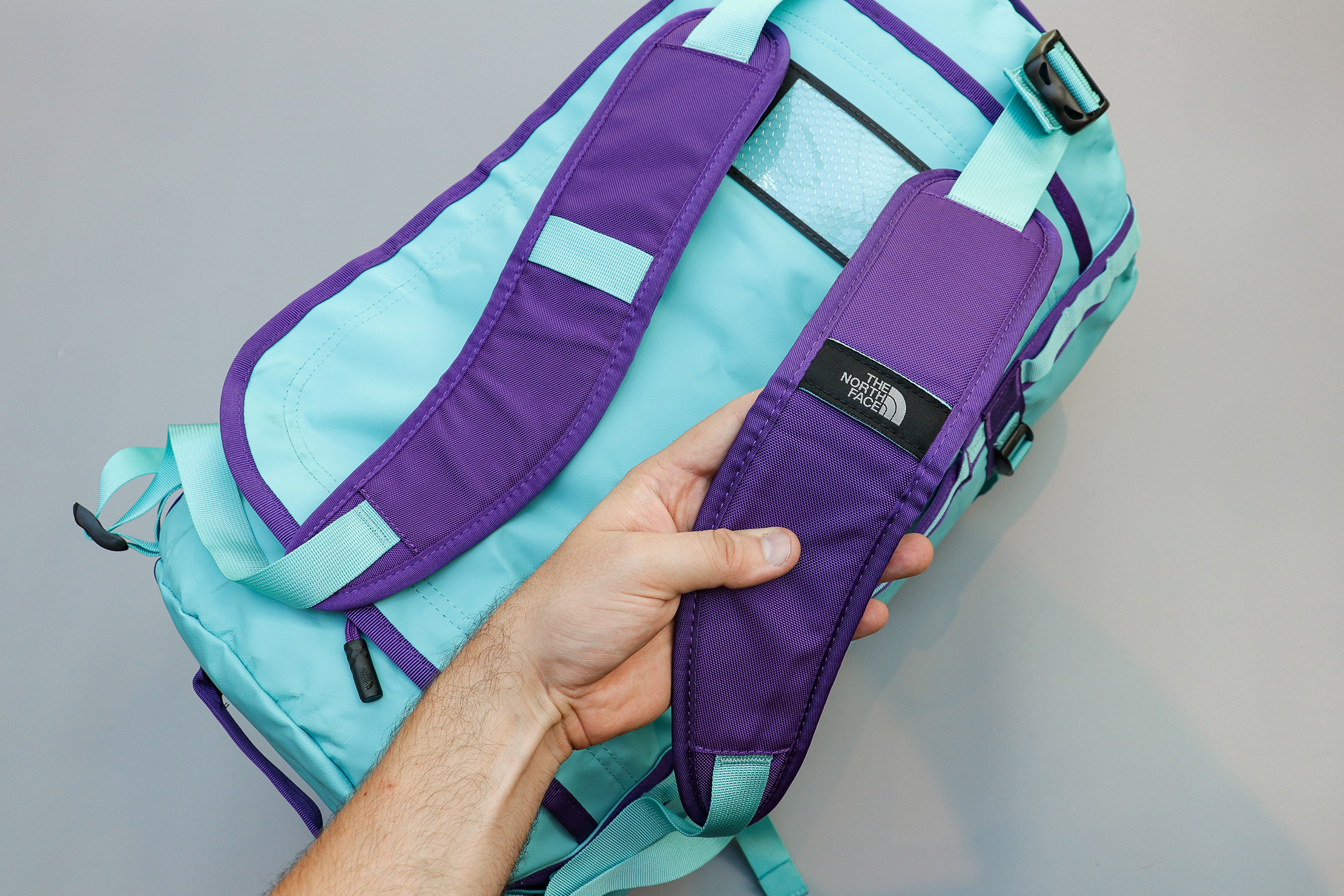
There are some Hybrid Duffles out there that, instead of having carry handles that also act as backpack straps, have separate backpack straps that either detach or tuck into the back panel when not in use. Usually, this means that the quality of the backpack straps and handles are better. But it takes time to switch between duffle mode and backpack mode. You can’t just throw the buffle on your shoulders when the handles start to get uncomfortable.
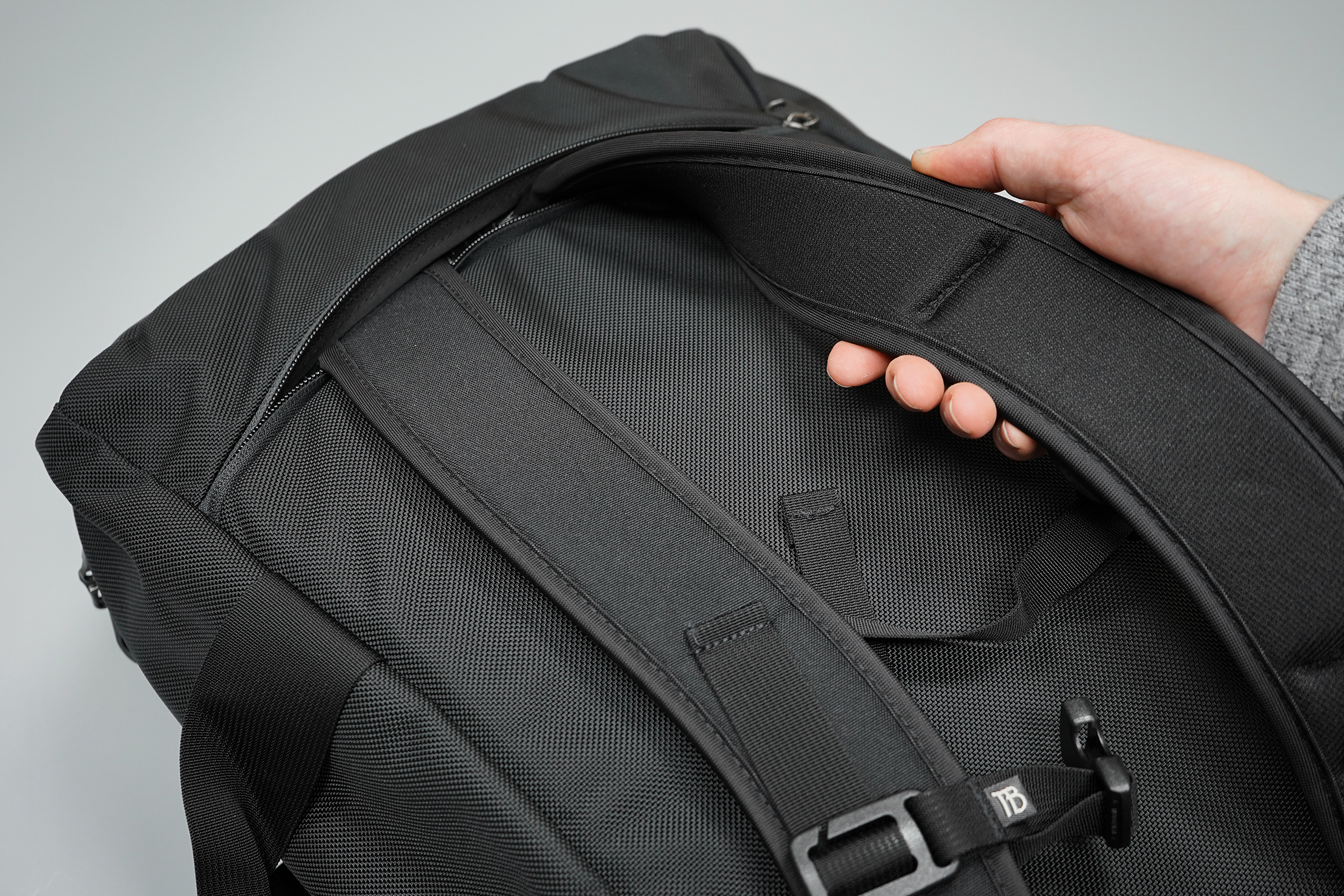
What you’ll prefer comes down to your use case. If you think you’ll be continually switching between backpack and duffle mode, you’ll want handles that pull double-duty. If you think you’ll primarily be using your buffle as a duffle, with an occasional need for backpack straps, you’ll want to look for detachable/stowable backpack straps.
One final note here is that you won’t frequently find a crossbody strap on a buffle. This can get annoying, particularly on those buffles with separate backpack straps. Carrying a duffle by its handles for more than five to ten minutes (depending on your hand strength and size, as well as the weight of the bag) tends to get unpleasant. And, sometimes, you don’t have the time to stop what you’re doing and switch it into backpack mode. You’ve got flights to catch, legs to work out, and beaches to lay upon, after all.
Interior Organization
First of all, look at the orientation of the pockets. Some buffles have vertical pockets that work best in backpack mode, but most have horizontal pockets designed with the duffle carry in mind.

Problems arise when the pockets don’t have secure openings—with a zipper, buckle, velcro, or, at the very least, some elasticity. If the pockets are open, your stuff will likely fall all over the place when you’re swapping carry modes. If you thrive in chaos then this may be a plus. Otherwise, it gets old pretty quick.
Backpack-specific Considerations
It’s rare to find a Hybrid Duffle with a decent back panel. In fact, it appears that most companies don’t put much thought into it at all—which makes us appreciate those that do. If you’re planning to use your buffle as a backpack frequently, definitely pay attention to the back panel and look for one that has padding and air channels.
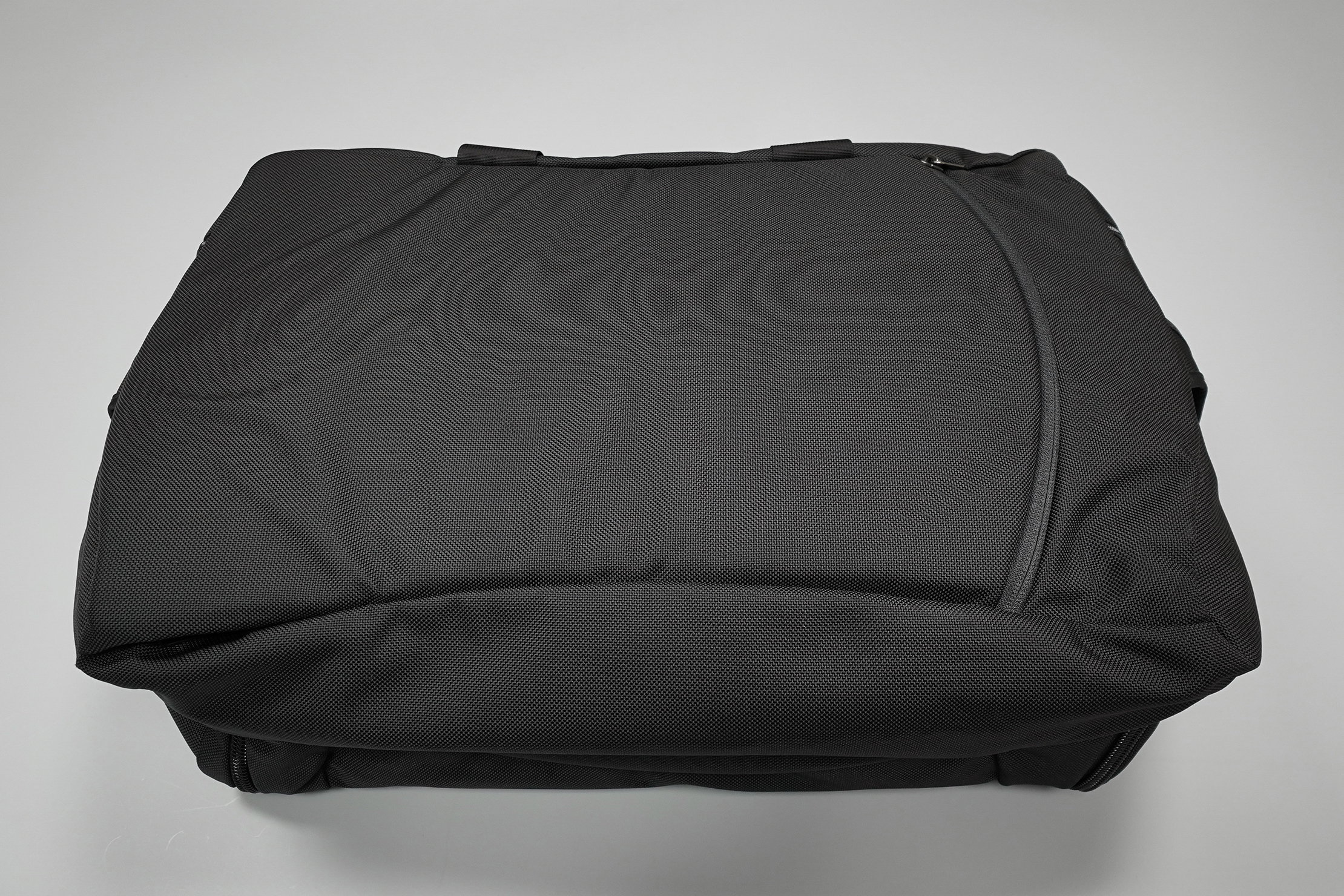
Also, any pack with an interior capacity of 30L or greater should have an option for a hip belt, so all the weight doesn’t have to dump into your shoulders.
The Good
- The spacious interior of a duffle with a backpack’s comfortable carry (at least in theory)
- Versatile mode of carry
- More affordable than buying both a quality backpack and a duffle
The Bad
- Difficult to pull off—usually ends up being a mediocre backpack and a mediocre duffle bag
- Typically, the back panel is not well-thought-out
- The straps tend to either be good backpack straps or good carry handles, but rarely excel at both (and sometimes fail at both)
We’re going to pull back the curtain for a second and let you inside the Pack Hacker headquarters. Oh-so-long ago when the team sat down with dozens of duffles, separating them into what later became the categories you’ve been reading about, we struggled with naming the style of duffle bag designed to hold your tech—laptops, tablets, camera equipment, dongles, cords, chargers, keyboards, batteries, headphones, etc.
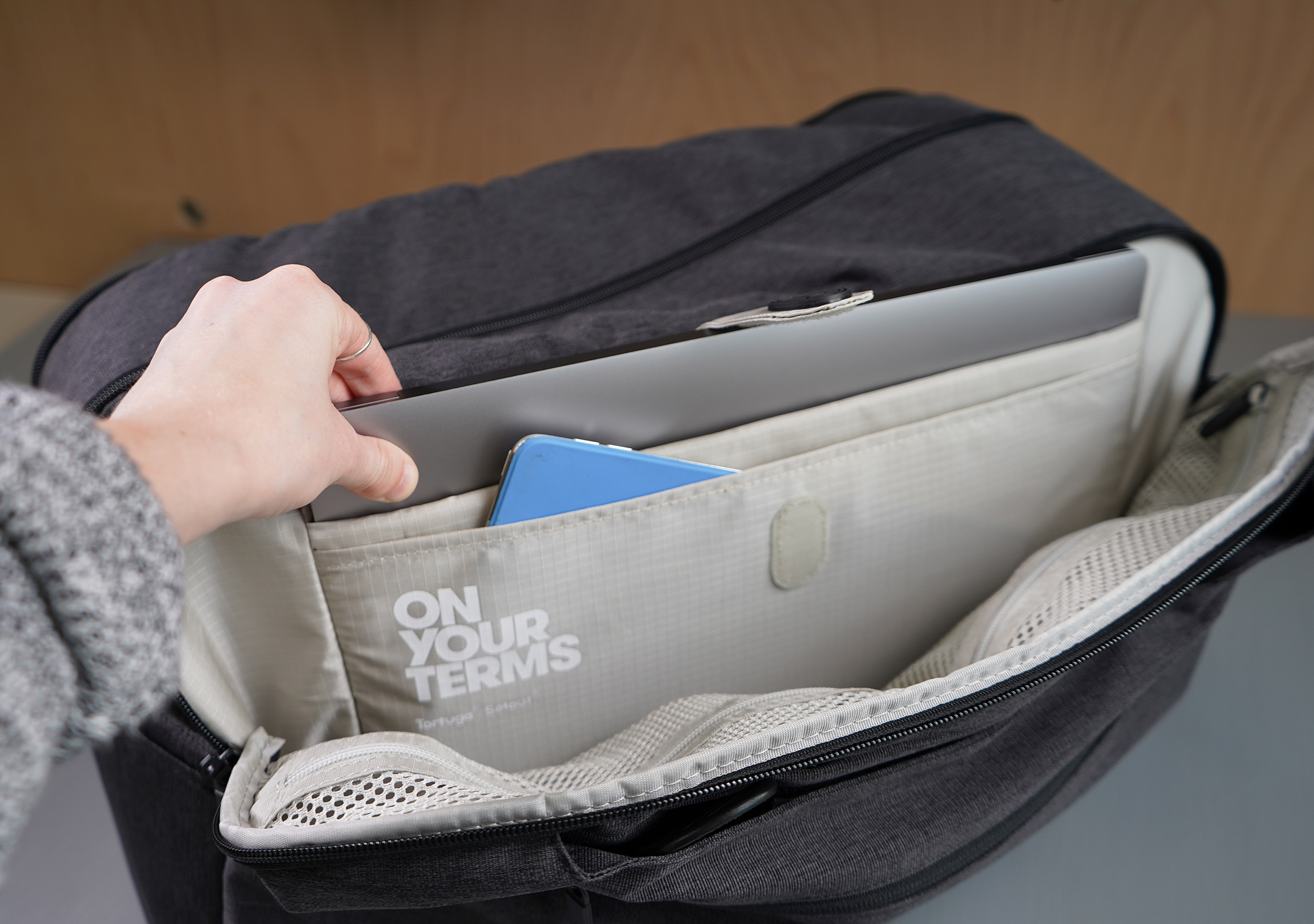
We threw around Tech Duffle but decided that described a technical duffle—you know, one with high-tech materials that looks like it belongs in the Matrix universe. Laptop Duffle seems to be the accepted term, but it feels too limiting. Classic Duffle 2.0 was also a contender at one point but wasn’t limiting enough.
So we invented the term “Digital Duffle” because these duffle bags are designed to hold all of your tech gear (not just your laptop) and because alliteration (duh).
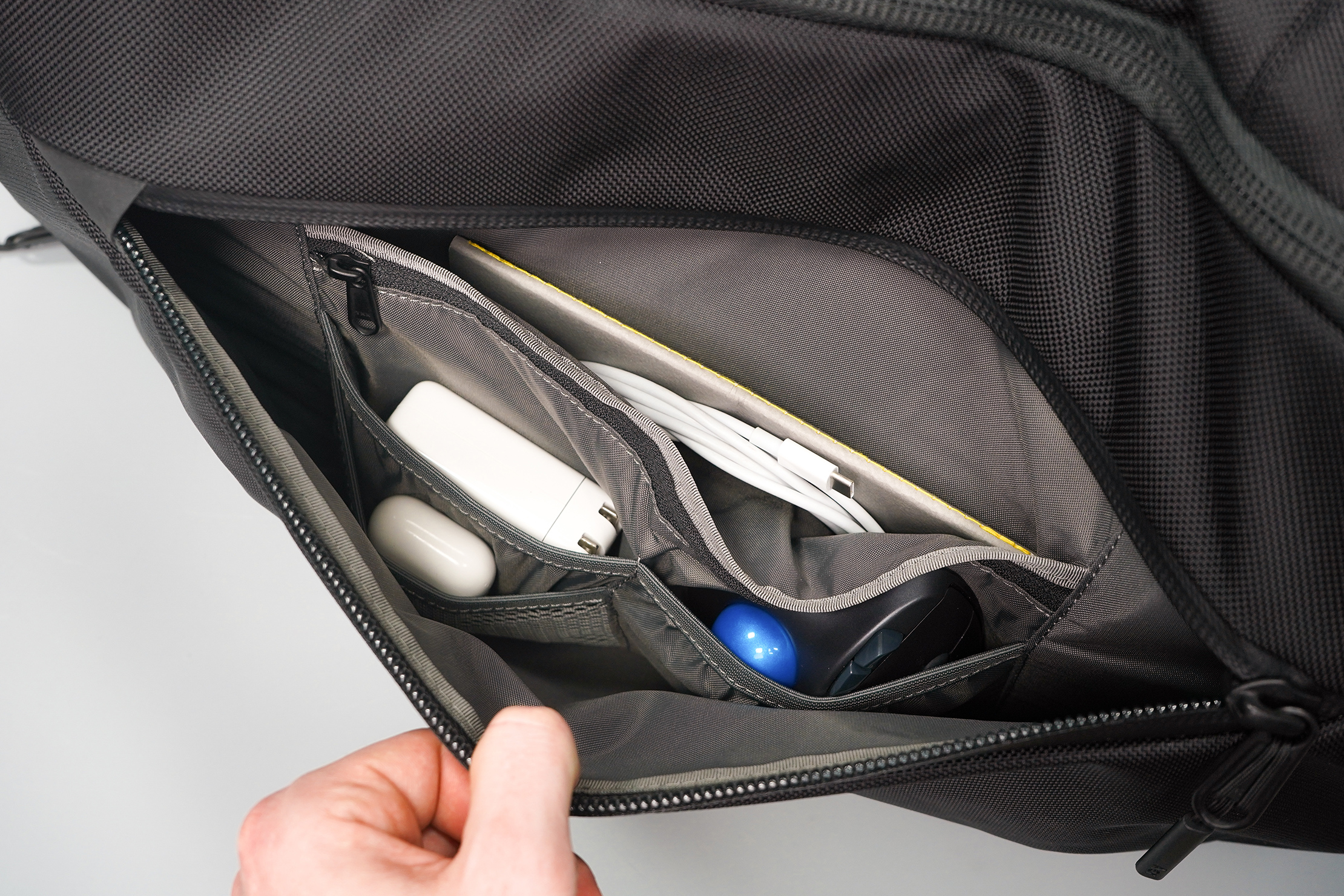
A Digital Duffle has a ton of organization going on, including a compartment for your laptop. And these duffles tend to skew smaller—think carry-on sized.
They also tend to have a sophisticated aesthetic, looking almost messenger bag-esque.
Why Digital Duffles?
We’re (obviously) huge fans of backpacks here, but we’re aware of how they can come across in a business meeting. Especially one that you’ve flown halfway across the country (or world!) for. A sharp messenger bag would probably work better than a duffle for business purposes, but sometimes you’ll have to walk off the plane and into the office and you’re going to have to bring your travel bag with you.

But aesthetic isn’t the only reason to choose a Digital Duffle. You’ll want to opt for one if you’re using a duffle bag as the only luggage you’re traveling with—and you travel with tech. (A Classic Duffle would work for one-bag travel if you only need to pack clothes and toiletries.)
A Digital Duffle also works for two-bag travel. Use it in conjunction with rolling luggage—using the rolling luggage for your clothes and toiletries—or with a backpack, leaving your duffle and laptop in the hotel and using your backpack while out exploring the world.
How to Pick the Perfect Digital Duffle:
Profile
As always, we recommend going for a slimmer profile to achieve a comfortable carry. This can be particularly important for a Digital Duffle since you’ll likely carry it in briefcase mode semi-frequently.
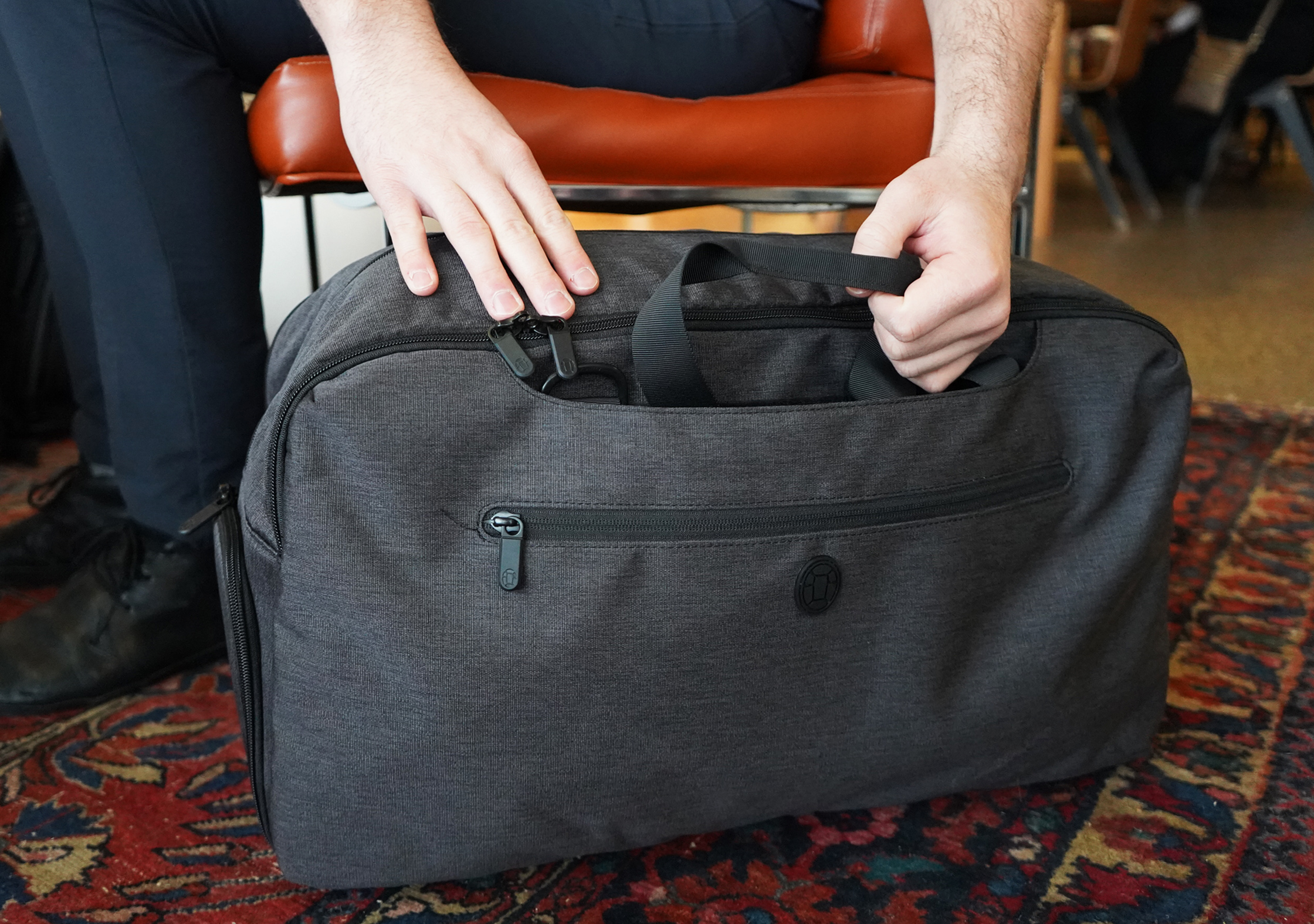
Also, look for structure. Rigidity will help to keep your expensive tech safe and organized.
Straps & Handles
The ideal straps and handles on a Digital Duffle are the same as the ideal straps and handles on a Classic Duffle. Look for carry handles that attach in the center with a snap button or velcro, and for a crossbody strap that has plenty of padding.
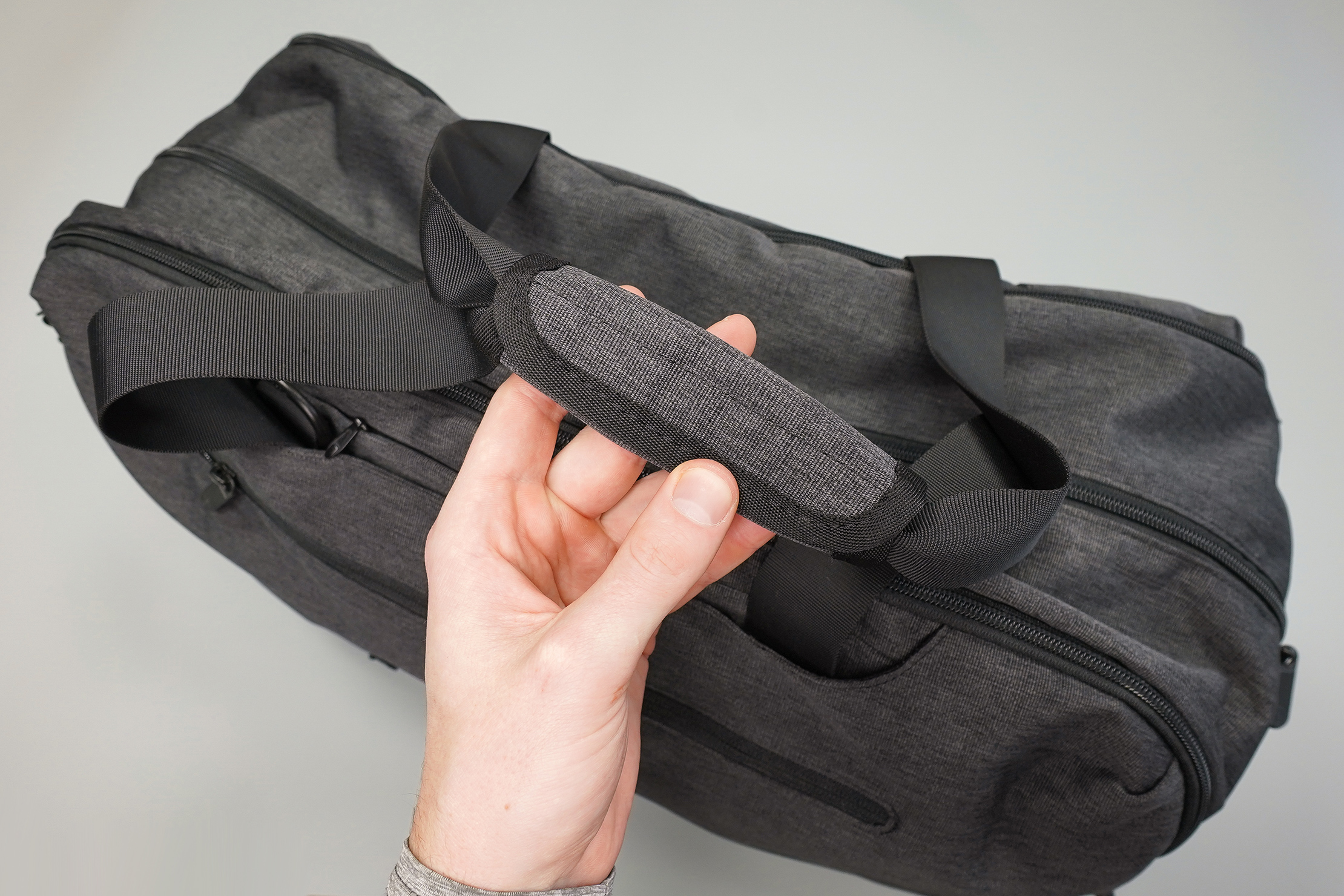
Some Digital Duffles have a single, centered grab handle, which also works just fine.
Interior Organization
You’re trusting this duffle bag to hold expensive, valuable equipment, so make sure it’s worthy of that trust. Any pockets that are specifically designed for tech—like a laptop or tablet sleeve—should have plenty of padding. And a false bottom on a laptop compartment is always appreciated. (A false bottom suspends your laptop, so it won’t crash against the ground if you accidentally drop your duffle bag a little too hard.)

Also, look for lots of pockets that will hold all those random bits and bobs—dongles, chargers, or pens if you’re a little more old-fashioned.
While not technically “interior organization”—although related to it—we want to note that lockable zippers can add some great peace-of-mind, allowing you to completely secure your duffle and the valuable stuff inside of it.
The Good
- Sophisticated aesthetic
- Walk from the plane into a business meeting
- Great organization if you need more than offered on a Classic Duffle
The Bad
- Not as convenient as a backpack
- Can get uncomfortable to carry
- Not always available in larger sizes
A Rolling Duffle is easy to define—it’s a duffle bag with wheels…so we’re done here. Let’s jump on into the next section.
Kidding, kidding. Of course, we have plenty more to say.
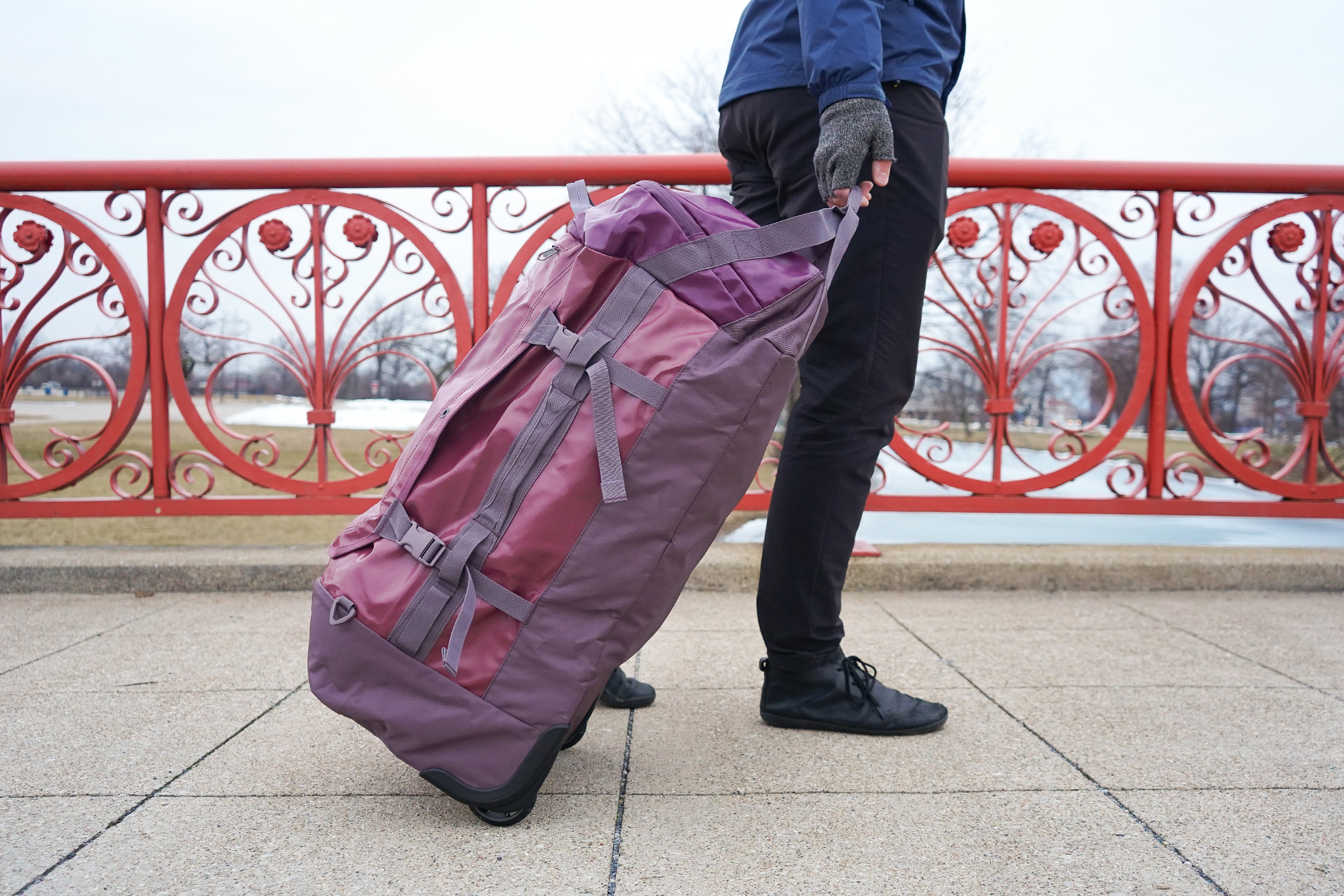
Almost all of the well-known duffle bag makers—Patagonia, Osprey, Eagle Creek, The North Face, Arc’teryx, and so on—offer a rolling version of their duffles. They tend to skew large, but you can find some that are carry-on approved.
Why Rolling Duffles?
Like hard-sided rolling luggage, rolling duffles are great when you can’t or don’t want to bear weight on your shoulders. At the same time, you still have all the benefits of duffle bags—a spacious interior, flexible frame, and squishability. This squishability means that, unlike hard-sided luggage, you can squish roller duffles into overhead bins, your tiny Airbnb closet, or the trunk of your rental car. They also tend to take up less space in your house whenever you’re not traveling.

The soft sides are also forgiving, allowing you to cram a ton of stuff or awkwardly shaped items inside the compartments.
And, usually, they still have the option for duffle carry with handles, a crossbody strap, and sometimes even backpack straps. That means you can carry or maneuver the bags over uneven/difficult terrain. You won’t have to be that person huffing and puffing as you attempt to drag your suitcase across sandy beaches or cobblestone streets. No one wants to be that person.

How to Pick the Perfect Rolling Duffle:
Profile
We’ve said it three times and we’ll say it again—a duffle with a streamlined body will treat you better. The bulkier the duffle the more it tends to flop about, twisting around or slumping forward as you walk. Structure helps here too, particularly on the bottom side of the bag (look for one with a frame sheet).
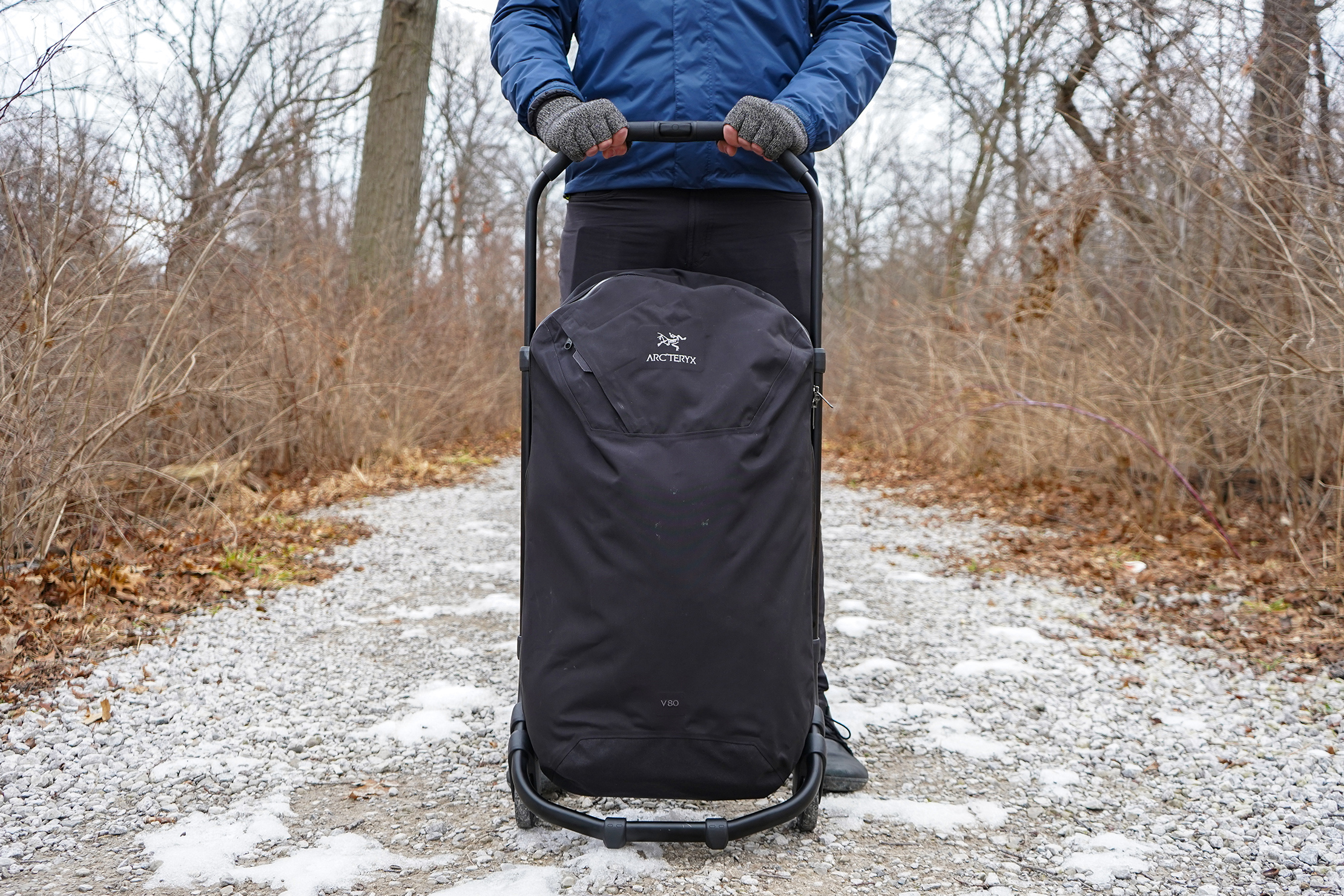
More than with other duffle styles, it’s important to consider your height here. If you’re short, you’re not going to want a duffle with a tall body, which may feel awkward or be difficult for you to maneuver. If you’re tall, you’re not going to want a duffle with a short body, which will destroy your back and ankles.
Straps & Handles
Look for a telescopic handle (those hard, elongate-able—not a word, but you know what we mean—handles you see on hard-sided rolling luggage). Wheeling around a Rolling Duffle with a handle that’s sewn to the bag is not great for everyone and basically impossible if you’re tall—the body of the bag will twist and the wheels will bite your ankles.
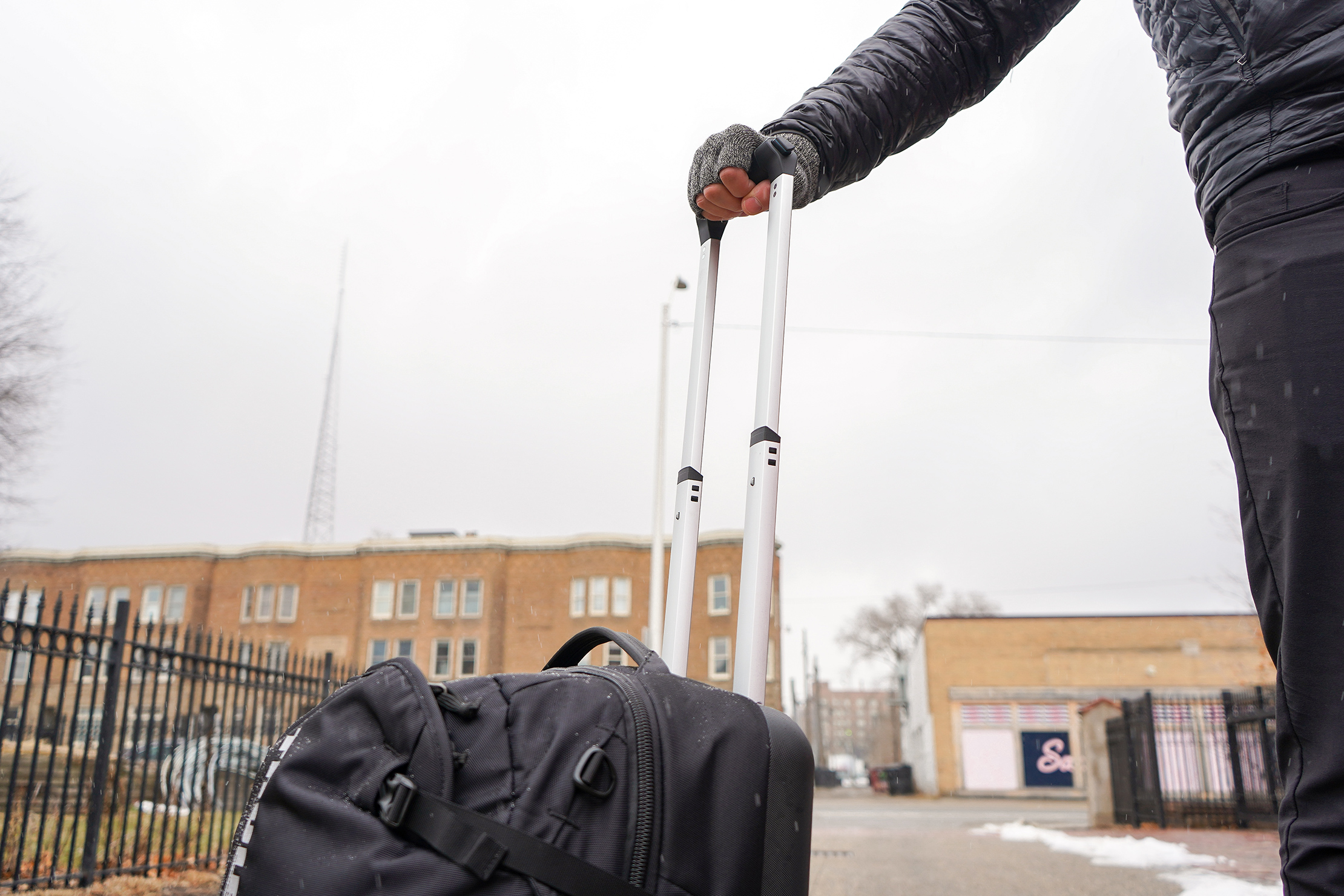
And, once again, consider your height. Your goal is to find a handle that hits at your waist. The more adjustable the telescopic handle, the better it will be for people of all heights.
A Rolling Duffle with those traditional duffle straps or handles is a bonus, as it allows you to carry the pack in duffle-mode those times when having wheels is not ideal—stairs, snow, sand, soil, snake sanctuaries (just trying to stick with the “s” theme).
Interior organization
This purely comes down to personal preference. You can find Rolling Duffles with a ton of organization—in the style of a Digital Duffle—or ones that are essentially one big bucket a la Classic Duffles.
Wheels

Make sure you pay attention to the quality and size of the wheels. Your use case matters here too. If you’re planning on using a Rolling Duffle camping or during outdoor adventures, the wheels need to be hardy enough to go over mud/dirt/trails. When we say hardy we’re talking about toughness, but also size. Larger wheels tend to do better over different types of terrain. If you’ll primarily be wheeling your duffle through the airport and from your Uber to your hotel, you don’t have to go so robust.
The Good
- A great choice if you can’t carry weight on your shoulders
- Easy to roll through the airport
- Stores better than hard-sided suitcases
The Bad
- The wheels and telescopic handle add bulk/weight
- More difficult to navigate uneven terrain than a backpack or regular duffle—although typically easier than roller luggage to carry
- Certain models can be difficult to wheel, particularly when not packed out, as they twist around or slump forward as you’re walking
So there you have it—the four most popular styles of duffle bags. But we live in an era where there are 30+ flavors of Pop-Tarts, so you know there are duffle styles that go even deeper. Styles that fill specific niches in the market.
Let’s check some of them out.
Packable
You can probably guess what a Packable Duffle is from its name. Yes, it’s packable (we knew you could guess it, you genius you). To get more specific, Packable Duffles are built with thin and lightweight materials, allowing you to compress them into tiny packages. We’re talking approximately the size of a soda can. They typically either pack into their pocket or a separate pouch.
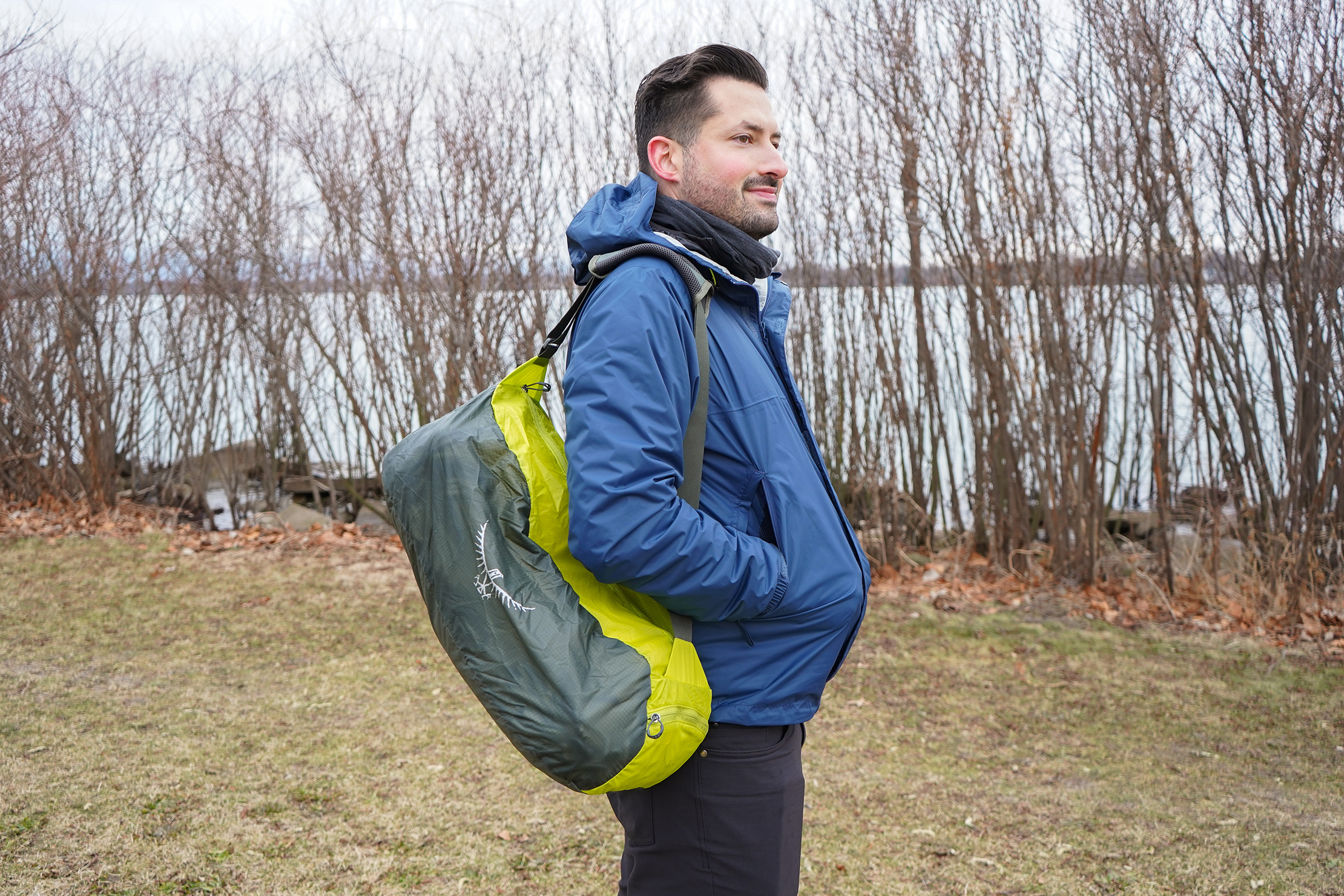
Usually, there’s not much else going on with Packable Duffles. No fancy carry modes or organization—their primary purpose is to compress as small as possible.
Now, you’ll find that some companies advertise a duffle as packable because it has a carrying case—but if it will take up a significant amount of space in your luggage we don’t consider it a Packable Duffle.
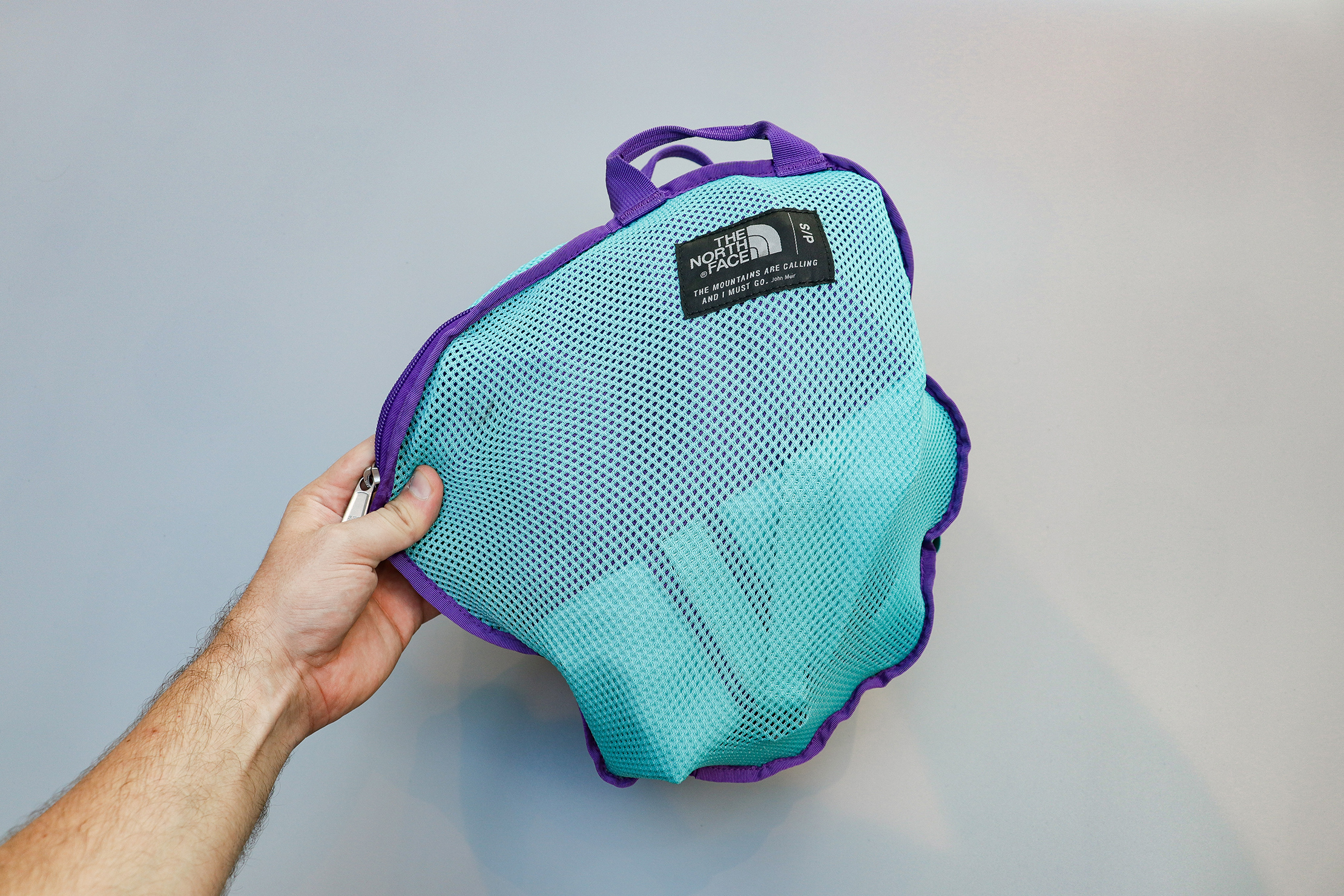
Why Packable Duffles?
The primary function of a Packable Duffle is to be able to pack it into your main bag and use it when you need the extra space. Say you’re going on a week-long trip out of the country and you fill your main suitcase with all the clothes, toiletries, and accessories you’ll need. You can bring a Packable Duffle as a way to bring home any souvenirs you may pick up.

You can also use a Packable Duffle as a smaller bag to take with you on day trips or short excursions, while you leave your larger bag back at the hotel. (But you may find that Packable Backpacks work better for this specific use case.)
Weather-Resistant
Another aptly-named style of duffle bag. These bags have been built with inclement weather in mind and will hold strong against wind, water, snow, sleet, and so on. For a duffle to be considered weather-resistant, the materials and zippers must be resistant to water. You’ll see that a lot of companies forget the latter. But zippers are important! It’s all well and good that water will roll off the fabric, but if it leaks through the zipper track your clothes/tech/whatever will still get wet.
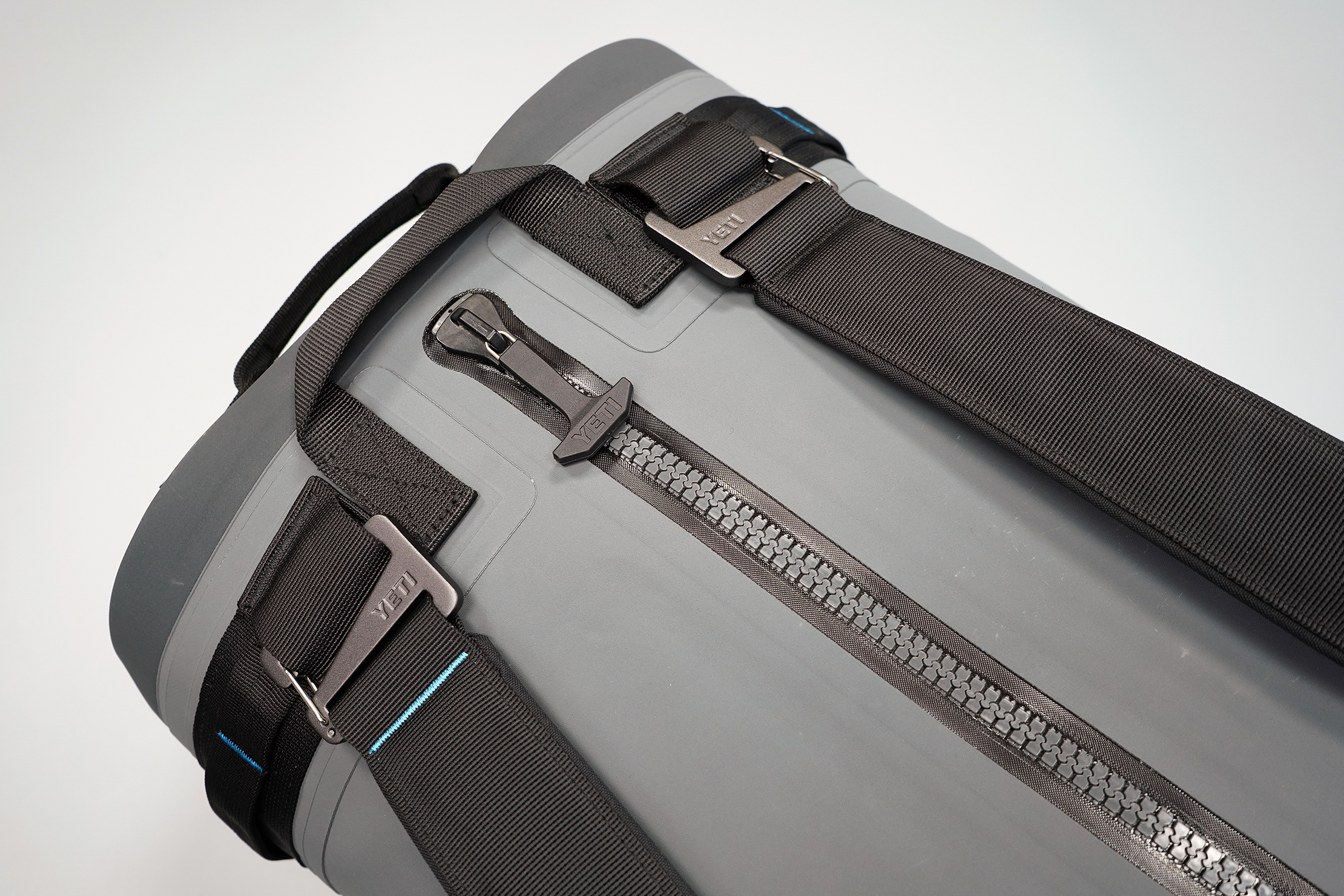
Some duffles are partially weather-resistant with water-resistant fabric and one compartment that features a water-resistant zipper (commonly a laptop compartment). This is a solid design as water-resistant zippers can be sticky and cumbersome to use.
To be clear, so far we have been discussing Weather-Resistant Duffles. Not Weatherproof Duffles. And there is a huge difference. Weatherproof Duffles, which are truly impervious to water (so much so, they’re submersible), are hard to come by. Usually, Weatherproof Duffles are made with nylon and some sort of coating or laminate.
Why Weather-Resistant Duffles?
Weather-resistance adds some great peace-of-mind because, let’s face it, the weather isn’t predictable 100% of the time. This is doubly true if your travels involve backpacking through notoriously rainy countries or you live in a place that’s in a near-constant state of drizzly.
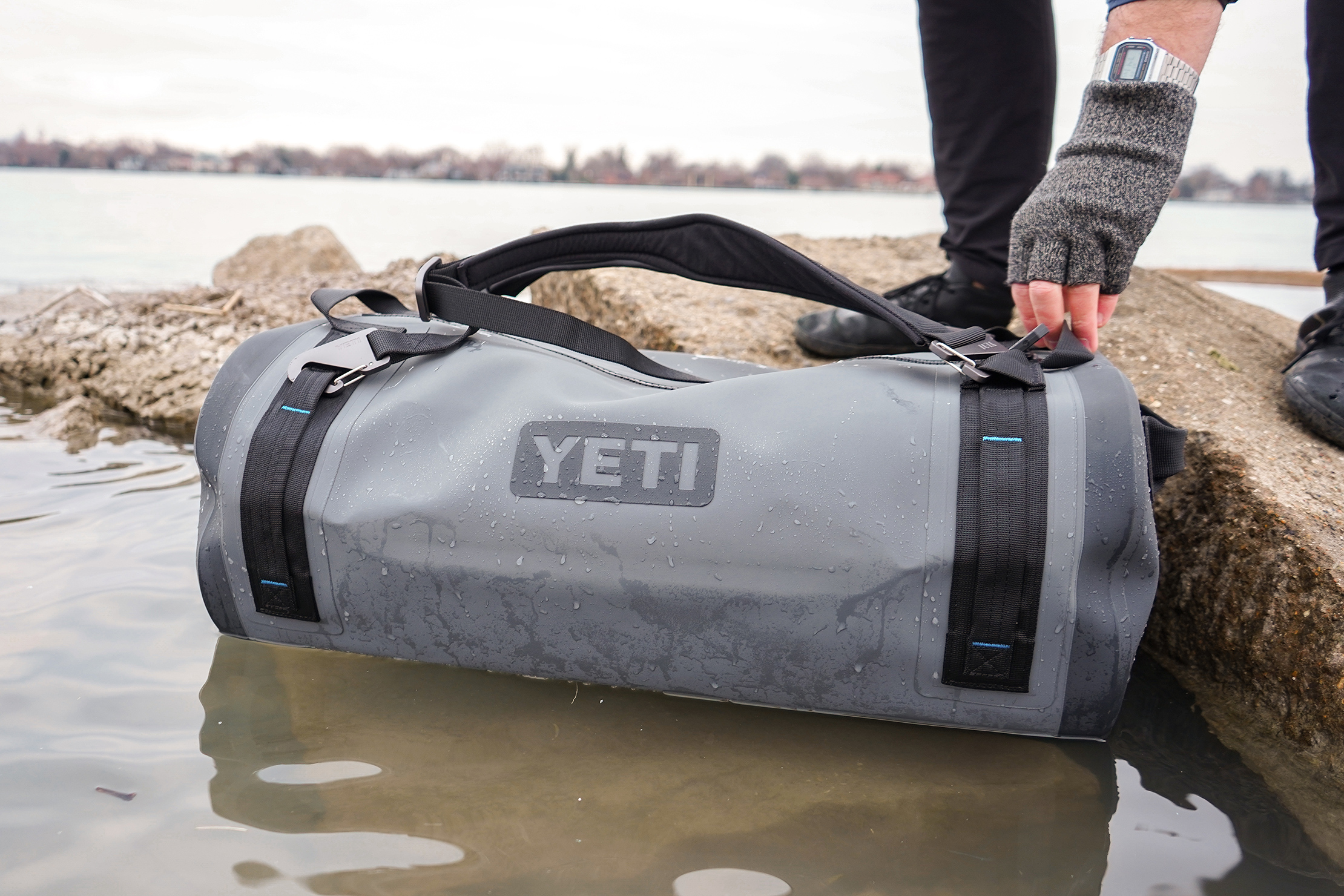
Weatherproof Duffles, on the other hand, are likely overkill for most people. Unless you go on wild adventures that involve heavy precipitation, boats, backcountry fly fishing, waterfalls, etc, you probably don’t need a Weatherproof Duffle. That said, you may decide to go for it anyway. Usually, these duffles are super durable as well, so they may be a good choice if you crave that robustness.
Gear Haulers
A Gear Hauler is essentially a Classic Duffle, only gigantic. There’s no exact definition for “gigantic” at least in terms of liter capacity—what some people may be able to use for years of travel, others will only be able to use for a weekend. Still, we start to think of a duffle bag as a Gear Hauler when it can’t be used as a carry-on. And because Gear Haulers do tend to be larger, you will find a number of them with wheels.

More so than their size, Gear Haulers are defined by their job—and that’s to haul your gear. Usually, you won’t see anything fancy. You won’t find a robust harness system or smart internal organization. Just a massive bucket to throw all your clothes, toiletries, books, rock collection, or whatever in.
Why Gear Haulers?
A Gear Hauler is great to use when you’re traveling to one place for a long time. Say you’re going to Au Pair in France of six months or study abroad in Spain for a school year. Since you’re semi-moving to that place, you don’t need the convenience of a backpack, you just need a big ole spot to throw your stuff.
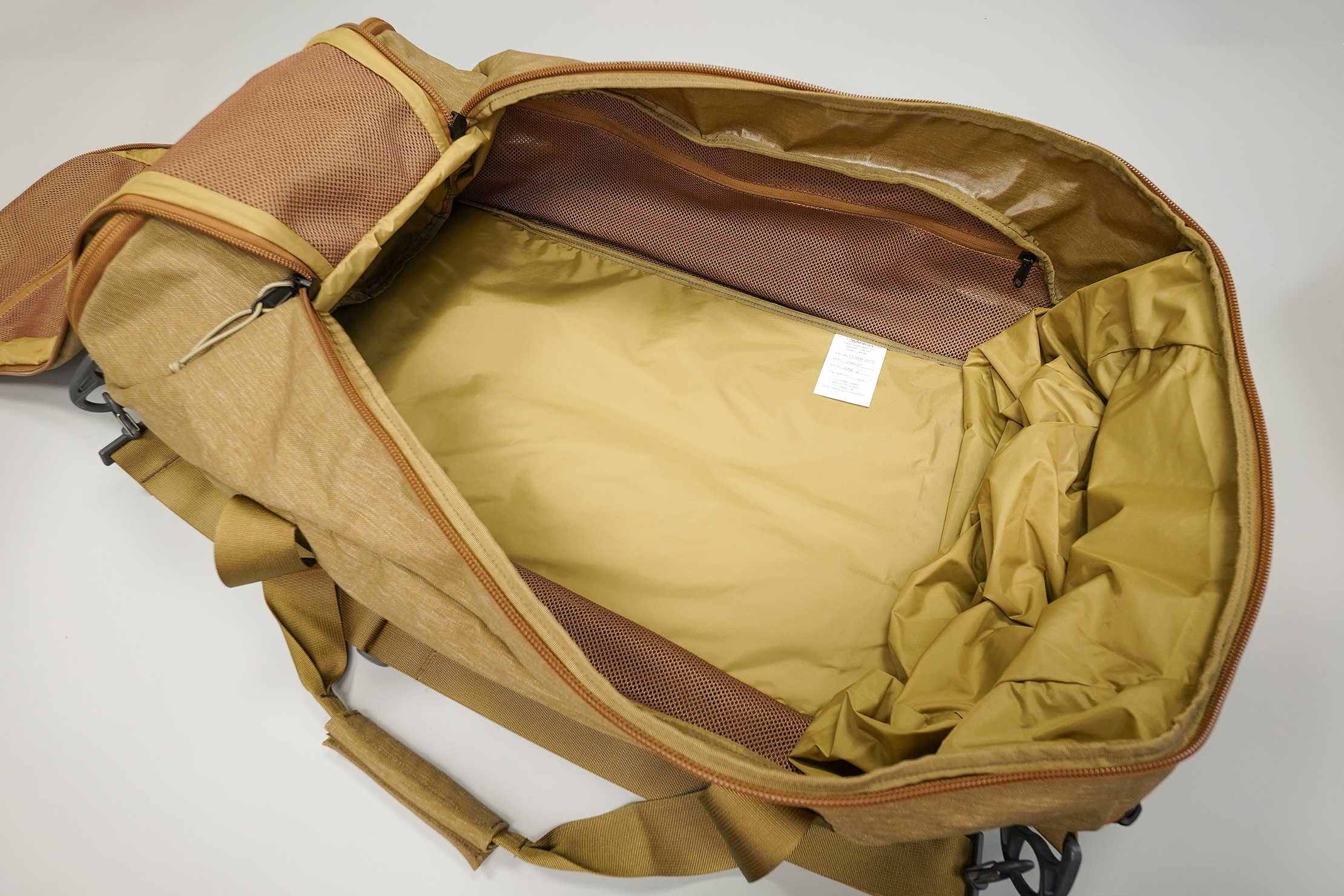
They’re also great if you have no interest in packing light or only traveling with the essentials. If you need the space, go for it. But, remember, these duffles will get heavy. And you will have to pay for a checked bag.
Weekender
On the other end of the duffle bag spectrum from the Gear Hauler is the Weekender. Essentially a Classic Duffle—maybe with a few more pockets—but designed to work for short excursions. We would describe the aesthetic as tote-adjacent.
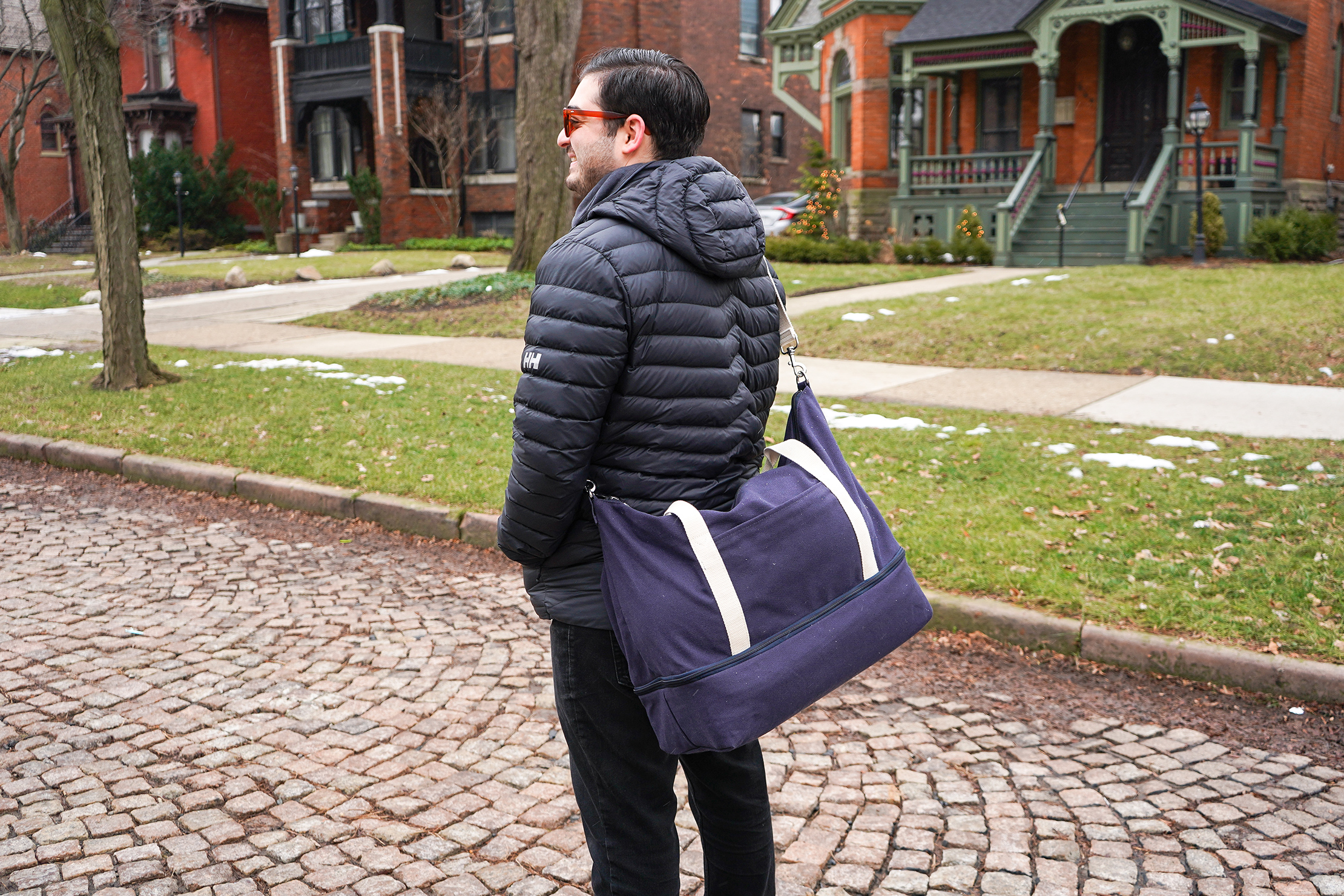
Why Weekenders?
If you prefer to travel with a backpack or hard-sided luggage for longer excursions, you may consider a Weekender for those short, weekend trips. A Weekender is also great for travel in conjunction with a suitcase.
You’ll also run into several Weekenders that emphasize style—managing to be both luggage and a fashion accessory.
Luxury
Luxury Duffles are, first and foremost, designed to impress. You’ll make a statement with these polished bags from high-end fashion brands like Gucci, Louis Vuitton, and Prada.
While these duffles look polished and well-made, they’re not always adventure-ready. Think about your use case and whether or not you’d rather spend your money on a pack that’ll keep up with all you throw at it. But if you’d rather choose fashion, you have plenty of options—and not all of them will break the bank. Of course, you can spend 1,000-some dollars on a Gucci bag, but you can also find quality, stylish duffles from lesser-known brands that we would also consider luxury. Brands like Ted Baker, Tumi, Longchamp, and so on.
Why Luxury Duffles?
There’s not much to say here—Luxury Duffles are usually an aesthetic choice.
Basic duffel bag
If you’re looking for a simple and budget friendly travel bag for a weekend trip, then a basic duffel bag is one of the most reasonable options.
Although small and affordable, basic duffel bags are strong and lightweight, and one of the most popular camping products.
They come in various sizes and designs, so you can keep a separate few for the gym, camp, and other trips. But if you want the best type and style of a duffel bag, look for one with a shoulder belt for added comfort and convenience.
Wheeled duffel bag
Many of these wheeled bags have very rigid bottoms. They also often have a wider opening with the use of a U-shaped zipper running the length of the top side of the bag. These bags usually have the most separate sections and some can even be expanded in to larger bags. This style of duffel is popular with travelers who have to walk a long distance with their bag. The built in wheels on the under side of the bag make it easy to carry even heavier loads. If you need something for heavier luggage, consider one with wheels because it is better equipped to support a lot of weight. Wheeled duffel bags are also great for long trips, such as summer vacations or business tours.
Backpack duffel
These are regular duffel bags that have in-built backpack belts to make them easier and safer to carry around. Backpack duffels are the most versatile types of luggage bags and one of the most popular sports products.
Barrel Duffel
The classic barrel-style duffel is basically a cloth tube-shaped bag with straps. There are two variations of this type of duffel bag. The original design is the top closure duffel. This type has a top opening with a drawstring style closure. These top closure duffel bags are often very large and are used for larger equipment or as an all-in-one bag. The military has used a thick canvas top closure duffel bags for many years. The durability and load possibilities have made them very popular, especially in war zones. The other variety of barrel-shaped duffel has a side zipper closure that runs the length of the bag. These bags can also be made of canvas but are also made of woven polyester backed with plastic. These are usually smaller than the top closure version. They are commonly called gym bags because they are used by athletes to carry smaller sports equipment. Both variations of this barrel duffel shape are one-compartment bags. Because of this problem items inside the bag can get tossed and disorganized making the barrel duffel a mess to unpack.
Squared Duffel
A more recent adaptation of the duffel bag is the squared or box-shaped bag. This bag is a box shaped rectangular duffel with side zipper closure. This variety usually has separate zippered compartments on the ends. This feature is great for keeping the bag organized in transit. These bags are often made of more rigid plastic backed woven polyester. Plastic covered wire piping is also used on the perimeter of many of these bags to give them more rigidity and structure. These squared duffel bags are often used by law enforcement. For use in the line of duty, many of these bags are customized with foam padding and inserts for weapons and ammunition.
1. Travel Totes

A large unfastened bag with parallel handles emerging from its side are known as tote bags. Usually with just a single compartment for all of your daily essentials, a travel tote has smaller sections well equipped to carry all of your travel essentials with ease. In fact these make the perfect carry ons for your travels with enough space for your wallet, passport, phone, electronics, etc.
![]()
2. Duffel Bags

Duffle bags are a cylindrical canvas bag closed by a drawstring and carried over the shoulder, but were initially more commonly found on military personnels and sportsmen. Now, these bags are more commonly used as a carry on on most travels since they’re easier to carry around and have enough space to store all of your travel essentials in there.
![]()
3. Weekenders

As the name suggests, a weekender is the ultimate travel bag designed to hold enough clothing, toiletries, and your basic travel essentials for a long weekend trip. They happen to be the perfect size for short trips and work incredibly well as carry ons for longer trips. Typically made of cloth or nylon, these are slowly coming up in the leather territory as well and are more boxy and sturdy as compared to a duffle bag.
![]()
4. Wheeled backpacks

A wheeled backpack is like perfect blend between a backpack and a suitcase. It usually is the same size as a regular backpack, or maybe even bigger, and have four wheels at the bottom making it easier for when you don’t want to any added strain on your back. Most places might not be wheel friendly, but always having an option helps. Wheeled backpacks usually have the mixed space capacity of a backpack and a suitcase, allowing you to carry as much as you want without really adding any strain towards your back or arms.
![]()
5. Rolling Luggage

Rolling suitcases are suitcases with two wheels on the base making it easier for the person to travel with it. The first commercially successful rolling suitcases was invented in 1970, and have been a popular choice since then. While initially used as carry ons, these have slowly made their way into checked luggage. But more recently four wheelers have become a popular choice and are referred to as ‘spinner’ luggage since they spin.
![]()
6. Travel Packs

Travel packs are a specialized rucksack specially designed for adventurers and extremely popular with backpackers. They don’t look any different compared to a regular rucksack, but they do have an added benefit of being able to zip shoulder straps, hip belts, and shoulder harnesses out of sight. They work perfectly well during times when you just have to pack up and move. Extremely easy to travel with and have a lot of space for your essentials.
![]()
Despite the names of different travel bags, they serve the same purpose; making your travel as comfortable and as easy as possible. Each of these are available in a variety of colours, materials, and sizes, allowing you to pick and choose the one you like and want. If you’re still not sure about which one you should pick, take a look at this list we created of the types of travel bags before you make your choice.
![]()
-
MATERIAL
Modern nylon and polyester filament yarns share some similarities that may allow for cost reductions through materials engineering where polyester replaces nylon. However, there are some key differences to consider when designing an industrial sewing thread, hose reinforcement yarn, or textile binder or strength member. How are these fibers similar and how do they differ? The answers can be found in looking at the basic properties, and more importantly the end product application and environmental exposure to the fibers that will make all the difference in product success or failure,
Nylon and Polyester Yarn or Thread Strength
Polyester and Nylon multifilament yarns are available in similar deniers or sizes that can be assembled and twisted into a variety of industrial yarn or sewing threads to meet most end-use requirements. Nylon sewing thread has a higher strength to linear density ratio (Tenacity) than Polyester. Tenacity is commonly expressed as grams per denier (gpd) with High Tenacity (HT) polyester typically running 9.0 gpd and Nylon 6,6 at 10.0 gpd. So if strength is the only consideration, nylon would appear to be the best choice. Of course, there’s much more to the story!
Exposure to Environmental Factors for Nylon and Polyester Yarns and Threads
Outdoor materials require threads that can withstand severe weathering conditions and require properties such as UV resistance, high strength, and resistance to abrasion, mildew and even saltwater, in order to extend its life. Polyester is the most common thread for outdoor applications. In the presence of UV rays, Nylon will break down and start to degrade much faster than Polyester. Polyester naturally inhibits UV and is therefore recommended for a number of outdoor uses – cushions, upholstery, sails, canvas covers, boat covers, awnings, tents, tarps, geotextile and, in general, all outdoor applications.
For indoor applications, the UV resistance becomes less important and strength, abrasion resistance and stretch becomes more important. Nylon has better elastic and abrasion resistance properties than polyester, with its superior stretch and recovery properties making it the preferred choice for upholstery material and thread as well as materials that experience heavy traffic e.g. carpets and other artificial surfaces. However, nylon tends to absorb more moisture than Polyester (moisture regain for nylon is ~4% vs ~0.4% for polyester) and when wet will stretch approx. 3.5% beyond its original length, which is why polyester is the preferred tenting material.
Nylon has excellent resistance to hydrocarbons (gasoline, kerosene and diesel fuel), oils, cleaning solutions and alkalis but nylon is attacked by oxidizing agents, organic acids, hot mineral acids and aromatic alcohols. Nylon also dissolves with partial decomposition in concentrated solutions of hydrochloric, sulphuric, and nitric acids and is soluble in formic acids.
Polyester is resistant to acids, oxidizers such as hydrogen peroxide and most solvents. Polyester has excellent resistance to hydrocarbon fuels, oils and Lubricants, however it is attacked by strong alkalis such as concentrated solutions of sodium hydroxide (lye or caustic soda), calcium hydroxide (lime, mortar), ammonia, trisodium phosphate or sodium carbonate (washing soda, soda ash).
Processing Considerations for Nylon and Polyester Yarns and Threads
Nylon thread is easier to dye than Polyester thread and majority of dye migration problems are associated with polyester, especially dark shades. Solution dyed polyester offers some advantages over package dyed – see our blog on Solution Dyed Yarn vs Package Dyed Yarn: What Should You Use? Heat has similar effects on Nylon and Polyester, sticking around 228⁰C and melting around 260⁰C. Nylon, however is more susceptible to yellowing at prolonged temperatures ≥ 150⁰C, whereas polyester tends to remain brighter.
Nylon is more difficult to recycle than Polyester. There are many ways to turn Polyester in for recycling but fewer for Nylon. Nylon breaks down into toxic and hazardous materials when melted and is therefore more expensive to recycle.
Polyester fiber is naturally stain resistant and doesn’t require any added chemicals which many people prefer, and makes it much more cost effective than nylon.
Cost of Nylon and Polyester Yarns
The cost of multifilament Nylon is significantly more expensive than the equivalent denier in Polyester, in some instances x 2.5 more expensive, therefore substituting Polyester for Nylon should be a consideration when physical and chemical requirements similar or are not a concern – carpets, filler/stuffer yarns, tents etc.
In many yarn and thread applications, polyester can replace nylon for significant cost savings.
Only curiosity could have brought you here – you want to know what those three little letters that are on every zipper you own mean. The simplest explanation is that they are the branding of the YKK company. And you will get a much more detailed explanation in the rest of this guide.
If you want to know everything about YKK zippers – who they are, why they are everywhere and why they have the monopoly on the market, you’re definitely in the right place! We’ll walk you through the history of the company, their influence on the zipper market and some of their fiercest competitors in this guide to YKK zippers!
Why Is YKK On Every Zipper?
A common misconception is that YKK is synonymous with zippers – it’s not. There are loads of other zipper manufacturers, but they are heavily overshadowed by the YKK zipper company. And the reason for that is because YKK zippers are the best – plain and simple.
The YKK group was founded back in 1934, which gave them plenty of time to establish their clear dominance in the zipper market. Over the years, they’ve continued to prove the quality and reliability of their products, which is how they manage to retain the monopoly on zippers even today.
But that does not mean that they are the only zipper manufacturer out there – they’re not. I’ll talk you through some of their largest competitors a bit later; for now, it’s enough to say that not all zippers are YKK, and not everything YKK manufactures is zipper related.
Who Is The YKK Zipper Company?

What Does YKK Stand For?
YKK stands for Yoshida Kōgyō Kabushiki gaisha – it’s Japanese for Yoshida Manufacturing Corporation. The ‘Y’ in YKK simply stands for the surname of the company’s founder – Tadao Yoshida.
Kabushiki gaisha refers to the kind of company the YKK group is. Under the Companies Act of Japan, KK are classic joint-stock companies, in which the shareholders are able to buy and sell their stock in a company.
But this is not a public company – YKK is privately owned, so you can’t just go out and buy their stocks. That’s why they don’t have a trading symbol, and why an entirely different company name shows up when you search YKK stocks online.
YKK Group History: From Founding To Today

YKK group also manufactures architectural products, plastic hardware, other fastening products, and even industrial machinery. But our focus in this guide will remain on their zippers!
The company was founded in 1934 in Tokyo, under the name San-es Shokai – that’s right, they weren’t always the world-famous YKK! In fact, they continued operating under their initial name until 1938, when the company was renamed to YKK. After that, there weren’t any major events in the company history until 1942, due to WWII.
In 1942 the company was reorganized as a limited corporation, and in 1946 the YKK trademark was registered. And that’s actually one of the most interesting facts, considering that nowadays companies will register trademarks even before they come up with products they can sell under the registered name!
Anyway, in 1955 YKK opened their second manufacturing plant in Kurobe, Toyama, which marks the beginnings of their worldwide expansion. November of 1959 sees the opening of their first overseas plant in New Zealand, and in the following decades the company also expanded to Canada, Kagawa and Swaziland.
But how did they go from a small Japanese company to a zipper magnate in such a short time -and yes, a few decades is a short time in any company history. Well, 1966 was a crucial year for the company, and it preceded many of their other worldwide expansions. In that year, the company invented the YZip – and extra durable high-quality zipper for jeans. And that same decade, jeans manufactured worldwide were designed to have zippers in the front. Plus, it was the sixties – men, women and children were wearing jeans, and people liked having the zippers on the front.
After the YZip was such a huge hit, the invention of a YZip machine followed. This machine had the ability to include the YZip into the stitching process of jeans automatically, which further increased zipper sales, especially in the United States. Only after that did the YKK company start expanding to Canada and other countries all over the world.
Today, YKK company has 109 different facilities in 71 countries worldwide. They employ more than 40,000 people and boast a yearly revenue of over $6 billion. But, keep in mind that that encompasses every branch of the company – the manufacturing of store fronts, sunshades, windows etc. – and not just the high-quality zippers.
Other YKK Fastening Products
I’ve already told you that YKK doesn’t make just zippers – they also manufacture all sorts of other fastening products. This includes plastic buckles, D-rings, strap adjusters, snap buttons, washers, rivets and so many other items that I can’t possibly list them all. I mean I could, but it would bore both you and me to death.
Anyway, that’s another reason why the company is so huge – they are able to offer in-house production of pretty much any fastening product a client could need. And they’re able to sell them machines that will allow them to automatically attach this to items they’re creating, making their manufacturing processes a lot more efficient.
This isn’t something the smaller zipper manufacturers – or even the bigger ones like SBS – can compete with. And that’s why some of the largest brands in the industry use YKK products more than half the time.
The YKK Zippers

One of the main reasons why YKK is such a big name in the zipper game is the sheer abundance of the different kinds of zippers they manufacture. Coil zippers, metal zippers, custom sliders – you name it, they make it.
They manufacture zippers from various different materials in pretty much every color under the rainbow. And with so much variety of the shape of the pullers that it can make your head spin.
By having so many different options in their catalogue, they are able to satisfy the needs of numerous different clients. That is why you can find a YKK zipper in pretty much any store, from Nike to Gucci.
YKK is also one of the few zipper companies that is able to manufacture an entirely waterproof zipper that will actually perform as well as you need them to. This is something brands can’t get from cheap companies – it costs a lot of money to design and manufacture these zippers, and that’s why items with waterproof zippers tend to have pretty high price tags on them.
The Competition: YKK. Vs. SBS
There is a myriad of zipper manufacturers in the world, but most companies are so small that they don’t even pose a threat to YKK. They’re kind of like the smartphone manufacturers you’ve never heard of, and YKK is Apple. Well, SBS is Samsung in this scenario – a fast-growing company that is YKK’s largest competitor.
SBS is a fairly new company; they were founded in 1984 in China. And the reason why they managed to pull ahead as YKK’s biggest competitor is the Chinese market – YKK hadn’t expanded there until the 90s. SBS is still ahead in the vast Chinese market, but YKK is investing heavily into development of new technologies, which allows them to be ahead in the overall game.
The reason why YKK manages to be ahead in the bigger picture is because of the other branches of the umbrella corporation. They don’t just make zippers – they also manufacture the machines that allow them to produce the best zippers in the market. All of their research and development is in-house, which is why they are winning in the zipper wars.
The Designer Battlefield

With the influence of high-end brands only getting stronger in the past decades, zipper companies like YKK and SBS are investing conspicuous sums of money into developing technologies that will allow them to collaborate with renown designers. SBS managed to score Giorgio Armani as a client, while Xiao Li, the famous Chinese designer, uses exclusively YKK zippers.
But, most of the big names like Balmain and Tom Ford are working with lesser known manufacturers, which are able to prioritize their needs – something a giant like YKK would not be able to do.
In an effort to win this battle as well, YKK has established a showroom in London, where they display some of their best and newest fasteners. This allows the company to connect directly with the average consumer, further increasing their chances of winning the overall war.
Now, deeming these events as the “zipper war” might sound a bit silly, but it is entirely appropriate considering the console and smartphone wars that are going on in this day and age. Especially when you consider the fact that the zipper market is worth some $13 billion – and YKK’s revenue accounts for nearly half of that.
High-Street Clients

The companies aren’t battling only for high-profile clients – they are also trying to score as many high street brands as clients as possible. Fast fashion is only getting bigger by the year, and zipper companies want a slice of that pie. So, it’s not really a surprise that even this particular market is incredibly competitive.
But high street brands will rarely work exclusively with one zipper manufacturer, which is why you will find a variety of different types of fasteners in items from the same brand. I own enough stuff from Zara to supply a small shop, and I had to really dig through my collection to find an item with a YKK zipper. So, why exactly is that?
The thing is, fast fashion companies need zippers that fit into the design of their items. Brands like Zara are able to have copies of runway looks in their stores in about two weeks – from designing the knock-off item to you paying for it at the counter.
Two weeks is a really short time, and if a company does not have a specific zipper shape they have in mind, they will turn to a different supplier. Fast fashion brands do not have time to wait for someone to design a new zipper puller for them, or to wait that it’s produced in the exact shade of neon pink they need. So, once they find the exact type of fastener they need, it doesn’t matter which company produces it.
This also explains why the quality of items in the same store is rarely consistent.
YKK’s Dominance In The Market
The main reason why YKK still manage to dominate the worldwide market is reliability. Over the decades, YKK zippers have become synonymous with toughness, durability and excellence. And as consumers, we are the ones who help the company come out on top year after year.
If you’re constantly buying stuff with YKK zippers because you know that they will last a long time, you’re directly responsible for their enormous success. And so am I – every item that has a YKK zipper has an advantage whenever I’m in a dilemma about purchasing something.
The sole reason for that is my personal experience – I’ve never had a complaint about the YKK zippers on my clothes, backpacks and suitcases. Which can’t be said about my experience with various other types of zippers – throughout my life I’ve broken countless pullers, dealt with numerous crooked zipper teeth and stuck zipper heads. But none of them were YKK.
I’m guessing that you’ve head a very similar experience, and that that was exactly what made you wonder who the hell YKK was. Well, I hope I’ve answered all the questions you had about the company – if there’s something else you want to know, just let me know in the comments!
When deciding on a new bag, one of the first things to consider is what type of material or fabric you’d like it to be made out of. As a Nike bag designer once said, “when I design anything, my first instinct is to think about the materials and the properties of these materials.”
The reason you want to think about the materials first is because they can determine a bag’s shape, aesthetic, durability, price, among other factors. Understanding what materials are good for what use case can give you a better idea of how you’d like your bag to look and function like.
With common fabrics, it’s important to consider that even within the same category of fabrics, there can be many variations with grades of quality and price, similar to how there’s different levels of qualities with zippers.
So, here’s a list of the 9 most commonly used materials that bags are made of. With each material, we’ll break it down into a few sections, factors like:
- What is it?
- Pros and Cons of using this material in your bag?
- What types of bags use this material?
1. Leather

What is Leather?
Leather is one of the oldest materials used in bag making, due to its durability, strength, and abundance in wildlife resources. Even with the recent creation of vegan leather made from Polyutherane (PU) synthetics and a shift in consumer consumption to non-animal based leather goods, leather made from animal skin remains a popular choice for many people.
With animal based leather, there are over 24 types of animal skins that are commonly used to make leather in leather goods and accessories, with cattle skin being the most widely used.
Advantages of having a leather bag?
A high-quality leather bag will last for years and will actually look more refined with age. Especially compared to using vegan leather alternatives that are made of plastic, full-grain leather is more durable and will last longer.
Full-grain leather also has the advantage of giving any leather bag or accessory a polished and sophisticated look that isn’t seen in other bag materials. From backpacks, to handheld bags, to shoulder bags, to wallets and purses, you can very easily elevate the look of an outfit with a classy leather bag.
Disadvantages of having a leather bag?
A full-grain leather bag, compared to other types of fabrics commonly used is much heavier due to the volume of leather required to make a bag. This is why you see many fashion focused brands creating popular bags that combine other common bag fabrics like Nylon with high quality leather trims to that you can still get a polished and sophisticated look, which a much lighter (and hopefully more affordable) bag.
Another disadvantage of full-grain leather bags is that they require more care and personal treatment in order to maintain their quality over time. Leather bag care tools like a leather cleaner, leather condition, or cream polish are used frequently in order to keep a bag looking new and without blemishes. What kind of bags are commonly made from leather?
What kind of bags are commonly made from leather?
Leather bags are commonly featured in many types of everyday or travel bags, but they’re often the most expensive type of bag due to the costs associated with using high quality top grade leather like full grain leather (hides that have not been sanded, buffed, or snuffed.)
Top grade leather is also quite common in small leather goods, like card holders or key cases, because use they typically don’t require as much leather yardage as bags do.

Backpacks

Clutch & Handheld Bags

Waist Bags

Shoulder Bags

Crossbody Bags

Larger Travel Bags

Wallets & Purses

Small Leather Goods
2. Cotton Canvas

What is it?
Cotton Canvas is an inexpensive and slightly heavyweight rough woven cotton material. It’s great for use in all types of bags, from casual totes to cross body bags.
Pros & Cons of having a Cotton Canvas bag?
Most of the cotton canvas bags you’ll find are quite affordable and depending on the material finishing, there can be a layer of water-resistant material added on top of the canvas to make it weather resistant (coated canvas).
Canvas bags are also comparatively lightweight and easy to clean. While other types of bags like a leather bag require a more intensive care and maintenance process, cotton canvas bags can be cleaned with liquid soap and cold water.
Cotton canvas bags, especially ones that come in lighter colors like white or grey can tend to get dirty more easily. Depending on the quality of the material and construction, they can also wear down faster than other materials like ballistic nylon or full grain leather.
What kind of bags are made from Cotton Canvas?
Cotton canvas bags are some of the most common bags that you’ll see people wearing. Because of the low manufacturing cost to make cotton canvas, bags in this range are normally low to moderately priced, although you’ll also occasionally see high end luxury brands use cotton canvas with a mix of leather trims.

Backpacks
Like this Cotton Canvas Backpack from Muji.

Shoulder Bags
Like this Cotton Canvas Tote Bag by Aubin & Wills.

Larger Travel Bags
Like this Cotton Canvas Duffle Bag by Herschel.
3. Nylon

Nylon, along with cotton canvas and leather is another popular material often seen in a range of backpacks. Since Nylon is a synthetic material, there have been many variations made for different bag types, those include:
Nylon Packcloth
A smooth and shiny nylon material that has a slick hand feel often seen in backpacks, daypacks and designer backpacks, like the Prada Nylon backpack.
Ripstop Nylon
A lightweight nylon fabric that is much more durable than nylon packcloth and is known for its resistance to tearing. It has a signature “grid” pattern.
Ballistic Nylon
A thick and durable synthetic nylon fabric that is easy to clean and is therefore often used in functional travel bags, and softside luggage. Tumi became well known for their professional looking but also extremely durable ballistic nylon backpacks and luggage.
What kind of bags are made from Nylon?

Backpacks & Daypacks
Like this Nylon backpack with leather trims from Theory.

Shoulder & Crossbody Bags
Like this Under Armour Cordura Regiment Backpack.

Luggages
Like this softside luggage from Samsonite.
4. Cordura

Cordura is a very durable and strong material, originally created and designed by DuPont for his own products. Because it’s an “air treated” rough nylon fabric, it is water repellent as well as abrasion and puncture resistant, due to the high denier count and dense weaves.
Pros & Cons of having a Cordura bag?
Bags made from Cordura will last for a long time and will withstand much heavy damage, even in harsh weather conditions.
However, because the material costs are higher than that of other facbrics like Cotton Canvas, Cordura made backpacks will be more expensive compared to other bag materials.
What kind of bags are made from Cordura?
Since Cordura is famous for its strength and durability, bags made from Cordura are normally functional bags like backacks and daypacks.

Backpacks & Daypacks
Like this Under Armour Cordura Regiment Backpack.

Larger Travel Bags
Like this Cordura Black Duffle Bag by Supreme.
5. Denim

Denim, though originally used in workwear or jeans, is now also quite popular with bags since it creates a stone-washed effect that many designers like to use.
What kind of bags are made from Denim?

Backpacks
Like this Denim Backpack by Rebecca Minkoff.

Shoulder & Crossbody Bags
Like this Denim Mini Flap Bag by Chanel.
6. Straw

Straw is one of the oldest materials for bag making and is more commonly used today for beach bags like totes or crossbody bags. It can be woven into the bags for a timeless look that’s also easy to clean.
What kind of bags are made from Straw?

Shoulder & Crossbody Bags
Like this Summer Tote by Tory Burch.
7. Neoprene (Synthetic Rubbers)

Denim, though originally used in workwear or jeans, is now also quite popular with bags since it creates a stone-washed effect that many designers like to use.
What kind of bags are made from Neoprene?

Backpacks
Like this Dakota Backpack by Dagne Dover.
8. Mesh

Mesh fabric is mostly made of nylon or polyester and is a lightweight, thin, and strong material that can be made in a variety of styles depending on the bag.
What kind of bags are made from Mesh?

Small Goods
Like this nylon mesh pen case by Muji.
9. Vegan Leather

Vegan leather, also known as faux leather is generally made of plastic (Polyutherane) but it. can also be made from other types of synthetic materials. It’s not as durable as real leather and will start to show signs of wear and tear within a year but it is water resistant. Because of its man-made properties, you can also find a wider variety of colors with vegan leather bags.
What kind of bags are made from Vegan Leather?
Because vegan leather is made from plastic and not real leather, it’s on average 3x – 5x cheaper to produce the same yardage of material, making vegan leather bags great for low to medium priced bags, backpacks, or small leather goods.

Backpacks, Shoulder Bags, Leather Goods
Like this vegan leather bucket bag from Mat & Nat.
It’s fun to go shopping for clothes and furniture, especially when they’re on sale or have a design you love. Your decision to purchase a specific t-shirt or table might also be based on the material used to make it. For example, you may buy that adorable sweater because it’s soft or a leather sofa because it’s easy to clean. The same goes for tote bags! Whether you want a water-resistant material or one that’s safe in the washer, there’s a fabric out there for you.
Check out the most popular materials used for making tote bags:
- Polypropylene
- Cotton
- Polyester
- Canvas
- Nylon
- Jute
- PVC
- Polyurethane
What are the pros and cons of the different types of materials? How strong are tote bags? Let’s take a look at the different kinds of tote bags and their unique qualities.
What Are the Different Types of Tote Bags?
Before we dive into the pros and cons of different tote bags, it’s important to learn a little bit about each material and how they differ from each other.
 Source: www.preferredplastics.com
Source: www.preferredplastics.comThis is a type of plastic that’s melted and strung together to make sheets of fabric. It’s mostly used for its water-resistant qualities.

Cotton
Not only is this fiber a natural resource, but it’s also sustainable. That means growing cotton causes little to no damage to the environment and can continue to be regrown over time without running out.
 https:netdna-ssl.com
https:netdna-ssl.comPolyester
While this synthetic fiber is often blended with cotton, it also works fine on its own. Made from polyethylene terephthalate (PET) plastic, polyester tends to feel slippery and silky to touch.
 Source: encrypted-tbn0.gstatic.com
Source: encrypted-tbn0.gstatic.comCanvas
The word ‘canvas’ is actually derived from a Latin word meaning ‘hemp’ and was used for thousands of years before it was replaced with cotton. Although canvas is made from cotton, it’s layered into a much heavier fabric, so it can withstand wear and tear.
 Source: sites.create-cdn.net
Source: sites.create-cdn.netNylon
Most people associate the term nylon with women’s stockings. However, it’s used to make a wide variety of items, including umbrellas, toothbrush bristles, and tents.

Jute
This is a natural fiber made entirely from plant material, and is commonly known for making burlap and rope. Jute is completely biodegradable and is also called “The Golden Fiber” because of its color.
 Source: www.duletai.com
Source: www.duletai.comPVC
Back in the 90s, PVC clothing was made popular by the Spice Girls and other musicians like Britney Spears and Shania Twain. Although it can be colored, it’s mostly used as a see-through material.
 Source: www.leather-fabrics.com
Source: www.leather-fabrics.comPolyurethane
Polyurethane is primarily known for making spandex and faux leather. Overall, this material can withstand long periods of heat and moisture, which means it lasts for a long time.
Breakdown of the Different Materials
While every tote bag can be useful, each type of material has distinctive characteristics that set them apart from one another. If you plan on using your bags to carry clothes to and from the laundromat every week, you’ll want a tote that’s durable and won’t lock in smelly odors. On the other hand, if you rarely use your tote bags, it might be best to pick one that’s easy to store away without fear of wrinkles.
It’s also important to note, even though tote bags are eco-friendly, different materials may be manufactured in non-eco-friendly processes. Regardless, no matter what material you choose, it’s still more beneficial to the environment to use totes over plastic bags. Ultimately, your reason for choosing the tote bag will determine which type of material you should use.
Not sure which material to choose? Check out the advantages and disadvantages of the different tote materials in this handy chart!
| MATERIAL | PROS | CONS |
|---|---|---|
| Polypropylene
|
|
|
| Cotton
|
|
|
| Polyester
|
|
|
| Nylon
|
|
|
| Canvas
|
|
|
| Jute
|
|
|
| PVC
|
|
|
| Polyurethane
|
|
|
How Strong Are Tote Bags?
While our tote bags don’t spend hours at the gym lifting weights, they’re surprisingly tougher than they look. A good tote bag is able to be jam-packed with groceries, stacks of library books, or even a few bowling balls without breaking.

Go to the Beach
Best Materials to Use:
Polypropylene, Cotton, Polyester, Nylon, and Polyurethane
 https://akidsboutique.com/
https://akidsboutique.com/Use as a Custom Diaper Bag
Best Materials to Use:
Polypropylene, Cotton, Polyester, Nylon, and Canvas
 https://d2a2wjuuf1c30f.cloudfront.net/
https://d2a2wjuuf1c30f.cloudfront.net/Take to the Gym
Best Materials to Use:
Polypropylene, Cotton, Nylon, and Canvas
 https://s3.amazonaws.com
https://s3.amazonaws.comHaul Books from the Library
Best Materials to Use:
Polypropylene, Cotton, Polyester, Nylon, Canvas, Jute, PVC, and Polyurethane
 https://cdn.shopify.com/
https://cdn.shopify.com/Bring as an Overnight Bag
Best Materials to Use:
Polypropylene, Polyester, Nylon, Canvas, and PVC
 https://damasklove.com/
https://damasklove.com/Make Throw Pillows
Best Materials to Use:
Cotton and Canvas
 https://farm6.staticflickr.com/
https://farm6.staticflickr.com/Store Arts and Crafts Supplies
Best Materials to Use:
Polypropylene, Cotton, Polyester, Canvas, and Polyurethane
 https://i.pinimg.com/
https://i.pinimg.com/Fill with Puppies or Kittens
Best Materials to Use:
Polypropylene, Cotton, Polyester, Nylon, Canvas, Jute, PVC, and Polyurethane
-
SEWING MACHINE
Sewing Machines can be categorised into 4 basic kinds according to their operations
Manual sewing machines – This is the basic type of sewing machine which you can operate with a treadle. You can nowadays find these machines in the vintage category and those who have them are fitting theirs with electric motors so that they can keep the old fashioned sturdy workhorses of yesteryears at the same time work efficiently and fast.
Mechanical sewing machines – This is the most commonly bought sewing machine with knobs and dials to adjust stitch length and tensions. Most of them come with button hole stitching, utility stitches and a few decorative stitches.
Electronic sewing machines – These are more of an automated version of the mechanical sewing machines with simple buttons and even LCD screens. They are mostly automated with stitch lengths and width which can be set automatically. They will have convenient features like an automatic one-step buttonhole and different overlock stitches.
Computerized sewing machines – This is the absolutely perfect model of sewing machine which has most of everything you want. It can download patterns, memorize operations, perfectly synchronize speed and needle functions and give precise stitching. Different operations of sewing are done with perfect co-ordination without you bothering your head about it. They have touch screens and USB ports to input sewing patterns and embroidery designs. Most of the work is done automatically and sewing is all the more joyous because of the smooth operations. And all this comes with a heavy price tag, ofcourse.
According to the functionality, other than the regular sewing machine, the different types of sewing machines are as follows.
1. Overlocker/ serger
Sergers or overlockers are basically used to finish seam edges. The serger finishes the seams in one go along with the seam stitching and cutting the seams.
2 Embroidery sewing machine
These are sewing machines which are used to create detailed and intricate embroidery designs and monograms. The embroidery machines can be computerised as well making it easy to download or upload designs and do the work instantaneously
3. Industrial sewing machines
These are heavy duty sewing machine used by professionals. If you are interested in starting a sewing business this is the sewing machine you should buy so that you can make things with perfection. These machines are heavy duty machines capable of sewing through thick fabric layers. They can be used to make accessories like bags made with thick fabrics like denim and leather with perfection.
Some of the prominent brands of sewing machines in no particular order are as follows
- Janome
- Babylock
- Bernina
- Brother
- Elna
- Pfaff
- Riccar
- Singer
- Viking Husqvarna

